Australian
and international
exploratory
performance and
media arts
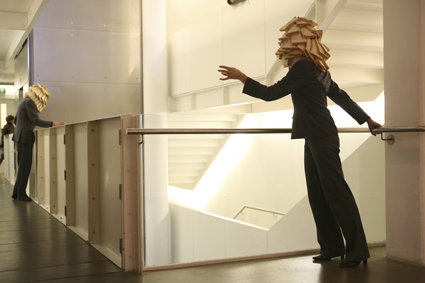
Carter & Zierle, Pearls of Sustenance
photo Carl Newland
Carter & Zierle, Pearls of Sustenance
PAUL HURLEY IS UP TO SOMETHING IN THE LIGHT STUDIO, WEARING A ZINC BUCKET ON HIS HEAD, FEELING HIS WAY WITH A SIX-FOOT STAFF, TEETERING ALONG THE BOUNDARIES OF THE ROOM IN A SAVAGE PAIR OF DANGEROUSLY HIGH GOLD STILETTOS, BLOWING THROUGH A REEDY METAL WHISTLE ON EACH EXHALE. SLOWLY. HE’S WEARING A WHITE VEST AND Y-FRONTS. I DIDN’T THINK YOUNG PEOPLE WORE THEM ANYMORE. THE FIRST FEW TURNS ROUND THE ROOM HE HAS TO PUT OUT A BLIND HAND TO GUIDE HIMSELF AS HE GETS NEAR THE WALLS.
paul hurley: untitled actuation
Near a pillar by the door there are five packets of Sainsbury’s jam doughnuts, sealed, two boxes of eggs, a packet of glitter, a newspaper, another bucket. By the second pillar are three pomegranates, a ball of string, scissors, a bottle of water, a chair with a note on it, a sack of peat. By the next pillar, another galvanized bucket, the skeleton of a parasol, a cycling helmet, a pair of red trainers, a towel, a bottle of red liquid and a packet of something I can’t see properly (it was a survival blanket). And by the last pillar, a Polaroid camera and film, four bunches of flowers in cellophane, a pair of wellies and some little bells. We must take off our shoes before entering the room and I assume this is for health & safety reasons. We shall see.
When I go in the second time Hurley’s kneeling on a sheet of newspaper cracking eggs on his head. He sprinkles glitter on himself. Looking at the dripping gold mess he’s blinking through, I think: pretty.
Sometimes it’s difficult to see all you want to of a durational piece. From the Reading Room I’d heard a tinkling of bells but was delayed. When I did get back in there were no more bells. Hurley had red paint all over his head and neck and was wearing a space blanket over his pants. Some peat had been spread on the floor in the centre. There was an imprint in it and from the dust on his vest, once he’d put it back on, you could see he’d spread out the peat and laid back in it. Smiling, he met my eyes and offered me a doughnut. And it was delicious, and JUST WHAT I WANTED—I’d had the craving since I first went in there. What had he done with the flowers, the water, the towel, the fan? Hints remained, traces on the floor and on his body.
Hurley took off the space blanket and put his vest back on and slipped back into the clumpy golden stilettos, forcing his toes right into the front of them, leaving a gap between his heels and the back of his shoes—the most uncomfortable way to wear high heels that there is. He put the bucket back on his head, started his whistling and resumed a wobbly circuit round the room, this time counter-clockwise. They do say sartorial choices imply interior states: thus, in Buffy, you have the black leather trousers of evil and the red leather trousers of moral ambiguity. Well, I guess Hurley was making his rounds on the dangerous golden stilts of altered states and inspiration: blind and extraordinarily vulnerable in his underwear.
Hearsay: he had attached the bunches of bells to his red trainers, walking round the room like an urban Morris Dancer. Hearsay: he’d held the flowers in front of the fan. Or had he planted them in the peat? Either way, he’d sought shelter under the skeletal parasol. I wonder what it was he did with the feathers? They were all over the floor in front of the fan.
What it was it with the staging posts, I wondered, the four pillars in the room—each furnished with a cache of supplies for a different stage of the journey? And was he going or coming back?
Someone who had been there at the end said Hurley had looked at him intently while tying a pomegranate to the string, attaching it to a pillar and setting it swinging. He had met Hurley’s eyes and they had looked at each other. It was a moment of extraordinary connection. He, the spectator, had gone to sit down by the wall, still observing the pomegranate. Hurley sat down beside him. They were side by side, companiable.
Someone else who had been there had had a feeling that the end of the performance was tied to the moment the fruit should stop swinging. That person watched Hurley and another spectator sit side by side observing the pendulum wind down. It was a moment of extraordinary contact.
carter & zierle: pearls of sustenance
On the Saturday of Inbetween Time you might have gone up the stairs and noticed someone lurking anxiously, holding on to a pillar on the first floor. A slender person wearing a severe grey suit—not expensive, but with a very sharp look and a self-coloured stripe. After you had noticed the tension in her posture you would have seen that on this woman’s head was a castle-like structure composed of overlapping slices of white bread, like a big summer pudding, held in place with fishing twine and invisible adhesive.
Walking on a little way you might have noticed another person in grey lurking behind the lift. Again, the anxiety in him was palpable. His posture was suffused with hesitation, with longing, with a sense of reaching out and being held back by invisible obstructions, intangible barriers; his own weakness perhaps, or a sense of fear. He also wore a bread helmet. Physically he was very like the woman. They were a matching pair, both angular and hyper-sensitive, both with a restrained, conventional look about them. Even the bread-heads added to this sense: both characters, as it were, being muffled and baffled and under wraps.
The man began to edge round the corner past the lifts. Now it was possible for spectators to view both figures at once. She seemed stuck to her pillar as though it were an anchor, the only tangible thing in her grasp apart from the sense of her partner approaching. As though she couldn’t let go of it without falling into some sort of void. He, drawn by invisible strings, moved towards her hesitantly, inch by inch, once or twice sinking to the ground under all that stress.
Both of them shed crumbs: there was a Hansel-and-Gretel trail along his route towards her, while the trace of her own presence drifted sparsely to the floor of the foyer below. The tension between them was so extreme that people kept getting drawn into it; gradually the stairwell and corridor filled with people who couldn’t look away.
At one point she held onto the rail round the pillar with the hand that was behind her back, holding her other hand to her face as though she were studying her fingernails. Under the bread helmet she looked as if she were longing to let go of the pillar, desperately shy and lost. He moved towards her hanging onto the landing rail for dear life.
The last few feet of his journey were electrifying. She yearned towards him, he drew towards her, as though in their fearful state nothing was real but their sense of the other. They touched. She finally let go of the pillar. They stood together tenderly, slowly and blindly, exploring the other. They felt each other thoroughly, hands, arms, shoulders. They stood chest to chest with their hands trapped tightly between them. They explored the bread on each other’s heads. She began to crumble the edges of his helmet, and he to reciprocate.
Very slowly each began the destruction of the other’s mask. She rolled tiny little bread pills and dropped them to the landing below, stretching her arms wide. She uncovered his mouth. He uncovered her face. She began to feed him some of the pellets her enquiring hands had fashioned. By the time I left both of them had lost enough bread to be able to see the other’s face. They stood there in their bubble of mutuality at the top of the stairs: the attrition continued.
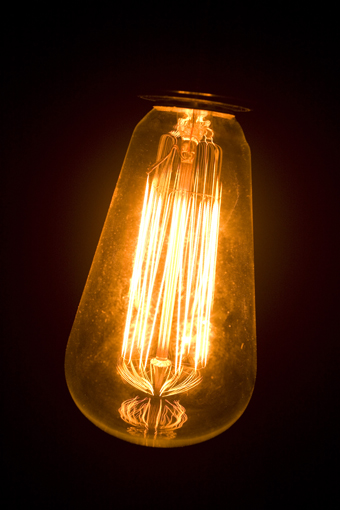
Helen Cole, Collecting Fireworks
photo Oliver Rudkin
Helen Cole, Collecting Fireworks
YOU’VE BEEN PUTTING YOURSELF ABOUT, HAVEN’T YOU? DON’T DENY IT. I’VE SEEN YOU. YOU’RE PUBLICLY AVAILABLE. YOU’RE FREE TO ANYONE WHO’LL HAVE A SLICE OF YOU.
Because it’s so easy to be everywhere. Everyone and their dog has a pocket-sized camera now. You can’t throw a rock without hitting a wireless hotspot. Most folks’ photo albums are visible to anyone who cares to do a half-arsed Google search. And maybe you don’t know it, but there you are: foreground or background, most often when you least expect it. A Flickr account of the back of your head at that gig you were at. School photographs on Friends Reunited. That really, really awful am-dram pantomime you were in? 3,647 views on YouTube, mate.
You’ll be online long after you’re dead. Cloned, copied, downloaded: it’s almost impossible to erase yourself from this ever-morphing tangle of digital connections. You can’t even make an unguarded comment at an Embassy dinner any longer without finding yourself on some sort of permanent bloody database. So there’s good and bad aspects to this whole thing. On the one hand: privacy is a myth. On the other: you will live forever. Swings and roundabouts.
Inbetween Time certainly isn’t helping you stay mortal. Because it seems this year, more than ever before, it’s focusing on YOU: your memories, instincts, personality, habitat. A plethora of works in the program contain no performance from the artist at all—instead they collect and compile. Photographer Manuel Vason is your co-conspirator in making a performance artist of yourself, creating your very own remarkable image. Blast Theory will phone you up at random, in the middle of dinner maybe, and ask you personal questions, recording your responses—which are then spliced with those of other volunteers and played back, in another city far away, to an audience of strangers. Helen Cole tends your performance memories with craftsman-like care, keeping them alive and thriving, as if each one was a rarely-blooming plant in a glasshouse.
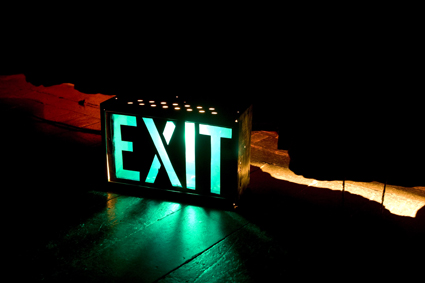
Helen Cole, Collecting Fireworks
photo Oliver Rudkin
Helen Cole, Collecting Fireworks
helen cole: collecting fireworks
Cole’s Collecting Fireworks is a long-term project that makes audio recordings of people recalling performances long gone. As an installation it’s had many different incarnations (Inbetween Time finds it at the Cube Microplex, a rickety little venue with moth-eaten curtains and creaky stage), but wherever sited it has always been a game of two halves. First of all you sit alone in a very comfy chair, the lights fade and from the dark come voices recounting tales of performances, one by one. Alongside each voice the glow of a different lightbulb breaks the gloom, some close-up, some distant, some faltering and candle-like. Once this little constellation of stories has faded you’re led to a microphone and asked if you’d like to contribute your own memory.
Collecting Fireworks isn’t an academic compilation, it’s not a taxonomy of performance—the artworks themselves are rarely named, the contributors never, and amongst the theatre and live art some of the stories concern everyday urban incidents or moments that became theatrical in retrospect. In fact, being ‘tucked in,’ nestled alongside other peoples’ stories, means that the subsequent act of making your own contribution feels natural, unforced, community-minded. There’s a strong emotional undercurrent to the recollections you hear: themes of love and death predominate, and the contributors’ anonymity suggests the confessional or the support group. Faced with the microphone, I find myself speaking in the same quiet, clear, careful tones as those I’ve just finished listening to. In such unexpected ways Collecting Fireworks grows as an artwork as well as a document, its outcomes beautifully nebulous.
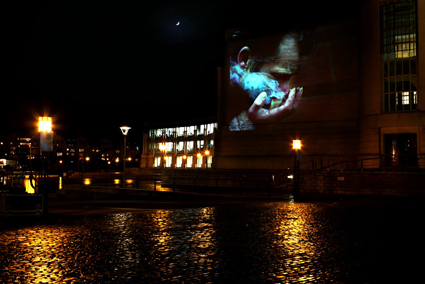
Manuel Vason, Still Moving Image
photo Manuel Vason
Manuel Vason, Still Moving Image
manuel vason: still image moving
Two other projects at IBT seem to celebrate capture, and both prove joyously life-affirming records of time and place, free-for-alls in which the inhabitants of Bristol make flesh of their thoughts: freakish, anodyne, political, fleeting or otherwise. In Still Image Moving, photographer Manuel Vason’s studio is a shipping container full of equipment that travels around the city, a sort of deluxe photo booth open to all—but the results are far from passport photographs. From the urban landscape spring tiny intimate moments and big, silly tableaux: the silhouette of a proud pregnant woman demarcated in vivid blue lights, the city in deep focus beyond; the pall of smoke from a recently lit cigarette making a lace shroud around a man’s face; figures half-buried in building sites, faces and bodies dressed in flowers and dirt, temporary monuments. Given the outlandishness of the poses most of them appear imbued with a tangible honesty, refreshingly happy. Each seems like a little song of liberation (even if, in the case of one suited gentleman blinded by his own tie and surrounded by a halo of mobile phones, they might also be a cry for help…).
back to back theatre: the democratic set
The same qualities infuse The Democratic Set by Australia’s Back To Back Theatre, a film in which anyone can appear, for 15 seconds at a time, as a camera passes from right to left in front of a room-sized wooden box. (See previous iterations of the show above and here.) The results are edited to resemble a single tracking shot along a series of different rooms inhabited by individual or group performances. Balls of wool trundle through doorways, people tumble from frame to frame, some sing at us, others gaze mournfully as we pass by. Occasionally it’s like a dream sequence in a David Lynch film, disturbing, unstoppable. Sometimes it reeks of loneliness, people going about their business in some seriously fucked-up economy hotel. But mostly it’s full of laughter and hope, a feeling very much helped by the wide demographic of its contributors. Watching it at Arnolfini with an audience principally made up of the film’s participants is particularly rewarding, hearing their whoops of recognition, because more than anything else this film isn’t a monument to the producer or director—it’s really about the lives of this strange hotel’s inhabitants and the unique document they’ve created together. It’s a living trace of them.
duncan speakman & sarah anderson: our broken voice (a subtlemob)
Another participatory artwork occurs on a chilly Saturday afternoon in Cabot Circus, Bristol’s newest shopping mall (so sparkling and clean that, for the UK, it feels vaguely dystopian). Over the last few years Duncan Speakman has been experimenting with a variation on flashmobbing, where random mass actions in public places are instigated online and by text message. Speakman’s far less self-aggrandising Subtlemob uses the same means of dissemination but adds elements of subterfuge, so that unless you’re taking part there’s a good chance you’ll be unaware of any performance—unless you notice 100 people suddenly walking in slow motion or staring up at the empty sky in unison. The downloadable MP3 of instructions is an artwork in itself: created with the musician Sarah Anderson it contains a narrative text entwined with subtle instructions to the participant, and a glacial accumulative music score that would, alone, change the entire way you look at the Brownian motion of shoppers around you.
‘You’ are an actor in these events, called Alex, or Claire (or some other name I didn’t hear and will never know). ‘You’ gear up to, and perform, a single significant action and then leave the shopping centre, left to guess at the implications. But it’s the moments of unexpected coincidence that really make an impact, the points at which everyday life and Our Broken Voice collide, apt images and happy accidents that you alone are witness to. Wisely, the artists have left plenty of time and space in which these never-to-be-repeated moments can flourish. It makes me think of the dictum used by Brian Eno to define interactive art: “The word should not be ‘interactive’. It should be ‘unfinished’.”
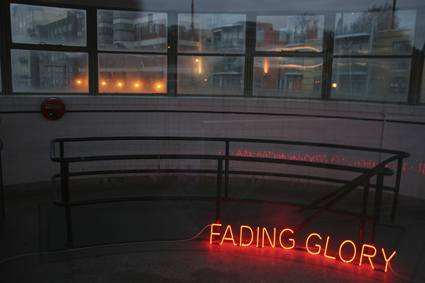
Tim Etchells, Neon Signs
photo Carl Newland
Tim Etchells, Neon Signs
tim etchells: neon signs
Past sunset, the festival over: and the phrase “YOU WILL LIVE FOREVER” is emblazoned in neon lights, occupying a vacant window space at the bottom of the Christmas Steps, a quaint higgledy-piggledy stone stairway in central Bristol. Another similar sign on the lower curve of Park Street, in between newsagents and music shops, reads “PLEASE COME BACK I AM SORRY ABOUT WHAT HAPPENED BEFORE”… and inside the harbourmaster’s lookout on Redcliffe Bridge, if you’re distracted by the blood-red flickering light within, you can peer through the mucky glass to see the legend “FADING GLORY” on the concrete floor, crackling and failing.
I cross the street, standing at a safe distance to catch people’s reactions. Each sign is on a busy pedestrian route out of the city and most people are in far too much of a hurry homeward to see the messages. But every now and then someone peels off from the flow, and at each site I see at least one camera being produced, at least one picture being taken, to end up…where? Explained how? Ever retrieved? Recalled when? Because there’s no explanatory card tacked to these artworks, nothing to declare that they’re from the Neon Signs series by Tim Etchells. Nothing, in fact, to suggest that they’re artworks at all. It’s the simplest of acts, left to human chance: if you see the sign, you decide whether to care. If you care, you decide if, and how, to remember it. Classification and demarcation aren’t allowed to get in the way of the exchange. You just take it home and deal with it. If you choose to capture “YOU WILL LIVE FOREVER and picture-message it to your loved one, subtitled “LOL” or “WTF?” or “Awwwww,” then guess what? You’re the hero. You’re the honeybee. You’re pollinating. Ubiquitous, that’s what you are.
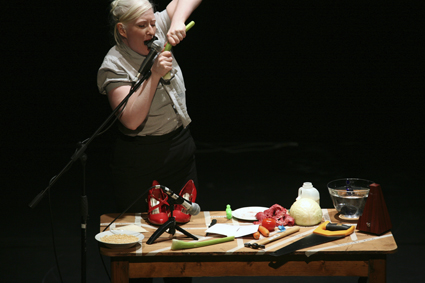
Jo Bannon, Foley
photo Carl Newland
Jo Bannon, Foley
“WHAT NEXT FOR THE BODY?” ASKS INBETWEEN TIME’S CENTRAL CURATORIAL QUESTION. TO WHICH JO BANNON ANSWERS: BONES SNAPPING, VIOLENT DROWNING AND GRISLY DEATH! (PLUS PARTY POPPERS. LOTS OF PARTY POPPERS.)
jo bannon: foley
Bannon’s Foley takes place at a table amplified by microphones and cluttered with vegetables, water bowls, metronomes and raw meat, a toolbox which the artist treats—and mistreats—to produce sound effects. Audience members are prompted to join in, providing footfalls, smatterings of applause and gunshots (hence the firecrackers). This is Bannon’s tribute to the pernickety and vaguely comic world of foley artists, where grown adults pretend to be foraging animals, a corkscrew doubles as a sonic screwdriver (true story, Doctor Who fans) and trudging through custard powder is the only thing that properly sounds like footsteps on snow.
No animals or snowdrifts here, though: Bannon’s audio landscape has an urban film noir vibe, which she narrates in deadpan received pronunciation. It’s a tale of mysterious dames and shady customers lurking in alleyways that recalls the mischievous tone of Godard’s Alphaville, generic elements peppering the storyline simply because they must; people get beaten up because, in a noir, that’s what happens. The femme is fatale because, well…what other kind is there? In Bannon’s world everything is, deliciously, at the service of the sounds. It’s also intriguing that for all of her flailing around—screaming into a bowlful of water, repeatedly slapping a slab of rump steak into the microphone—Bannon maintains a clinical detachment, a procedural poise. The artist appears to be asking us to conclude our own story, to fill in our own gaps, the sound alone is what she provides. These are the components she’s willing to give us…no more, no less.
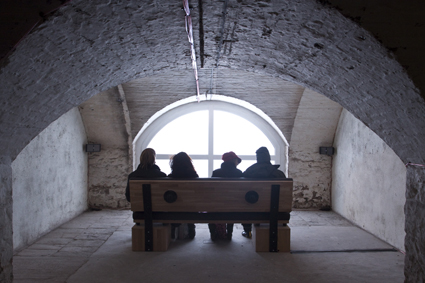
Alex Bradley, Day For Night
photo Oliver Rudkin
Alex Bradley, Day For Night
alex bradley: day for night
There are several other works at the festival distinguished by starving one or more senses so as to expand others: sparse experiences where the viewer’s own body is the catalyst, the storyteller, the conduit. In Day For Night by Alex Bradley you sit on a bench in a basement of the Colston Hall, faced with nothing but an opaque half-moon window. A surround-soundtrack of treated guitar noise (barely recognisable as such) comes and goes in long washes of frequencies both within and beyond hearing range. The sub-bass pulses occasionally send geiger counter crackles through the bench and vibrate your backside and spine in a disconcerting way. But the principle requirement is that you must watch, focusing patiently on the window as it shifts, almost imperceptibly, from bright daylight to night-time gloom—complete with projected streetlamps and car headlights peeping through the venetian blinds—and back again. It’s accumulative, a little urban tone poem that condenses the day and speaks of roadworks beyond the bedroom window, wasted hours and cold evenings hidden inside the house, spoilt for me only by the over-effusive explanations of the venue staff: “You sit here. It’s 17 minutes long. It’s a loop. You watch it go from day to night. It’s dark now but it’ll get light later. It’s about bunnies.” (Well, maybe not the last one, but you get my drift…)
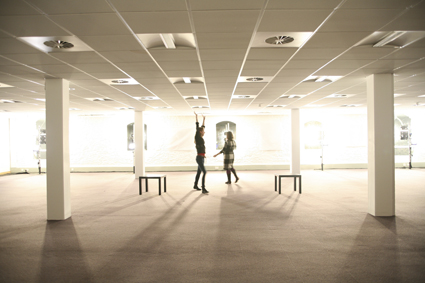
Rod Maclachlan, Exchange
photo Carl Newland
Rod Maclachlan, Exchange
rod maclachlan: exchange
Exchange by Rod Maclachlan is similarly concerned with light and dark. A pair of participants is sent into a large space wearing flexible bands around their ribcages; the rise and fall of their breathing alters the light levels in the room. In this incarnation Exchange features an impressive rig of blazing hot lights (and the angry buzz of resistors is a powerful additional presence) but the full effect suffers by not quite responding with the symbiotic speed or precision you’d hope for. Even so it’s great fun, and the lights I’m linked to project directly out of the windows on Arnolfini’s upper level, adding a pleasingly extrovert edge to the experience, announcing your respiration across Bristol’s Harbourside.
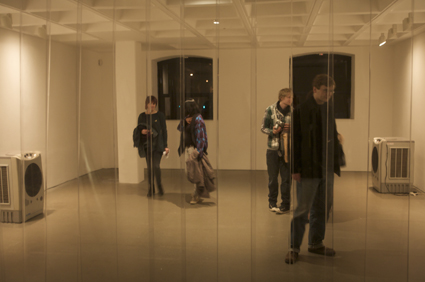
Teresa Margolles, Aire
photo Carl Newland
Teresa Margolles, Aire
teresa margolles: aire
But for me the most affecting of all these engineered, ‘heightened’ spaces is Teresa Margolles’ Aire, a room that, on first sight, looks like an empty gallery where Arnolfini staff have accidentally left two oversized humidifiers hanging around. These devices are, in fact, circulating a very particular type of water vapour around the room—a clue to its provenance lies in the ominous legend printed next to a clear plastic curtain isolating Aire from the rest of the exhibition: “THE AIR IN THIS GALLERY IS SAFE TO BREATHE” which, as a friendly reassurance, ranks right up there with “YES! OUR RESTAURANT IS NO LONGER INFECTED.”
Margolles has, in fact, infused the room with water used to wash corpses prior to autopsy at a morgue in Mexico City. It’s been disinfected, of course…but that simple information, that implication of death, hangs in the air. Now, you can approach this with disgust or reverence, or any number of fleeting feelings, and I spend a lot of time in Aire shifting from emotion to emotion. There’s so much to do in this empty room. What do you feel? You can consider the sheer number of bodies that pass through a Mexico City morgue (largely thanks to drug laws that future generations will point and laugh at, much as we point and laugh at the Elizabethans’ attempted cures for the plague) and the stories that this vapour transmits, the curtailed lives it has touched.
You can picture those bodies, en masse, standing in the room with you, blank-eyed, naked, vaguely perturbed by being asked to participate in an artwork, pissed off at not being allowed to truly rest in peace. You can imagine that you smell the queasy cleanliness of a hospital (which is ridiculous, but smell it I surely do) and recall every time you’ve hung around waiting for a friend or loved one in some green-tinted ward. You can think of the journey that liquid has taken, the unlikeliest hop from a Y-section on a Mexican corpse to the cosy middle class milieu of a Bristolian arts centre. You can fight off superstitious revulsion at the molecules fizzing in your lungs, and where they’ve been. You can breathe in and out, deep and protracted breaths, communing uselessly with the dead, because they are dead and gone, and what good can you do for them now? You can look out of the window at the dark street beyond, perfunctory mechanical traffic on a frosty West Country night, feeling what a morgue worker feels when they emerge outside on a fag break; marvelling at the tiny differences between the living and the dead. For something so simple, Aire is a truly complex thing. It’s a quantum piece of work, gloriously indeterminate—in that depending upon how you look at it, it completely changes its behaviour.
THERE’S A BIT IN BARBARELLA WHERE A SPRAWL OF STONED WOMEN SURROUND A LIQUOR-FILLED GLASS GLOBE THAT HAS A YOUNG MAN SWIMMING AROUND INSIDE OF IT. HE LOOKS A LITTLE BIT HARASSED. THE WOMEN SUCK ON HOOKAHS ISSUING FROM THE GLOBE. “WHAT ARE YOU SMOKING?” BARBARELLA ASKS, INNOCENT AS EVER. “ESSENCE OF MAN,” COMES THE REPLY.
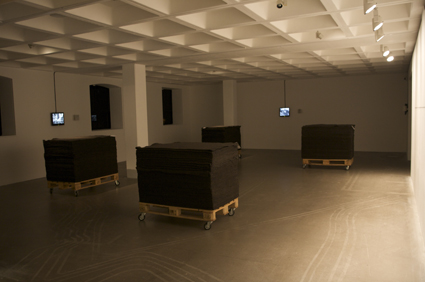
Zoran Todorovic, Warmth
photo Carl Newland
Zoran Todorovic, Warmth
zoran todorovic: warmth
I walked into the room and made a beeline for the rectangular piles of felt that looked like folded blankets. Heaped on pallets they extended upwards to just the right height for me to finger them, and to get my nose down in there. They smelt clean. Matted fibres, mostly bear-colour. Some lighter strands, some white.
I’ve noticed elsewhere that European hair-colour averages out to brown, even in Scandanavia. So the blankets default to a brindled dark mass. Mounted on the gallery wall, monochrome videos on fast-forward sum up the process of making at length. The hair is cut at the barber’s, mostly into a far-from-pretty no-frills back-and-sides. So seldom does the camera peer over the subjects’ shoulder to spy at a face in the mirror that when it happens, it comes as a shock. The backs of so many heads presenting! It’s like forming an impression of personality from the look of a person’s arse. Not that that can’t be done.
Blunt, defended scrubby heads. Utilitarian, no-nonsense settings. A couple of women are fleetingly glimpsed amongst those who do the barbering. For the rest it’s all men. In the video the shorn hair is gathered up, emptied on to tables and sorted by hand. Tissues and other detritus are picked out of it. The clumps of hair are teased and dried out in heaps on the floor and then shredded (a little) and carded in big industrial rollers, washed and felted in the steel machines. Blokes in heavy boots and overalls deployed in utilitarian structures of concrete and steel wield brooms and black bin liners under a fluorescent flicker. All the dander and the smell, the shed organic dirt that the hair must have collected is sifted out, washed off, got rid of. The blankets have been passed through an industrial process, they have been standardised and homogenised and, to a degree, purified, all obtrusively particular matter has been removed. Yet the gallery is somehow humming with essence of Bloke: hardy, gruff, obtuse, stoic.
There is no smell beyond the suggestion of a smidgeon of grease—I daresay human grease smells awful to other mammals but not to us. Just as well—I’m asthmatic, me, and have to be careful with fibres. These fibres are contained. Then I catch myself wondering what kind of garment one could make from this material, that one could bear to wear. A heavy skirt perhaps. I can picture being wrapped in this dense prickly insulating shield. For an hour or two perhaps it would not be insufferable. Perhaps.
I know that there is an ideology that determines the course of this work. I know there is a brooding, a nationalism and an exclusivity. But the de-naturing of this material, this organic remnant, renders it general. What remains is the implicit presence of hundreds and hundreds of men, their tangible residue rendered down and processed, ranked and arrayed, stacked on its pallet, ordered by the machine. The installation simulates a stack of commodities ready for some Spartan, barrack-like environment: a trading post, a quartermaster’s store.
The artist further makes use of the context of the gallery to hammer home his point about commodification: the blankets are for sale in the Arnolfini shop. Paradoxically the narrative and ideology of the work is pervaded by a seductive tenderness, the ‘warmth’ of the blankets, and by a sense of brotherhood, of community. The iconographic referencing of the major European trauma of the 20th Century, the Holocaust, I needed to have pointed out to me before I saw it, and it still jars.
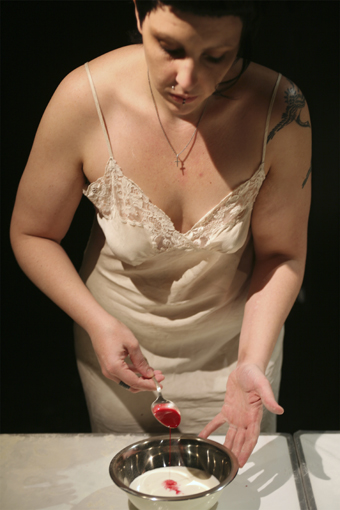
Sarah Jane Norman, Take This, For It Is My Body
photo Carl Newland
Sarah Jane Norman, Take This, For It Is My Body
sarah jane norman: take this, for it is my body
“THIS WORK DEALS WITH THE GENERATIONS OF ‘HALF-BLOOD’ ABORIGINAL CHILDREN, INCLUDING THE ARTIST’S OWN MOTHER, WHO WERE AFFECTED BY THE GOVERNMENT’S REGIME OF ‘ASSIMILATION’.” INBETWEEN TIME FESTIVAL PROGRAM.
There’s a woman in an old satin slip welcoming me into the Dark Studio. It’s the sort of thing you wear when you’re slopping about the house getting on with something that’s needed to be done for a while. A garment that used to be glamorous and is now comfortable—that you feel self-indulgent in however shabby it gets. She has bare feet. There is a wonderful smell of bread baking.
Before I came in here I had to sign a disclaimer: “Please be advised that the ingredients include the blood of the artist. Please understand that you are not obliged to eat or accept this offering. If you choose to do so this will be entirely at your own risk.”
It’s like a dare, isn’t it?
She greets me. We are on either side of a long table. There’s a small industrial oven behind us in the corner. There’s another table parallel to this one, a couple of floury baking trays on it, three or so loaves proving under a cloth. To the side against the wall is a table set for one with fine linen, plain crockery, a pat of butter and a butter knife and a napkin-covered basket. There’s an area on the floor with towels, a jug and a bucket of water, and there are black bags of supplies against another wall. It’s like a cottage production line, some kind of back-country industry the farmer’s wife fits in with her other duties. Stylistically there’s something about the combination of the efficient and the genteel that reminds me of the 50s.
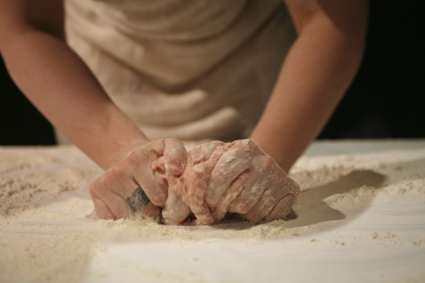
Sarah Jane Norman, Take This, For It Is My Body
photo Carl Newland
Sarah Jane Norman, Take This, For It Is My Body
There’s a large mixing bowl on the table, a sieve, small bowls of ingredients and a plate covered by another napkin, all different shades of white. The woman sieves the flour into the bowl and adds two dessert-spoons of sugar. In answer to my question she names the ingredients: “this is baking soda,” “this is buttermilk.” She lifts the napkin to reveal another dessert spoon. It contains blood, scarlet, with a darker line of clotting sunk to the bottom. So, the colours, glowing under the lights, are: white and cream ingredients, solid old-fashioned silverware, white crockery, white melamine tabletop, white linen, the woman creamy human in her creamy slip, one splash of red in the matt black surroundings of the Dark Studio.
Sarah Jane Norman pours the blood into the buttermilk and stirs. That turns it a dense pink, like Angel Delight. She pours this into the flour and mixes. The pink persists as the mixture starts clumping, darker material from the clot streaking through the dough. Amazing that such a small amount of blood has such a strong effect. She turns out the dough, kneading it, shaping it, slashing a cross into the top. She takes it to the next table to sit and prove with the other loaves (which show that definite tinge of pink as if they were special party bread). She goes to wash her hands in the bucket over by the towels.
The oven pings—the loaf that was put there before I entered the room is ready. Norman places it to cool by the proving loaves.
She invites me to sit at the place laid for one. Lifting the napkin from the basket she uncovers a rough, warm loaf, no longer pink. She cuts me a good slice, making eye contact all the time. It’s crusty, slightly bitter—that could be the baking soda—a bit heavy. I help myself to butter. If I’d tried to eat a whole slice we’d have been there for ages.
Succinct, earthy, confrontational, full of confidence, giving. Personal, not industrial, locating the political in the heart of family and domestic life, where it can do the most damage. About survival, not victimhood. Two very contrasting approaches to discourse about ethnicity and the threat of genocide.
Inbetween Time Festival of Live Art and Intrigue, Zoran Todorovic, Warmth, Arnolfini, Dec 1-Feb 6; Sarah Jane Norman, Take This, For It Is My Body, Arnolifini Dark Studio, Dec 4; Dec 1-5, Bristol UK
Our coverage of the 2010 Inbetween Time Festival is a joint venture between RealTime and Inbetween Time Productions
RealTime issue #101 Feb-March 2011 pg. 24, web
© Osunwunmi ; for permission to reproduce apply to realtime@realtimearts.net
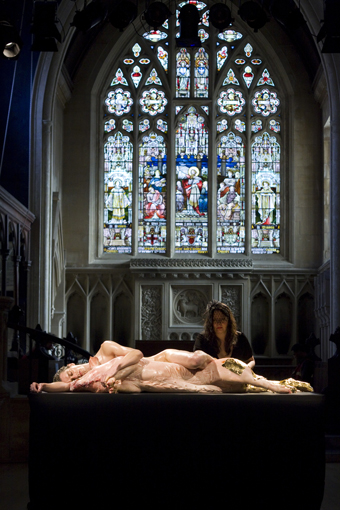
Hancok and Kelly Live, Iconographia
photo Oliver Rudkin
Hancok and Kelly Live, Iconographia
THE CIRCOMEDIA BUILDING USED TO BE A GEORGIAN CHURCH, NOW RE-PURPOSED FOR AN ARTFORM IN WHICH TRANSCENDENCE OF THE PHYSICALLY MUNDANE IS A DOMINANT THEME. THE CIRCUS SCHOOL HANGS THE TRAPEZE HIGH UP IN THE CEILING ARCHES, WHICH HAVE PLENTY OF ROOM BELOW THEM FOR THE SAFETY NET. ALONG WITH THE ARCHES THEY HAVE KEPT SOME OF THE PEWS, A GALLERY AND A FEATURE STAINED GLASS WINDOW. THE SPARE BATH STONE INTERIOR IS SOFTENED BY A SPRUNG WOODEN FLOOR IN THE MAIN PERFORMANCE AREA.
hancock & kelly live: iconographia
It was here that Richard Hancock lay on a plinth, at the height of a kitchen worktop, spooning a dead pig. The pig was already in rigor with his legs stretched out, a slight twist cocking his body askew. The man and the pig were the same colour.
Traci Kelly stalked round him purposefully. She was dressed in a black ball gown, a black pillbox hat with a small veil over her eyes, black gloves. Her tools were a block of gold leaf, a folded card to tweezer up each leaf, and a large soft brush, like a make-up brush, to fix and burnish. She would pick up a square of gold leaf delicately, angling it in the breeze of its own movement to minimise creasing and doubling, lay it on one of the bodies and smooth it down with the brush.
By the time I got there, one hour in, the feet and hindquarters of both bodies were covered, and Kelly was moving to the front of the hybrid to pay attention to hips and ribs. Music played: Dido’s Lament from Purcell’s Dido & Aeneas. Shreds of gold leaf escaped from the block, from under the brush, from the bodies, fluttering to the floor round the plinth or sticking to the black gloves and having to be scraped off. Where gold leaf sealed the gap between bodies it kept breaking down and having to be replaced. I kept wanting the process of gilding to be perfect. It stubbornly continued to be messy, very far from perfect.
Hancock held the pig tenderly, one hand resting on its chest between its front trotters. Its legs lay between his and he rested one knee insecurely on its narrow hip. It was a young pig, and thus about one third the man’s size. At all times the combination of genuine gold and glitter, of bourgeois formality (the hat, the gloves, the heels), of the representation of high culture, Purcell, to guarantee the seriousness of the occasion, threatened to topple over into vulgarity. Which is indeed the case at all our most solemn social rituals, weddings and funerals, where the popular, the profane and the high-minded collide.
The man was breathing, the pig was stiff. Both were sinewy and heavily greased with Vaseline. The gold around their nether regions caught the light in a more sparkly, less dense way than did their glowing naked orange-tan-pink skins. The pig had a bruise on its forward ham. The man did not. The man trembled with the cold, or the strain of holding the pose, or because all warmth was being leached out of him into the block of dead meat he cradled.
I had been told the pig still had the grass of its previous happy existence between its toes; I walked round to scrutinise. The long cut that had gutted it formed a tightly sewn, corded seam up the length of its body. Its tongue protruded between its teeth, curving up towards its snout. Smears of blood had been mostly wiped away, leaving only traces under the layer of Vaseline. It was clean. Its eyes were half open—it seemed to be looking up. Hancock lay with his own face directed towards it. He would meet its eyes if he opened his own. Then he did so: they were blue, the same colour as the pig’s. There the two were, in affinity.
At this point I surprised myself—for I don’t have that culturally specific Western sympathy for livestock—by feeling sorry for the pig. Then I felt the ways in which Hancock stood for the pig, and the pig for him, and both of them for all of us, tied to a hunk of dead meat and an inevitable end. The realisation was awful. I had to retreat. I went and sat up in the gallery where all that could reach me was the spectacle. I felt like howling.
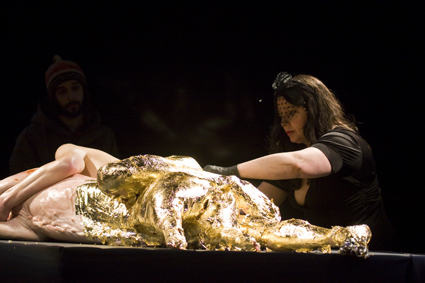
Hancock and Kelly Live, Iconographia
photo Oliver Rudkin
Hancock and Kelly Live, Iconographia
Although I can recall it to memory it was not a repeatable moment, since it was triggered by physical presence. Occasionally I went down to stand in the same place and feel the same thing, drawn by the intensity of it—we don’t face such raw perception very often. Kelly inexorably and gently covered the intertwined bodies, stroking and burnishing as she obliterated them with splendour. Hancock breathed, and trembled under her touch. The music broke down and destabilised with every repetition, imperceptibly; yet by the end it seemed a distorted, reverberating howling played on a disintegrating instrument. The tension as Kelly moved the gold leaf closer and closer to the two faces was painful, yet when it happened, the end was not so dramatic. She smoothed the last gold square over the diamond-shaped fragment of face that remained of Hancock. Then she took care to remove pieces of golden film from within his nostrils. Pig and man now were covered, grafted together, shiny and perfectly inert. Kelly left the area.
More people had come into the church and become slowly rapt, standing closer to the plinth, drawn towards it, fascinated. The golden object, the glittering remnant, was to remain displayed for another half-hour. But I left, not caring to watch Richard Hancock shiver for that length of time. While Kelly was there, she was responsible for the work. But once she had left, audience complicity came into play to give us all control of the spectacle.
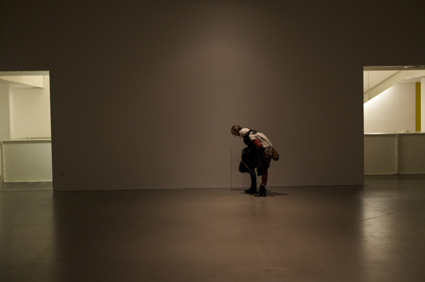
Teresa Margolles, 37 Cuerpos
photo Carl Newland
Teresa Margolles, 37 Cuerpos
teresa margolles: 37 cuerpos
It seems logical to me to compare Iconographia to Teresa Margolles’ work, not least because the spectacular aesthetic in which Iconographia wallows is so at odds with the minimalist aesthetic of Margolles.
In 37 Cuerpos a gallery space is bisected by a thread running from wall to wall. It is a little below waist height. The room has four entrances/exits, a pair on each side of the cord, at right angles to it, and an adjacent pair in one of the walls to which the cord is fixed, opening into a corridor. The lighting is subdued and the gallery’s plainness underlines the clinical air of the installation.
Closer inspection of the thread reveals details. It is composed of many lengths of a waxy, cat gut-like material knotted together. The sections vary in the degree of blemish they have picked up: rust-coloured, grimy-looking stains. The knots are angular, giving the thing a look of organic barbed wire. The program notes explain each length was used to sew up a body after autopsy. A couple of lengths are heavily stained indeed: that person’s end must have been grisly.
Nobody who ventures into this room steps over the thread to get to the adjoining gallery, although it would be easy to do so. Instead they walk down the line to where the two doors open into the corridor; exit from one, take two paces and re-enter from the other. Then they walk up the line again.

Teresa Margolles, Aire
photo Carl Newland
Teresa Margolles, Aire
teresa margolles: aire
In Aire, Margolles’ work in the adjoining gallery, disinfected water collected from the washing of bodies humidifies a room. Those who walk there breathe it in and feel it cooling on their skin. I got to the entrance, hung with a heavy plastic strip door, where I caught a hint of pleasant coolness, as enticing for someone from the tropics as the smell of fresh bread baking. I noticed the industrial humidifier on the floor. I did not go in.
It is the spectators’ responsibility to pay attention, to leave themselves open to engage with the work. That may be all that is required, or they may be challenged by the artist to be complicit in what takes place; or they may be placed in a compromising position without their consent. However, in offering attention, the spectator also claims the freedom to refuse to take part. Once the artist asks for engagement they must also be ready for and accept refusal. Otherwise the quality of the encounter they have arranged is in question (what is real and what is not is always an issue in live work): their request is a sham, an underhand attempt to force a result using the contextual authority of the gallery.
Something more interesting is going on with Margolles, who uses not only the authority of the gallery but the entire machinery of prestige and commodification driving international high culture to draw attention to real lives and deaths in Mexico. As a conscientious spectator I could accept complicity, but I don’t: I am not part of that high culture machinery and I don’t think InBetween Time is either. Nothing could compromise me more in this situation than pretending to be so sophisticated that the idea of touching the paraphernalia of death doesn’t horrify me. A value system is being critiqued here, among other things: my naive reaction acknowledges horror at the base of it.
Inbetween Time Festival of Live Art and Intrigue, Hancock & Kelly Live, Iconographia, Circomedia, Dec 5; Teresa Margolles, 37 Cuerpos and Aire, Arnolfini, Dec 1-Feb 6; Dec 1-5, Bristol UK
Our coverage of the 2010 Inbetween Time Festival is a joint venture between RealTime and Inbetween Time Productions
RealTime issue #101 Feb-March 2011 pg. 24, web
© Osunwunmi ; for permission to reproduce apply to realtime@realtimearts.net
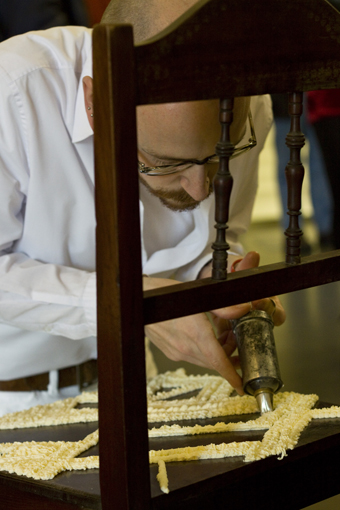
Pete Barrett, The Surety, The Surety (The Inner Surety)
photo Oliver Rudkin
Pete Barrett, The Surety, The Surety (The Inner Surety)
“THE REASON OF THE UNREASON WITH WHICH MY REASON IS AFFLICTED SO WEAKENS MY REASON THAT WITH REASON I MURMUR AT YOUR BEAUTY.” CERVANTES, DON QUIXOTE
I’ve often thought of Live Art as having properly Quixotic aspects to it: foolhardy, sometimes nonsensical quests, undertaken in the face of scorn; easily mocked; often more moving and possessed of less selfish egotism, than might first appear. In Arnolfini’s foyer, an impeccably attired Pete Barrett decorates a wooden chair with tiny florets of cake icing, a beautiful, sedate action with strange, wordless inner logic. Many onlookers scowl with incredulity, some shrug…but it’s the kids who understand him best. They toddle up close to stand quiet and respectful at Barrett’s shoulder, as he lays concentric triangles of sugary paste across the dark wood.
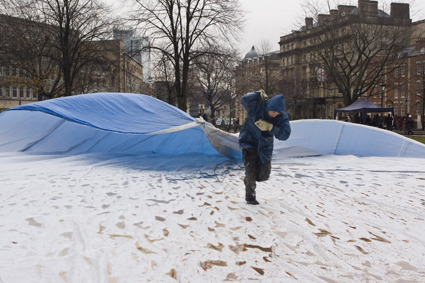
Cupola Bobber, Wave Machine #2
photo Oliver Rudkin
Cupola Bobber, Wave Machine #2
For Wave Machine #2, US duo Cupola Bobber spend the cold afternoon in the shadow of Bristol Cathedral, attempting to replicate the swell of an ocean wave using pulleys and white/blue tarpaulins, repeatedly, back and forth, no-nonsense—because that’s what they do. For Black Box Ni, Paul Granjon has built an independently functioning robot that is able to control its maker via an interactive costume, compelling the artist to perform random repetitive tasks and—in one hilarious sequence—firing high-velocity paintballs at Granjon whilst he tries to construct a jam sandwich.
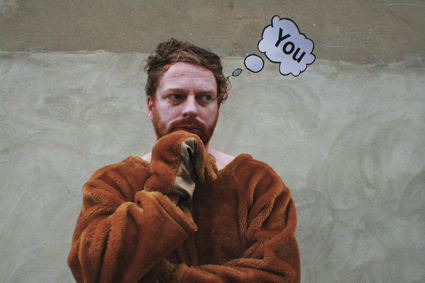
Kim Noble
kim noble: kim noble will die
But there’s a darker side to Quixotic desire that even some of Inbetween Time’s audience might have problems with. Because generally, we prefer the safer madness, don’t we? The zany madness, the village idiot madness. Madness with boundaries and recognised borders. One 2009 review of Kim Noble Will Die protested, “Even for a show about going too far, he goes too far,” and that’s because Noble’s masterpiece is an uncomplacent, confrontational, no holds barred, side-splittingly funny and unbearably upsetting portrait of a mental condition, the bipolar monster that has been cruelly toying with him, on and off, for much of his life.
Noble has censored so little of himself (and been equally indiscriminate with the lives of his family, ex-girlfriends, and neighbours) that you leave the show feeling beaten up, elated, angry and honoured, all at once. You wonder what percentage of it was ‘true,’ and then you question how much (if at all) that knowledge would matter. Because even if Noble is fucking with our minds (he didn’t really ejaculate into that bottle of Vagisil and leave it on the supermarket shelf, did he?) the image would hold fast, the portrait of the artist would remain the same. Even if this were embellished rather than pure autobiography, the journey would feature the same remarkable peaks and troughs, in relating Noble’s struggle to find meaning in a world that, to him, looks increasingly barren.
The show is a high speed stream-of-consciousness audiovisual presentation cramming 10 hours of material into 60 minutes. Karaoke rock is sung to repeated close-ups of Noble’s ejaculating penis. Horrendously intimate phone calls bleed from the speakers. Members of the audience are banished from the room at random. Some poor ticket-holder sits with a bucket on his head for the full hour. There’s a genuine cameo by a world-famous Hollywood star. There’s product tampering, unhinged email exchanges, cash handouts and graphic, profoundly disturbing self-harm. It mugs you. Past audiences have actually reported this show to the police. It is, no doubt whatsoever, exploitative of artist, audience and innocents alike (but in its awful honesty, what else could it be?) and—it must be noted—it is very, very male.
This last factor seems to feature heavily in people’s responses to Noble’s work. Audiences keen on Live Art’s capacity to navigate uncharted territory sometimes baulk at being asked to care about problems of white middle class blokes with Macbooks. Maleness is often seen as conservative, the predominant power structure, the mainstream; as a result a full exploration of masculine motifs and issues is a relatively rare thing to see on this circuit, and to witness Noble taking it to extremes (sometimes horrible, misogynistic extremes) will go not only beyond empathy for some, beyond risk, but also beyond acceptability. I wasn’t sure what to think. I’m still, after several days, not sure. All I know is that, on and off, I’ll be thinking about this show until my tiny light sputters.
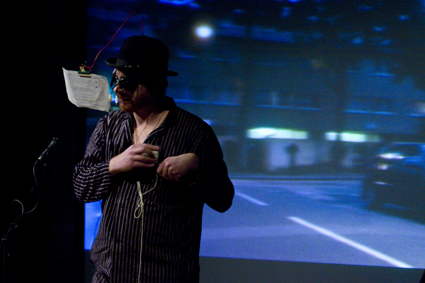
Kim Noble, You Are Not Alone
photo Oliver Rudkin
Kim Noble, You Are Not Alone
kim noble: you are not alone
In Kim Noble Will Die the artist is a pot-bellied silverback gorilla of a man, a dominant presence pacing back and forth who, you suspect, it’s best not to look in the eye for fear of reprisal. He’s grim and glowering, not smiling once. He’s similarly unsmiling throughout You Are Not Alone, his second show of the festival, until a fleeting moment late in proceedings. During a film of him presenting a ‘Kim Noble Award’ to his favourite takeaway restaurant, while shaking the bemused owner’s hand, a genuine sliver of a smile creeps onto his face. And it’s heartbreaking, a release—especially if you’ve sat through both shows. It feels like a tiny reward.
Kim Noble Will Die is riven with humiliation, failure and madness. You Are Not Alone is at the other Quixotic extreme, with its comic levels of altruism, its cranky hope, its unstoppable quest. The ‘ghost’ of Noble’s ex-girlfriend haunts the stage, a printed photograph on A4 paper projected via a glitchy webcam rigged to Noble’s head. The story begins as she departs in a taxi, their relationship ended at that very moment, and Noble decides to make sense of events by making his loneliness a weapon of empathy. Neighbours on the London street where he lives form a venn diagram of opportunities, and addressing their problems without complaint—often covertly and without reward—becomes a way of making the world better.
As you’d expect, this Knight Of The Woeful Countenance has particularly idiosyncratic solutions for stolen plant pots or a takeaway restaurant’s lack of business, his neighbour’s depleted sex life or the isolation of modern urban existence. He offers to deliver onion bhajis to anywhere in the UK, if only we’ll order them (phone numbers are provided). He ropes his audience into making appreciative phone calls about taxi journeys that never happened. He randomly twins his street with one in Eastern Europe (and journeys there to announce it, to friendly bemusement). One night he cleans every car parked on the road, dressed as a cartoon bear.
It’s still shot through with the usual Kim Noble queasiness—especially as determining his neighbour’s ‘problems’ requires him to engage in almost obsessive electronic surveillance. But he’s a different character tonight: barely speaking, letting a computerised voice narrate the quest, a man at the service of something beyond himself. Taken together the ultimate effect of these two amazing shows is, for me, the same as in Cervantes. You desperately hope that Kim Noble will one day conquer his afflictions. But at the same time the ludicrous, surreal beauty of his battle both repels and enchants you.
Inbetween Time Festival of Live Art and Intrigue, Pete Barrett, The Surety, The Surety (The Inner Surety), Arnolfini, Dec 5; Cupola Bobber, Wave Machine #2, various locations, Dec 2-5; Paul Granjon, Black Box Ni, Wickham Theatre, Dec 5; Kim Noble, Kim Noble Will Die, Arnolfini, Dec 4; Kim Noble, You Are Not Alone, Circomedia, Dec 5; Bristol, UK, Dec 1-5
Our coverage of the 2010 Inbetween Time Festival is a joint venture between RealTime and Inbetween Time Productions
RealTime issue #101 Feb-March 2011 pg. 23, web
© Timothy X Atack; for permission to reproduce apply to realtime@realtimearts.net
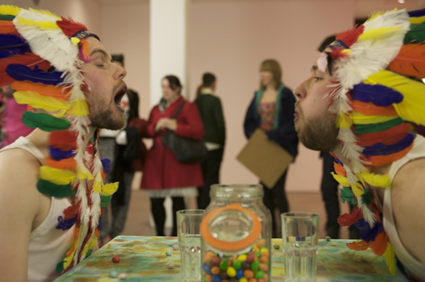
Jones and Llyr, A Mouthful of Feathers
photo Carl Newland
Jones and Llyr, A Mouthful of Feathers
AMONG THE THRONG OF WINE-GLASS CLUTCHING AFICIONADOS AT INBETWEEN TIME’S LAUNCH PARTY, TWO SLIGHT YOUNG MEN SIT OPPOSITE EACH OTHER AT A TABLE, DRESSED AS PLAYTIME RED INDIANS: WHITE VESTS, SHORTS, AND CROWNS OF PRIMARY COLOURED FEATHERS. A GLASS JAR OF PEANUT M&MS (COLOURS CORRESPONDING WITH THEIR FEATHERS) SITS BETWEEN JONES AND LLYR, AND IN TURNS THEY SUCK, CHEW AND SPIT OUT THE SWEETS, FACING EACH OTHER DIRECTLY, THEIR GAZE SOMETIMES A CHALLENGE, SOMETIMES AN INVITATION, BUT ALWAYS A JOINT ENTERPRISE.
They drool residue onto the white table, making a gloopy multi-coloured patina. Occasionally they attempt to spit confectionery from one mouth to another; failed launches are met with wry smiles. This silent flirting with revulsions and bodily etiquette is youthful and funny—but at the same time suggests a strange entropy, dissipation and doubt. As the evening grows older, discarded chocolates scatter across the Arnolfini floor, as if the performance has a radiation, a half-life, particles falling away like petals from a flower.
The push-me-pull-you of partnerships is explored by several other performing duos at Inbetween Time, in forms that vary from fragile, stately propositions to noisy creative-destructive acts to sheer animal glee.
search party: somehow growing old with you
The fragile and stately first: Search Party are real-life couple Jodie Hawkes and Pete Phillips who we learn met in their 20s. Their show is a love letter to each other, but…wait, no, come back! Somehow Growing Old With You manages to circumnavigate the cloying neediness of a bad wedding ode. It doesn’t feel like a renewal of vows, though that’s essentially what it is: a ceremony, a statement of intent, occasionally demanding the patience you’d give such a thing. But its glacial pace and quiet repetition proves meditative, its moments of emotional beauty dotted about an arid landscape of salt and smoke.
Phillips and Hawkes slow-dance across a carpet of salt that crunches beneath their feet like glass. They walk forward, Hawkes having some sort of unspoken problem with reaching a certain distance, Phillips carrying her to the threshold in a variety of ways, each time failing to convince her to stay. They hold private conversations in inaudible whispers, discussing what to do next, checking their progress with each other in gazes, glances, frowns and smiles. Eventually, they each record a message to camcorder for the future, telling the story of how they met, of how their daughter was born. This is the start of a process wherein Search Party will record such messages every 10 years, for as long as they’re together, or until they’re no longer able to. The inevitability of human decay hangs heavy in the room, announced and committed to tape…but Search Party are carrying that knowledge, that destiny, together. I once heard the artist Franko B wonder at how audiences rarely have a problem with the sharing of pain, but no sooner does an artwork express overt sentimentality than its integrity is doubted. True love is sometimes a dirty secret in live art. This show, unashamedly, reeks of it.
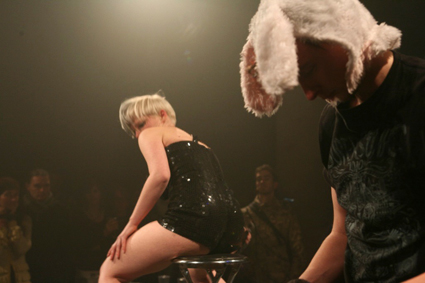
Action Hero, Frontman
photo Carl Newland
Action Hero, Frontman
action hero: frontman
Smoke is also filling the room at Circomedia, but this time it’s rock gig smoke, drifting over a raised stage and guitar amplifiers, shot through by spotlights. Action Hero are premiering Frontman, their lament for the egos of petulant musicians throughout the ages. Previously Gemma Paintin and James Stenhouse have appropriated and assimilated texts from westerns and daredevil spectaculars with a style that sees them rope the audience into the proceedings—shooting down the hero in a hail of imaginary bullets, cheering the motorcycle jump or going silent when the stranger walks into the room. Tonight is slightly different; no less urgent, but another kind of energy, because it centres upon what happens when the contract between audience and performer falters or fails. Paintin holds court in spangled hot pants, making her way through various on-stage crises: hubristic, chaotic, physically destructive, confrontational. It’s a catalogue of ineloquence made either comic or distressing by its amplification. Then, when she finally gives up the ghost and crumples, hands over her ears, the soundtrack takes over, eliminating her, a wall of intense electronic scree with frequencies so violent we reach for the earplugs we’ve been handed before the show begins.
Stenhouse is also on stage throughout, a gangly roadie in rabbit ears, operating technical equipment, untangling cables in a hilariously slow and straight-faced manner. He’s heckled by Paintin and they physically fight on stage. She hides in the shadows and accuses him of ruining everything. It’s exhausting, and you feel for the performers, Paintin especially. Action Hero themselves are a company in the spotlight, their shows the subject of great acclaim. You wonder how much this show is actually about the artists, about their mercurial creative processes, their negotiations, cul-de-sacs and unpredictable life force.
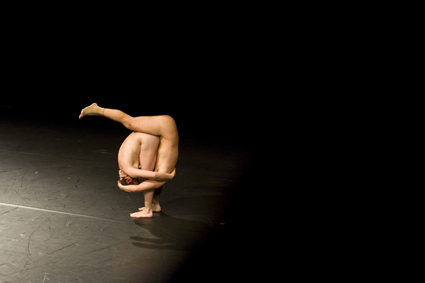
Pieter Ampe and Guilherme Garrido/CAMPO
photo Oliver Rudkin
Pieter Ampe and Guilherme Garrido/CAMPO
pieter ampe and guilherme garrido/campo: still standing you
And speaking of untameable life forces: the audience for Still Standing You is assembling. It’s 11am. Guilherme Garrido is on stage, precariously seated on an impromptu stool made of his colleague Pieter Ampe’s legs. Ampe’s back is flat on the ground. He seems stoic about the situation. “We’re just waiting for a few more people to come in,” says Garrido, “Then we can begin this breakfast buffet of contemporary European dance.” And my god, I haven’t been this excited by a dance work in years.
I’d love to be able to describe Ampe and Garrido’s performance in intricate technical detail but I’m afraid I watched much of it through gasps, stifled giggles and tears of happy laughter. There’s no music, no set, nothing on the well-lit stage bar our odd couple: Garrido a swarthy Portuguese chatterer; Ampe a wiry, wordless, ginger-haired mega-bearded Belgian. The show is about them working out what they ‘mean’ to each other, and what this means for us is an extraordinary celebration of all the stupid, joyful, hilarious, loud and unlikely things that two human bodies can do to, at, for and with each other in one hour. Ampe and Garrido hurl one another around wrestler-style, make human climbing frames of themselves, play dangerous games of physical one-upmanship, snarling throughout in ridiculous thrash metal vocalisations, gurning, spitting and croaking. Then they finally rip each other’s clothes off, flapping nude about the stage like distressed fish, yanking at each other’s penises as if they were plasticine and locking around and upon one another to make half-men forms, strange animals with human skin, a being made entirely of legs, Siamese dancers, noisy molluscs.
Easily my favourite experience at Inbetween Time, it’s almost easier to describe what Still Standing You wasn’t than what it was. For a show with explicit nudity it wasn’t remotely sexual—despite, for instance, a moment where Ampe opened up Garrido’s foreskin and screamed into it from the top of his lungs. Yep. Read that again. That’s right. It didn’t feel like a masculine initiation rite, because it was so personal to the two individuals before us, rather than existing in a specific cultural place and time. And it wasn’t random and unfocused, because the dance proceeded from one crazy move to the next with a logic that carried the audience with it, making us laugh or wince in anticipation. What it was, at heart, is best expressed by paraphrasing the late great Pina Bausch: not interested in how these two people move, but in what makes them move.
Inbetween Time Festival of Live Art and Intrigue: Jones and Llyr, A Mouthful Of Feathers, Arnolfini, Dec 1; Search Party, Growing Old With You, Wickham Theatre, Dec 2; Action Hero, Frontman, Circomedia, Dec 4; Pieter Ampe and Guilherme Garrido/CAMPO, Still Standing You, Arnolfini, Dec 2; Bristol UK, Dec 1-5
Our coverage of the 2010 Inbetween Time Festival is a joint venture between RealTime and Inbetween Time Productions
RealTime issue #101 Feb-March 2011 pg. 22, web
© Timothy X Atack; for permission to reproduce apply to realtime@realtimearts.net
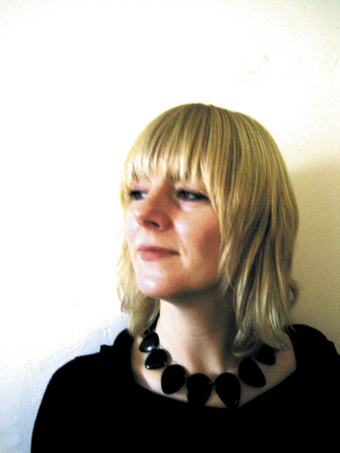
Helen Cole
photo Jamie Woodley
Helen Cole
“A FESTIVAL IS AS PRECARIOUS AS ANY ARTWORK,” HELEN COLE, PRODUCER AND CURATOR OF THE UK’S BIENNIAL INBETWEEN TIME FESTIVAL OF LIVE ART AND INTRIGUE IS TELLING ME. “YOU NEVER KNOW WHAT IS GOING TO HAPPEN TILL YOU ADD THE AUDIENCE. YOU’VE WORKED HARD TO CREATE THE OVERALL SHAPE AND THE JOURNEY THROUGH THE WORKS, BUT YOU HAVE TO BE MET HALF-WAY BY YOUR AUDIENCE, YOUR CO-WORKERS, THE ARTISTS IN YOUR COMMUNITY.”
Cole’s concern for chemistry characterises Inbetween Time (IBT), a festival where the parties and pauses for conversation and exchange are as carefully configured as the performances. I attended the festival in its early days and was captivated by the sense of community generated by Cole around an esoteric and little known new festival in the small city of Bristol. Artists I had never heard of were mingling cheerfully with their better-known peers and international presenters in the Arnolfini gallery’s cosy bar. The work was carefully contextualised to accommodate emerging and established practice and make the five-day event feel like a singular, intense immersion into a range of practices anchored in the body.
Since 2001, the festival has grown in scale and profile and several of those emerging artists have similarly acquired international repute. Cole acknowledges that the 2010 festival is her most ambitious to date, with new venues added to the central Arnolfini gallery and performance spaces as well as an extensive sited program in public spaces. Now independently produced, IBT is a partnership with Arnolfini, where Cole was the Producer of Live Art and Dance for 12 years. With the majority of its funding for three years coming from the Paul Hamlyn Foundation, IBT is in a relatively robust position amidst the devastation wrought by diminished arts funding in the UK.
“It was hard to celebrate this year,” says Cole, “knowing about the challenges facing the arts sector. Not to mention the snow!” Images from the festival, of which there are many on the websites documenting IBT, show panels of rugged-up presenters, artists and audiences engaged in joyful defiance of the weather. “There was a true spirit of the Blitz,” says Cole, “we were all in it together. The usual eccentric moments were magnified.”
highlights & new parameters
Cole cites several highlights in the 75 productions in her program, speaking with great enthusiasm of Frontman by Action Hero, the local group who have been garnering significant attention nationally and were facing that difficult hurdle of recreating the impact of their breakthrough work. In a new partnership with Circomedia, the Bristol based circus development organisation, IBT programmed Action Hero’s new work in a large church, creating an incongruous gig-like feel with dry ice and pumping sound. Cole rates the success of this satisfying production as highly as she does the extremely uncomfortable two works presented by British comedian, Kim Noble. “Kim pushed all the edges,” says Cole, “crossing from the intensely private into the public and making everyone cringe.” There was another cringing highlight for Cole in the Belgian production, Still Standing You by Pieter Ampe and Guilherme Garrido from CAMPO. Presented as part of the Lecturama mid-morning program, this confrontingly visceral grappling dance between two big blokes had everyone wincing over their coffees.
The CAMPO production is testimony to the longevity of the relationships Cole holds with peer producers in Europe. Kristof Blom, CAMPO’s producer, joined Nayse Lopes of Panorama Festival in Rio de Janeiro and Fiona Winning from Australia on an International Curators’ Panel about the modus operandi he shares with Cole: his recommendation gave her the confidence to program Still Standing You from video alone.
This unlikely dance work demonstrates that IBT is about more than live art. The festival’s brochure explicitly states that its D:Stable strand comprises “new artist commissions, premières and international co-productions that thoroughly reject theatre convention.” New experimental works by such celebrated names as Blast Theory, Ivana Muller, Quarantine and Tim Etchells stand alongside home grown premieres from Timothy X Atack and Tanuja Amarasuriya, Alex Bradley or Cole’s own production, Collecting Fireworks.
There is a through line of exploration that unites the broad diversity of the program and creates that sense of communal adventure that resonates throughout the experience of attending IBT. Cole says, “I am curating conceptually and choosing work that makes sense in a program. I want audiences to consider not just these works, but a body of work and a conversation with an artist that is as much about where they are as where they are going next.”

Sarah Jane Norman, Take This, For It Is My Body
photo Carl Newland
Sarah Jane Norman, Take This, For It Is My Body
the australian connection
Three Australian works in IBT10 reflected Cole’s lengthy engagement with Australian contemporary performance. She first visited Performance Space in Sydney in 2000, striking up a relationship with then director Fiona Winning that resulted in a number of Australian artists appearing at IBT 2006. In 2010 Winning herself and Victoria Hunt appeared in Dancing the Dead in the program strand connected to the Arnolfini exhibition, What Next for the Body.
“This work surprised me with how well it was received,“ says Cole, “given how little we know of that culture [Hunt’s Maori heritage is explored in conversation and dance]. Fiona and Victoria found a way of talking about the making of new work in front of people who do not know either of them, or the themes of the work, and held it all together. This sort of exploratory conversation really works in IBT.”
Another Performance Space connection led to the programming of Take This, For It Is My Body by Sarah Jane Norman, also in Arnolfini. “This one-on-one work was very simple,” says Cole. “I am not sure how much the audience could access the references to Australian Aboriginal culture, but they clearly understood the conceptual significance of Sarah Jane’s mixing of her blood into the bread and were challenged by her offer to consume it.” Cole saw Norman at Sydney’s PACT around 2004 and followed her trajectory through the creation of her independent work in Australia and then internationally. “We have been in conversation for several years,” she says.
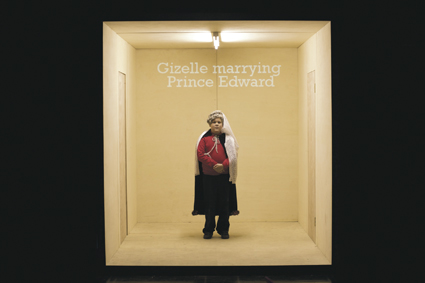
Back to Back, The Democratic Set
A more recent conversation, and one that seems at first glance to be less likely, is Cole’s commission for Geelong-based Back to Back Theatre. “Despite our very different aesthetic tastes, we share the same commitment to building community around our work,” Cole says. “I learned an awful lot from having them make The Democratic Set with us over 10 days in Bristol. It is very politically current to work with diverse communities and make participatory work, but this is something different. They have such a light touch and such clear curatorial thinking. The relationships they built so quickly with our community were staggering. They worked with over 100 people without blinking. The project is so simple, so elegant and so heart-warming. There was a frenzy of about 400 people trying to get into the gala premiere screening. I am sure this is just the beginning for us. Back to Back have a community in Bristol now; people who have given something of themselves to the company and have started a relationship with them. Bruce [Gladwin, Back to Back’s director], an artist from the other side of the world, spoke at our opening event and it just felt right. Sometimes you find yourself on the other side of the world and you are at home.”
The number and diversity of artists who find themselves at home in Bristol is increasing year by year as Cole continues to pitch her close knit community of local artists further and deeper into the international context.
Inbetween Time Festival of Live Art & Intrigue, Bristol, UK, Dec 1-5, www.inbetweentime.co.uk
Our coverage of the 2010 Inbetween Time Festival is a joint venture between RealTime and Inbetween Time Productions
RealTime issue #101 Feb-March 2011 pg. 21, web
© Sophie Travers; for permission to reproduce apply to realtime@realtimearts.net
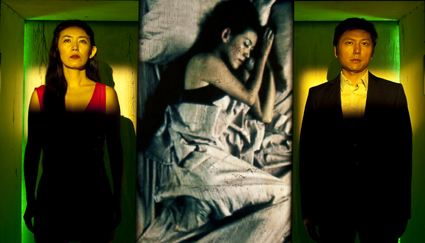
Temporary Distortion, Americana Kamikaze
photo courtesy the artists and Brisbane Powerhouse
Temporary Distortion, Americana Kamikaze
THE DISCRETE CHARM OF ANDREW ROSS, DIRECTOR OF THE BRISBANE POWERHOUSE, LIES IN HIS WARM DEMEANOUR COUPLED WITH AN INNATE SENSE OF PUNCTILIO; HE IS NOT GIVEN TO HYPERBOLE. NEVERTHELESS, HIS BLUE EYES TAKE ON A FIERCE QUALITY WHEN HE ENUNCIATES UNFASHIONABLE IDEAS LIKE “PASSION,” “INSPIRATION,” “COURAGE” AND “TRUE GRIT” AS HIS CRITERIA FOR CHOOSING WORKS FOR THE EXPANDED WORLD THEATRE FESTIVAL (WTF) AT THE BRISBANE POWERHOUSE IN 2011—ITS CHEEKY BYLINE IS: “WTF ARE YOU DOING IN FEBRUARY?”
These are all works that, in Ross’s view, were not formulated to subscribe to market-driven values, but spoke in the first place to the concerns of their audiences in different contexts, works that if they are ‘real’ or ‘any good,’ speak to an audience anywhere. Ross resists the notion that such works necessarily reflect contemporary performance practice, believing this terminology to be misleading and exclusory, preferring the more pluralistic term “current practices” to apply to multiple works that have been independently produced and have, so to speak, their own faces, “investing in different priorities to commercial theatre.”
Ross built his reputation in Perth as a promulgator, devisor and director of new works. These included Jack Davis’ The Dreamers followed by No Sugar and Jimmy Chi’s Bran Nue Dae. He went on to found Black Swan Theatre Company which gained a formidable reputation nationally and internationally for new work, and launched the careers of many Indigenous performers such as Ernie Dingo and Leah Purcell and writers Jack Davis, Jimmy Chi and Sally Morgan. Ross specifically attributes his work with Indigenous theatre as helping to sharpen his eye for performances that interact with an audience hungry, desperate for the experience, just as he had been as a young man at the Pram Factory in Melbourne. It also alerted him, as did his travels in India and Indonesia, to the roots of theatre emanating from the ritual, even religious nature of a festival.
Ross’s concern for socially transformative experiences in the theatre causes him likewise to reinvent the ritual of theatre that goes well beyond the physical act of attending a performance by creating an exciting environment that “destabilises the formalised presentation of culture, creating a space to hang out…stimulating conversation, opinion, engagement, connection and personal interaction between artists and audiences” (Press Release). WTF has the boldly stated aim of reviving within three years the “ritual of gathering for live performance for collective contemplation and conversation about life…a distinctly social act.”
Ross points out that Brisbane has the lowest national theatre attendance per capita. By changing the way theatre and performance is delivered, WTF challenges prevailing perceptions of live performance. It aspires, in Ross’s words, “to bring audiences, local artists and leading national and international artists to Brisbane to form a critical mass for performance culture.” WTF’s accessibility has been assured in a commitment to affordability with the provision of cheap food stalls and a low cost ticketing strategy and initiatives to subsidise industry workers from interstate.
The pilot scheme earlier this year in the first WTF genuinely lived up to expectations. Audiences revelled in it, and it completely won me. The marvel was that the most interesting work came from Queensland, and was commissioned by the Brisbane Powerhouse: Brian Lucas’s amazing one-man show, Performance Anxiety (RT96, p30). It more than stood on its own alongside forceful products from overseas. In 2011 the solo work similarly being premiered under the auspices of WTF by Melbourne-based Real TV is the gritty, poeticised drama, Random, written by UK playwright Debbie Tucker Green and performed by Zahra Newman who both share a Jamaican heritage. Its theme—the death of a young black man and its effects on family—is, sadly, all too relevant in Australia. Otherwise the program divides even-handedly between mainstage productions and Scratchworks, new Australian works in development.
The international section of the program has been scheduled mainly from Europe and America (in subsequent years works will be chosen from the demographics Africa/Asia and Eastern Europe/South America). From the UK comes Super Night Shot by Gob Squad (see p4). Filming commences one hour before the audience arrives with four video cameras wielded by four performers who have set out on a semi-scripted, semi-improvised scenario of adventures and encounters in the vicinity of the Powerhouse. The performers return, meet their audience and the tapes are played back unedited on a four-way split screen, imploding the parameters of live performance. Kassys from the Netherlands brings Good Cop Bad Cop to the program using this company’s signature juxtaposition of film and theatre to build upon texts and editing techniques from reality television. I saw their production of Kommer (Sadness) at the Powerhouse in 2008, and regard it (along with Performance Anxiety) as one of the most memorable shows of the decade. It’s difficult to describe how their quirky brand of physical comedy conveys worlds of feeling and absolutely nails the absurdity of everyday lives. Also bridging the gap between cinema, performance and visual art, from the USA comes Americana Kamikaze in an Australian exclusive, an uptake on Japanese ghost stories by Temporary Distortion (New York/Japan). This promises to be the most visually rich, trance-inducing and disturbing contribution to WTF where actors perform minimally in boxes in front of a large screen to add another layer (in a dual sense) of projection. As Matthew Clayfield wrote from New York, “While some of the horror elements of the production were indeed quite frightening, it was as much [a] Möbius strip-like quality, the sense of having the formal and generic rugs pulled out from under you, that made the production most unsettling” (RT95).
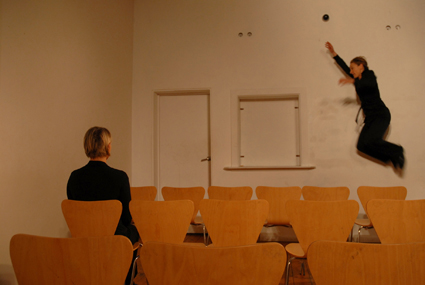
The Waiting Room, Born in a Taxi
photo courtesy the artists and Brisbane Powerhouse
The Waiting Room, Born in a Taxi
From New Zealand, Hackman’s Apollo 13: Mission Control takes over half the Powerhouse Theatre in yet another extension of the theatre experience as we join flight director Gene Kranz and become responsible for helping guide the famous space shuttle home. It’s been lauded by critics and loved by audiences for its innovation and imaginative design. Well-received at both Edinburgh and Dublin Festivals, Diciembre is an intense, highly charged and passionate piece from Chile’s Teatro en el Blanco in which personal and autobiographical events impinge on the drama, including experiences of racism, protectionism and patriotism. Sydney-based performance-maker, writer, teacher and curator Rosie Dennis was last seen at the Powerhouse with her production Fraudulent Behaviour earlier this year. Her current work, Downtown, an exploration of belonging and connection, will be created day by day in Brisbane across the festival for a final day/night showing featuring Brisbane’s Gay and Lesbian Choir. Finally there is the mainstage appearance of the winner of the Melbourne Fringe Festival Brisbane Powerhouse 2010 Performance Award, The Waiting Room by Melbourne’s Born in a Taxi & The Public Floor Project. This highly physical, non-verbal work involves a live, real-time sound score which makes each performance an unrepeatable event.
There are seven brand new Australian shows in the making in the 2011 Scratch Series. WTF finds spaces for artists to take wild flights in front of an audience, and an informal atmosphere in which to discuss and absorb feedback from the audience. Personally, I find this arena for nascent works fascinating, often discovering that the process of polishing loses much as the rough beast is tamed. Gorgeous national and international performers like Christine Johnston and Lisa O’Neill are on hand, creating musical/performance vignettes with Peter Nelson in order to develop their RRAMP band sound and aesthetic; well known Polytoxic scrambles a new, high flying work; Daniel Santangeli’s Room 328 will drive you to drink (no, I loved their commitment and dark carnivalesque in its first incarnation, and look forward to seeing it again; see review); Black Queen Black King by Steven Oliver explores the lives of four Indigenous gay men culminating in a celebration of strength, pride, sexual and cultural identity; and Elephant Gun by The Escapists looks like being an intriguing site-specific work for a small audience.
These six specifically Queensland works are complemented by the Drawing Project (Open Studio), a multi-arts project by Fleur Elise Noble from Adelaide and featuring Erica Field as the performer. There is also a Masterclass and Forum Series running throughout the festival. The keynote speaker is Jude Kelly (Southbank, UK), her talk centres on community engagement with creative spaces and how cities are identifiable in the art they’re producing. This series is open to tertiary students, local artists and industry. What to do in February? Come to WTF!
World Theatre Festival 2011; Brisbane Powerhouse, Feb 9-20, 2011; brisbanepowerhouse.org
RealTime issue #100 Dec-Jan 2010 pg. 29
© Douglas Leonard; for permission to reproduce apply to realtime@realtimearts.net
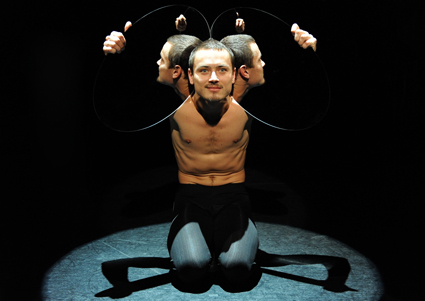
Paul White, In Glass
photo Ian Bird, courtesy Sydney Opera House
Paul White, In Glass
IN ITS SECOND YEAR, THE SPRING DANCE PROGRAM AT THE SYDNEY OPERA HOUSE HAS BEEN A FEAST FOLLOWING THE CITY’S 2010 CONTEMPORARY DANCE FAMINE. AN ALMOST OVERWHELMING FOUR-WEEK PROGRAM PRESENTED DANCE FILM, LIVE PERFORMANCES AND AN ONLINE CHOREOGRAPHIC COMPETITION. TWO OF THE AUSTRALIAN PREMIERES WERE BY ESTABLISHED DANCE ARTISTS NARELLE BENJAMIN AND GIDEON OBARZANEK.
in glass
Narelle Benjamin’s creamily athletic choreography folds, flicks, rolls, curves and dips in an admixture of textured rhythms and flowing ‘through-ness.’ The body of the choreographer is deeply inscribed everywhere on the bodies of its two magnificent dancers, Kristina Chan and Paul White—in the deep, deep flexion of the joints, in the rolling through and across positions, in the display of extreme flexibility and balanced strength born of yogic alignment, in the often triangulated and turned out legs and in the choreographic obsession with folding and opening. While Chan and White dance with their avatars created by five onstage mirrors, the dominant avatar is the absent/present choreographer whose powerful embodiment determines and inhabits In Glass.
Chan and White’s virtuosity is refined and knowing. In certain moments their temporal attunement is so delicate and deep it is delicious. Time and time again the world is made a beautiful place by this pre-lingual togethering. But time is not the only thing they mutualise. Spatially they see each other without having to see. He picks her up, right where he should, right at her centre, and the lift is velvety smooth, full of arc and curve, rich in its articulation of unspoken gravities and kinetic uplift.
But why does she not lift him? Chan is muscular and strong, trained in the vagaries of weight and momentum. But in a baffling defiance of this muscularity Chan plays the little girl lost in a baby doll dress. In Glass becomes surprisingly gendered, bleeding into a traditionalist fantasy that irritates its technological thrusts.
Sam James’ video art plays on the mirrors that become cinematic screens. Morphing from reflective surface to filmic depth, these mirror-screens create rippling waves of space and action, multidimensional zones that morph as in a dream. Prior to performance, the mirrors reflect the audience, casting them within the stage space and then turning them upon themselves. As the dancers dance we see their backs, taking us behind, beyond a performing surface, only to have these visions thrown back at us, encircling and involuting the performative image. Then James steps in and tunnels us into deep, deep space where we chase avatars and where images shrink into oblivion.
As mirrors, the screens produce the other selves: reflections, invisibilities, ghosts and fleeting images only just caught. A bearded White stands before the mirror/screen as three clean-shaven Whites stare back. Dance with them, I urge. Dance with these other selves. But Benjamin has established a performative rhythm that is quick and once an image flashes it dies. White turns and walks away. There is to be no duet with self.
In Glass constantly turned away from the choreographic potential of reflection, avatar and ghost. Images, situations and interactions were only fleetingly established before they were abandoned. Always moving on, this performance laboured under a plethora of unfulfilled ideas that became flaccid in their fleetingness. Gorgeous aesthetic images of a multi-armed Shiva-esque Chan suggested the choreography might dip its toe into the pool of possibility that is reflection, but then it just went away again and I was left wondering what Shiva had to do with Eve or Narcissus.
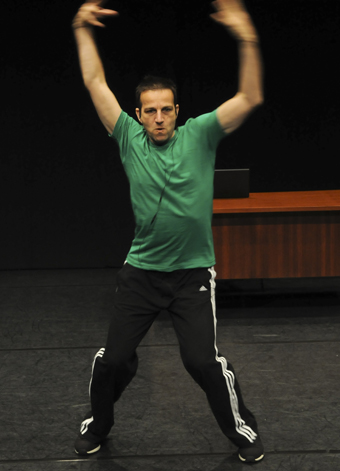
Gideon Obarzanek, Faker
photo Heidrun Löhr, courtesy Sydney Opera House
Gideon Obarzanek, Faker
faker
Gideon Obarzanek is so well known in Australia as the artistic director and choreographer for Chunky Move that dancing a solo now, after so many years of telling performers what to do, makes him seem fascinatingly vulnerable. Obarzanek says that he has no great desire to perform and gets no great joy from doing it; he merely has an interesting story to tell and only he can tell it. Bold. Clean. Simple.
In the black box of the Sydney Opera House Studio, at the very back and centre of the stage sits a desk with an open laptop. Obarzanek enters in casual black pants and a vivid green T-shirt. Bold. Clean. Simple, angular and symmetrical.
Faker is a performance carved up into clear and clean episodic sections, alternating dance and text evenly. Each time he dances Obarzanek accumulates a new technological toy: iPod, timer, Bose dock, in a property accumulation that is quietly masculine. Clear. Clean. Even.
This guy knows how to put on a show. In this clear, clean crafting lies his heritage and history: years of arranging, designing, forging and forming dance theatre. Even the relaxed demeanour, the understated set, the casual costuming speak of this confident crafting born of time spent and attention paid.
This tempered yet testosteronic confidence eventually leads Obarzanek to strip down to the contemporary dance ‘costume’ of undies—the harshly bright lighting regime revealing the truth of his age. Disconcertingly the house lights remain bright too: making Faker a shared space in which we are directly addressed—a still and obedient body of bodies. The performance accrues a density of spoken word as Obarzanek reads—from the laptop that sits as a barrier between us—a real e-mail from an apparently real protégé. The language of the message is simple, clear, heartfelt, if sometimes seeming slightly too crafted to be real. Obarzanek’s voice is confident and steady, clear and clean.
As he reads aloud the dancer’s impression of him, the essential narcissism of the solo is reaffirmed and doubled in a presence both here and there, real and virtual, present and historical, subject and object. In claiming the protégé’s voice Obarzanek generates a self-deprecating egoism that colonises her accusatory story.
Thus thickened, this solo becomes a duet, as Obarzanek channels the protégé, performing her absence. A lonely form, the solo is pared back and sweetly sad, yet Faker’s potential for poignancy and vulnerability is tamed by the angular masculinity and the virtual partnering.
The first two choreographic sections of Faker could be called non-dance: the loungeroom solo we have all danced, singing in the strangled language of words he doesn’t quite know, casting his age by dancing to a Prince song of the late ’80s, making us laugh. Atop softened knees it is a dance of hands and arms. The second anti-dance seems to push the point as he paces himself with his second toy: a digital timer. He flaps and wiggles into silliness.
He sits. Ghostly comments from the young woman in the machine keep coming in thick and delicious detail, even to accusations of “macho posturing” and “superficiality.”
Obarzanek takes off his shoes and I can almost hear the audience sigh, “here we go, here it is, he is going to really dance now.” But not quite. As he sheds his clothes, the traces of silliness fade. This dancer’s dance is made religious with chanting soundtrack and cathedral lighting that both parody and substantiate the pointed feet of a real dancer. In a repetitious motif of sweeps, dives, bridges, lunges and folds Obarzanek does what he had to do. He dances the dance, the dance that proves he can still dance. Applause. He heads to the dressing room: solo at last.
For more on Spring Dance, see Martin del Amo’s review of international works in the program, and RT99 for Keith Gallasch’s report on Ngurru-Milmarramiriw—Wrong Skin. For Sidi Larbi Cherkaoui’s Sutra also see Douglas Leonard’s report from the Brisbane International Arts Festival.
–
Spring Dance: In Glass, choreographer Narelle Benjamin, composer Huey Benjamin,visual design Samuel James, costume design Tess Schofield, lighting Karen Norris, The Studio, Sept 7-12; Faker, concept, choreography, performance Gideon Obarzanek, lighting Gideon Obarzanek, Chris Mercer, creative consultants Aimee Smith, Lucy Guerin, Antony Hamilton, Tom Wright, The Studio, Sydney Opera House, Sept 21-26
RealTime issue #100 Dec-Jan 2010 pg. 28
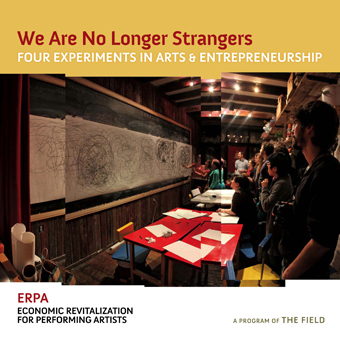
We Are No Longer Strangers
I WENT TO NEW YORK IN OCTOBER TO TALK TO ARTISTS AND ARTS WORKERS ABOUT SUSTAINABLE PRACTICE, SPECIFICALLY CONTEMPORARY PERFORMANCE AND DANCE. I GOT A NUMBER OF GUFFAWS AND SOME EYE ROLLING, BUT ONCE THE CYNICISM SUBSIDED, IMPASSIONED CONVERSATION SOON FOLLOWED.
Like all arts stories, it started with government funding cuts. In April this year, the Governor of New York announced an almost 40% reduction in arts funding for the state. After much public and political resistance, the budget was passed with ‘only’ a 15% reduction on 2009-10 levels.
As funding diminishes, the number of artists and arts organisations applying for support is only increasing. From 2002 to 2006, the number of unsuccessful applications to the New York State Council on the Arts grew by a staggering 210%. New York-based arts organisations offering residencies, small commissions and mini-grants are reporting similar increases.
Many of the larger organisations are feeling the squeeze. Dance Theater Workshop (DTW), Dance New Amsterdam (DNA) and 3LD Art & Technology Centre were all burdened with major capital campaigns prior to the crash, so they had little room to move. In April this year, The New York Times reported that DTW’s mortgage was about $2.9m and they were slated to merge with Bill T Jones Company, a move many speculate is financially driven. In July, DNA rallied City Hall in a plea to keep their relatively new downtown space, which they moved into after an outpouring of support after 9/11. They are still in negotiations with their landlord and the city.
The city and state funding cuts are exacerbated by a broader national context. Philanthropic organisations such as The Greenwall Foundation, Carnegie Corporation of New York and The New York Times Foundation have stopped their support of the arts since the financial crisis. Others have significantly scaled back their arts programs, including some of the larger ones such as the Rockefeller Foundation and the Doris Duke Charitable Foundation. Many have moved away from supporting general operating costs and will only support capacity building initiatives, national projects or re-granting through service organisations.
For organisations such as PS122, support from foundations represents around 30% of their income. Morgan von Prelle Pecelli, PS122’s Director of Development, believes a new economic model is needed. “The situation with foundations is not going to get better. Arts institutions like us need to shift to a more independent business model, with more diverse and robust contributed-, partner- and earned-income streams that stem directly from their missions and programming activities.”
Despite the Rockefeller Foundation’s diminishing arts dollar, it launched the NYC Cultural Innovation Fund in 2007. Two projects were supported that directly addressed the issue of sustainability for performing artists.
One project was Economic Revitalisation for Performing Artists (ERPA), an ambitious entrepreneurial lab run by The Field, a strategic consultancy for artists (established in 1985 by our own Wendy Lasica). Described by Jennifer Wright Cook, The Field’s Executive Director, as “experiments in making money,” its premise was that the traditional philanthropic model is no longer working. Out of 116 applications they received, seven were selected for grants of up to $20,000 each to develop their ideas. Four of these received implementation grants and their projects are detailed in the publication, We Are No Longer Strangers.
Stolen Chair Theatre Company used the model of Community Supported Agriculture, in which members provide seed money for a local farm in exchange for a share of the harvest, only in this instance the harvest was a theatre production. While they didn’t meet their original financial targets, Jon Stancato says he learned that it’s not just the final product that has value. “By opening up our process, we built an audience along the way.”
Our Goods, another ERPA awardee, removed money from the equation and developed a website for artists based on an exchange of goods. The site only launched a couple of months ago, so it’s hard to gauge its success. Their belief is that more work gets done in networks of shared respect and shared resources than in competitive isolation.
The other Rockefeller Cultural Innovation project was MADE HERE, a documentary series and website produced by the HERE Arts Centre which focuses on the challenging and eclectic lives of performing artists in New York. “We wanted to talk about issues from the artists’ perspective, how they’ve struggled and solved some of the problems they’ve faced,” explained Katrina Mangu-Ward, HERE’s Associate Producer. “There is a young core of artists who are reinventing the wheel, so we wanted to consolidate that.”
Season one, which rolled out from May through September 2010, covered five topic areas: Day & Night Jobs, Creative Real Estate, Family Balance, Activism, and Technology. Season two comes out in 2011.“People are isolated,” stressed Mangu-Ward. “We need a sense of community.”
Community support is at the heart of a number of alternative funding models that have proliferated in recent years, many of which are based in Brooklyn. Sweet Tooth of the Tiger, run by independent curator Tracy Candido, is part DIY food service project, part participatory art project. It used the model of a bake sale to fund small-scale residencies for artists in Brooklyn.
In a similar vein but with a stronger philanthropic push, FEAST (Funding Emerging Art with Sustainable Tactics) is a recurring public dinner designed to use community-driven financial support to democratically fund new and emerging artists in Brooklyn. Similar models are emerging across the United States, building a network of organisations committed to rethinking how art is financed and experienced communally.
In the past two years, FEAST has hosted eight events and supported 20 projects. However the money raised is modest: $12,756 since it started in 2009. “These projects are developed because they’re needed,” says Candido, who wound up her renegade bake sales earlier this year. “They start as scrappy, original, independent projects; they succeed, they grow. But how do you sustain that?”
Modest in scale, DIY platforms for presentation mirror community-based arts funding in that they too have emerged (and proliferated) in New York as a necessary alternative to mainstream channels. To name just a few: Catch, a multi-faceted, multidisciplinary, rough-and-ready performance series curated and hosted by Andrew Dinwiddie and Jeff Larson; Throw, curated and moderated by Sarah Maxfield, which provides artists with a platform for ideas-in-progress and audiences with insight into performance-making; and AUNTS, founded by Jamm Leary and Rebecca Brooks, which is “about having dance happen.”
A key issue is the degree to which these alternative models are supported by volunteer labour. In his article “The Mental Labor Problem,” published in 2000, cultural studies theorist Andrew Ross states that “artists and other arts workers accept non-monetary rewards, the gratification of producing art as compensation for their work, thereby discounting the cash price of their labor.” Arguably, an over-reliance on volunteer hours also favours younger artists, creating a reduced pool of mid-career and established artists able to survive long-term absence of adequate financial and job security, and associated healthcare benefits.
Many of the people I spoke to stressed that the system was problematic well before the financial crisis. In that way, the GFC has had less of an impact on the arts as opposed to other industries; artists were already living below the poverty line.
“Since the 60s, artists in this country have worked in challenging economic circumstances,” explains Barbara Bryan, Executive Director of Movement Research, a leading laboratory for the investigation of dance and movement-based forms. “But there is greater pressure on this generation of artists. The cost of living for rent and food for all New Yorkers has increased. We’re at a tipping point.”
Critical Correspondence, a project of Movement Research, developed a video project titled “What Sustains You?” which asks dance artists about money and sustainability. Like MADE HERE, it aims to galvanise community through collective storytelling that investigates how something seemingly unsustainable continues to survive. In one video, performance maker and writer Clarinda Mac Low relates her experience of burn-out in the late 90s. “I knew that if I did continue making work it would have to be in a very different way. It would have to not rely on money. It would have to rely on exchange of resources, creating networks.”
While talk of sustainability consistently returns to notions of community and shared resources (many of them online and non-monetary), it seems the biggest challenge was identified by cultural academic and commentator Arlene Goldbard when she spoke at the launch of The Field’s findings from their ERPA grants. Goldbard insisted that society needs to value the artist, a paradigm shift to which we should all contribute.
“Artists are the stem cells of the body politic, generating the many forms of beauty, meaning, and connectivity essential to our survival, our resilience—indeed, to all hope of a sustainable future.”
The Field: www.thefield.org/t-erpa.aspx MADE HERE: http://madehereproject.org; What Sustains You?: www.movementresearch.org/publishing/?=node656; Sweet Tooth of the Tiger: www.sweettothof the tiger; FEAST: http://feastinbklyn.org; Arlene Goldbard: http://arlenegoldbard.com
RealTime issue #100 Dec-Jan 2010 pg. 30
© Julieanne Campbell; for permission to reproduce apply to realtime@realtimearts.net
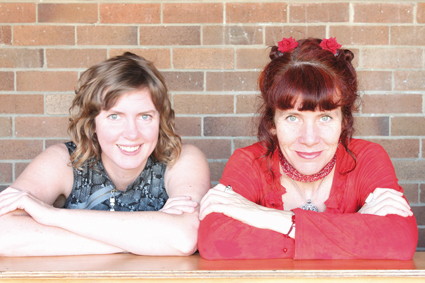
Cat Jones and Julie Vulcan
THOUGH YOU MAY NOT HAVE SET FOOT IN SYDNEY’S PACT CENTRE FOR EMERGING ARTISTS, YOU HAVE DOUBTLESS FELT ITS INFLUENCE AS ITS ASSOCIATES ARE NOW WORKING AS ARTISTS, PERFORMERS, PRODUCERS, WRITERS AND LECTURERS AROUND AUSTRALIA. PACT CAN’T TAKE THE CREDIT ENTIRELY AS MANY OF THESE WERE ALSO TRAINING ELSEWHERE, CHIEFLY AT THE UNIVERSITIES OF SYDNEY, NEW SOUTH WALES, WESTERN SYDNEY AND WOLLONGONG, BUT IT HAS BEEN A SIGNIFICANT MEETING POINT AND CREATIVE HUB, ABOVE ALL FOR EMERGING PERFORMERS.
Unsurprisingly, former and current associates feel a strong sense of ownership and follow its activities closely, so when artistic director Regina Heilmann retired from PACT in mid-2009 all eyes were on her successor Cat Jones. This year former associate director Chris Murphy has also moved on, with Julie Vulcan recently replacing her. I spoke with Jones and Vulcan about their plans for PACT.
a meeting of minds
Prior to joining PACT, Jones was working as creative co-producer for the inaugural Splendid Arts Lab and before that as the co-director of Electrofringe and a staff member of the Theatre Board of the Australia Council. In addition to these producing and curating credits, she has also worked as a devisor or performer (she originally trained in performance at QUT) with pvi and The League of Imaginary Scientists, among others, as well as on her own catgURL series. Like Jones, Vulcan has worked across many mediums. She originally trained in video art at the College of Fine Arts, UNSW, exhibiting in Sydney, Melbourne and Perth. From 1993 she worked as a co-devisor and performer with Icarus Performance Troupe, Frumpus and Unreasonable Adults, touring nationally and internationally. More recently, she has been working on a series of small solo works.
Jones and Vulcan first met in 2002 at the Time_Place_Space 1 hybrid arts laboratory which both agree was a pivotal moment in their respective careers because of the collaborations that resulted. When I ask them about how their practices fit together eight years later, they identify four areas of overlap. The first, says Jones, “is that both of us have really diverse backgrounds artistically,” working with “a really broad palette.” The metaphor itself speaks to their second common characteristic, which is what Jones calls a curiosity about “the link between the visual and the performative.” Both are interested in devised performance rather than more conventional forms of theatre and, last but not least, they have a strong interest in audience interaction though they can’t agree what to call it: the friendly to and fro is obviously the key to their creative partnership.
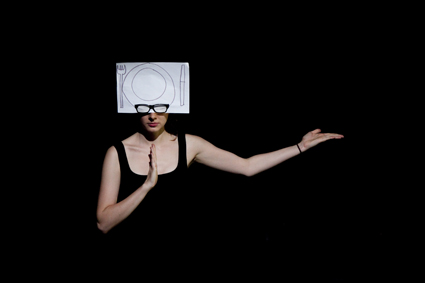
Lucy Watson, Unsettlings, PACT
photo Matthew Duchesne, © Milk & Honey Photography
Lucy Watson, Unsettlings, PACT
ensemble thinking
Central to PACT’s program is the Ensemble (formerly called the imPACT Ensemble), which provides professional and creative development for up to 20 emerging artists aged between 18 and 30 years. Successful applicants undertake physical and vocal training and develop and produce a new work, which runs for three weeks at the end of the year. This year, says Jones, they have kept the ensemble program largely intact “because it’s the first year and we need to test it out as close to its original form as we can; we need to know where we’ve come from in order to know where to go.”
Yet Jones has already started to make changes: this year’s program is shorter, the cohort is smaller and the creative process more intense. Whereas in previous years training commenced in May, Jones says that this year’s participants “have only been meeting once a week from August and that only stepped up to twice a week from October.” Jones says that the shorter program was necessary because, as Heilmann and Murphy reported in their RealTime interview in 2008 (RT90, p19), students now, for a variety of reasons, “struggle to commit” to extended development periods. Ensemble 2010 is also slightly smaller group—12 as opposed to the usual 16 to 20—and the group started developing their final show from their very first session, instead of roughly halfway through the program.
This short time span caused Jones and Vulcan to engage working methods to develop the group’s creative shorthand very rapidly. “Even before we started working with them,” says Jones, “we had a night where we brought everyone together in order to set up a dialogue…We talked about definitions of ensemble and performance and we started on the first round of creative tasks.” Vulcan also compiled a list of YouTube clips of contemporary performance, which included “everything from Forced Entertainment to Guillermo Gomez Pena to Spalding Gray.” Not only did this establish what Vulcan calls a “visual and shared language” it also enabled them, as Jones puts it, “to show the ensemble some of our influences without actually showing them our work, because the whole process isn’t about us as individual artists, it is about them.”
Jones and Vulcan are contemplating several changes to the ensemble and the wider program which could be summarised by the prefix inter-: interdisciplinary, international and interactive. Currently, says Jones, “the base model is all about producing performative outcomes from everyone in the ensemble. We’re talking about an ensemble that will also include a designer or other creative practitioners to expand the entire collaborative process.” While this obviously reflects Jones’ and Vulcan’s own interests and practices, it also stems from Vulcan’s observation that “there is a dearth of up-and-coming show designers—there’s very little place for them to grow. We’re thinking ‘Well, why can’t we nurture that as well?’”
a growing presence
Beyond increasing its already interdisciplinary approach, PACT is also looking to grow its national and international presence. This year the program was advertised nationally, included interstate auditions for the ensemble and several interstate artists in the program. Next year and beyond, for the wider program, Jones and Vulcan are looking to incorporate their own international networks in order to supplement what is happening locally. This will affect both “process and outcomes,” says Jones, so that some collaborations will happen via “remote hook-ups” and other “projects might have a physical realisation here but will be web-streamed overseas.”
Though the ensemble is key to PACT’s mission, its other activities are also important because they provide ongoing opportunities for working and networking. Jones and Vulcan are taking a varied approach to these programs, maintaining some schemes, formalising or augmenting others and then adding some new programs of their own. One of the programs they plan to maintain is Vacant Room, which offers emerging artists the opportunity to develop an idea or a project with the support and mentorship of the company. In addition, PACT will also remain the central point for the Erskineville Performance Art Festival (currently known as Tiny Stadiums) which not only provides a forum for emerging curators but also for emerging live artists with the entire event peer-programmed.
Jones has also introduced a new venture called The Space Program, which effectively formalises what was already happening on an informal basis whereby PACT provides subsidised space for creative developments for emerging artists. In addition, Jones is also seeking to augment the PACT Presents…program, which Heilmann and Murphy started in 2008 with Janie Gibson’s Whale Chorus and then continued in 2009 with Georgie Read’s The Paper Woman and Sally Lewry’s Back of Bourke. This year, PACT has presented as many shows again as part of the Sydney Fringe Festival (see p37), and next year it will present a total of eight shows, including dancer Matthew Day’s new show, Cannibal, which is part of the 2011 Mardi Gras program, and Grit Theatre’s production Us. But perhaps the most exciting development of all is that PACT is commissioning six Indigenous artists—all of whom worked with Wayne Blair as part of the Incubate program in 2009—to create a work during May and June which will then be performed in July for NAIDOC week.
Commissioning artists is an expensive endeavour and it has only become possible through a combination of new money, new team and new structure. Restructuring had already been under way to make the Artistic Director and Company Manager positions full-time and a Communications Coordinator role has been added. PACT’s first triennial funding from Arts NSW means that staff hours will be able to increase further, as will the company’s ability to support and encourage emerging artists. These are exciting times in Erskineville and PACT’s impact looks set to reach even further afield.
PACT Centre for Emerging Artists, Erskineville; www.pact.net.au
RealTime issue #100 Dec-Jan 2010 pg. 31
© Caroline Wake; for permission to reproduce apply to realtime@realtimearts.net
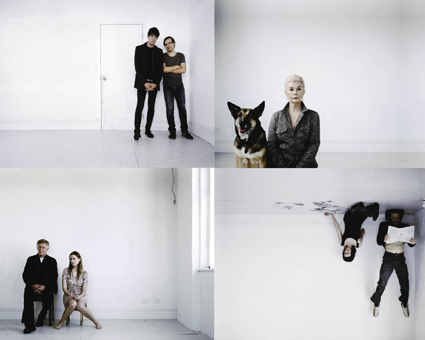
clockwise from top left – Toby Schmitz, Ewen Leslie, The Wild Duck; Robyn Nevin, Neighbourhood Watch; Lucy Guerin Inc, Human Interest Story; John Gaden, Maeve Dermody, The Seagull
photos WILK
clockwise from top left – Toby Schmitz, Ewen Leslie, The Wild Duck; Robyn Nevin, Neighbourhood Watch; Lucy Guerin Inc, Human Interest Story; John Gaden, Maeve Dermody, The Seagull
BEYOND THE APPEAL OF THE SELECTED PLAYS AND ARTISTS, THEATRE COMPANY SUBSCRIPTION BROCHURES DON’T USUALLY PROVIDE EXCITING READING, BUT THE 2011 BATCH IS EXCEPTIONAL ON SEVERAL COUNTS. SAMPLING THE BROCHURES FOR BELVOIR, SYDNEY THEATRE COMPANY, GRIFFIN THEATRE COMPANY AND MALTHOUSE, REVEALS SIGNIFICANT TRENDS WITH REGARD TO THE CLASSICS, NEW AUSTRALIAN PLAYS, WOMEN AND INDIGENOUS ARTISTS, OTHER FORMS OF PERFORMANCE AND ADD-ONS TO ATTRACT AUDIENCES TO THE THEATRE. INDIVIDUALLY THE BROCHURES ARE TELLING IN TERMS OF DESIGN, ATTITUDE, THE AMOUNT OF INFORMATION AND THE EXPRESSION OF THEMATIC CONCERNS—SOME ARE ACTUALLY A GOOD READ.
belvoir
Belvoir’s 2011 booklet-brochure design is strikingly spare, exuding a certain European seriousness and stylishness, its string of performer portraits suggesting that actors share a common stage and the productions a collective strength. The notes are equally spare but are convivial, energetic and purposeful. As well, there’s a very marked sense of newness—new title (Belvoir instead of Company B Belvoir), new artistic director (Ralph Myers), new logo (chair+boot=horsey; that’s the magic of theatre), new roles—resident director (Simon Stone, associate director Eamon Flack and an associate artist, composer Stefan Gregory)—and upstairs and downstairs programs as part of a continuum. The very openness of the design underlines the freshness of the venture.
The notes are pithy and sometimes drolly ironic. For Ibsen’s The Wild Duck, to be directed by Stone, they read: “At the core of [Ibsen’s] work is the idea that anything less than total honesty and an exhaustive conscience will sow the seeds for future tragedy—which makes Ibsen the ideal dramatist for contemporary Australia.” The Business, based on Maxim Gorky’s Vassa Zheleznova and transposed to an Australian setting, “relates to one of the great Australian themes: how we hauled ourselves out of our working class past and set out on the road to a relaxed and comfortable future.” For Shakespeare’s As You Like It, to be directed by Eamon Flack, the note reads, “At its heart is a heroically foolhardy attempt to begin society all over again, which makes this a perfect end to the first year of the new Belvoir.” Myers’ earnestly impassioned introduction is likewise tempered with a photo from the rear of him holding a copy of Bluff Your Way in Theatre.
Classics make up a large part of the program; these days they’re bound to be challenging interpretations in the hands of Simon Stone and Benedict Andrews. The latter will direct Chekhov’s The Seagull with a very strong cast: Emily Barclay, Gareth Davies, Judy Davis, Maeve Dermody and John Gaden. Neil Armfield is to direct Ray Lawler’s The Summer of the Seventeenth Doll, with Robyn Nevin, Yael Stone, Helen Thomson and Dan Wyllie, while The Business will be directed by Cristabel Sved who has adapted the Gorky text with Australian playwright Jonathan Gavin.
Other new writing includes Melbourne playwright Lally Katz’s Neighbourhood Watch, “a comedy about hope, death and pets,” directed by Simon Stone and featuring Robyn Nevin. Duncan Graham’s The Cut is to be directed by Sarah John; Susanna Dowling will take on four short works by Chekhov, Kate Chopin, Peter Goldsworthy and Guy De Maupassant grouped as The Kiss; and Leticia Caceres is to direct Brendan Cowell in Brisbane playwright Angela Betzien’s utterly chilling award-winner, The Dark Room.
Given the concerns loudly voiced earlier this year about limited opportunities for female artists at Belvoir, the allocation of directorial roles to Sved in the upstairs theatre and downstairs to John, Dowling and Caceres will doubtless be welcomed. As well, Kylie Farmer (seen in The Sapphires) will direct Roxanne McDonald in David Milroy’s Windmill Baby, an account of Aboriginal life on a pastoral station half a century ago with tragic dimensions. The other Indigenous work in the Belvoir program is Ilbijerri Theatre Company’s Jack Charles V The Crown, coming after its successful Melbourne International Arts Festival premiere (see review).
Belvoir has adopted Malthouse’s well established policy of including dance and contemporary performance works in its program, encouraging audiences to take a broader view of the performing arts and acknowledging the the changing nature of theatre itself. Version 1.0 and Post appeared at Belvoir Street this year and next year Melbourne’s collective “anti-institution,” The Black Lung Theatre and Whaling Firm, make their Sydney debut with Gareth Davies’ And They Called Him Mr Glamour—”a pathetically hilarious tale of a man, alone on stage, desperately seeking the audience’s attention.” (The team also appear in the 2011 Queensland Theatre Company season with the large-scale work I Feel Awful.) Belvoir also now offers dance to its patrons in the form of Lucy Guerin Inc’s spooky account of the impact of mass media triviality, Human Interest Story (RT99).
sydney theatre company
Sydney Theatre Company’s vivid brochure is the antithesis of Belvoir’s. STC continues in the vein of its 2010 publicity in which every show had its own design, but this year each is more vivid, more richly coloured, suggesting a theatrical cornucopia. Even more than this, it’s a publication that offers plenty of reading: a lively and thoughtful introduction from artistic directors Cate Blanchett and Andrew Upton, detailed notes about each play, testimonials, something from John Birmingham about the nature of Sydney and a page for your own notes.
In line with Blanchett and Upton’s determination to develop a cultural precinct for Sydney from Walsh Bay to the Botanic Gardens, there are engaging hand-drawn maps of the area indicating venues, eateries, walking and transport routes, including discount offers for STC subscribers.
The artistic directors write of their selection of plays from the 20th century, “We feel theatre gives you a chance to lead many lives, to experience many more moments than those (too few) allotted to us by fate. At the theatre we are outside looking in; sometimes in awe, sometimes in terror, always further. This year’s throw is loaded with the force of history. As we enter the second decade of the 21st century it seems timely to have a think about the 20th…Two World Wars, two A-Bombs, various forms of Fascism and an array of failed revolutions. Oddly for such a dark century there is a farcical quality to much of the work that emerged from it, a pitch black comedy that cuts through, delving beneath the hysteria, the fanaticism and the g-force change-rate that characterises the Age of Extremes (as Eric Hobsbawm christened it).”
As for the purpose of the selection, “The 20th century never looked crazier. The past never looked so close and snapping as it always is at our hurrying heels. Hurrying on to the future we are. A future that we convince ourselves will be better than the past we have either erased, ignored or sentimentalised. No, let’s face it. Let’s stop and take a bit of time and wonder who, what, where and why?”
The highlight of the season should be Botho Strauss’ epic, Gross und Klein (Big and Little, which was seen in productions in Melbourne, Adelaide and Sydney in the 80s) with Blanchett as Lotte who wanders through an opaque, ungiving and increasingly bizarre world—either Lotte or society is disintegrating. The English language version is by leading UK playwright Martin Crimp, who shares not a little stylistically and thematically with Strauss, and the director is France’s Luc Bondy, a figure usually associated with major opera productions and one who should ably manage, like Blanchett, the work’s huge demands.
Among other 20th century classics are Andrew Upton’s adaptation (already successfully staged in London) of Mikhail Bulgakov’s The White Guard, Raimondo Cortese’s adaptation of The Threepenny Opera, directed by Michael Kantor with performers Paul Capsis and Eddie Perfect in a Malthouse co-production, Joe Orton’s Loot (director Richard Cotterill), and Harold Pinter’s rarely seen No Man’s Land, perfectly cast with John Gaden and Peter Carroll and to be directed by Michael Gow in a Queensland Theatre Company-STC co-production. I saw the premiere production in London in 1975 with John Gielgud and Ralph Richardson and can still recall the play’s disturbing power, emanating from its variation on the ‘unwelcome guest’ trope intensified by the faltering memories of the aged antagonists. The Malthouse production of Brecht’s Baal and a new production of Lorca’s Blood Wedding to be directed by Iain Sinclair with a cast that includes Lynette Curran and Leah Purcell, complete the substantial set of classics in the 2011 program.
New writing in the program includes the much-anticipated premiere of Zebra, an STC commission by Ross Mueller, one of the current handful of Australia’s brightest playwriting talents. Set in New York, it’s described as “a fast-paced, mid-life crisis comedy…ruminating on who we are post-GFC. What has plummeting from the dizzy heights of prosperity done to us as a society and as individuals? How has humiliating failure altered our self-image? Will Australia’s obsessive love affair with all things American end acrimoniously in the wake of the fall?” Zebra features Bryan Brown and Colin Friels; as with No Man’s Land, another interesting male pairing.
Also much-anticipated is Bloodland, the Indigenous component of STC’s 2011 program. From a concept by Stephen Page, story by Kathy Marika, Stephen Page and Wayne Blair, script by Wayne Blair and direction by Page, Bloodland will be performed in Indigenous language and pidgin “incorporat[ing] spiritual and physical languages, ceremonial traditional dances and mimicry of modern western culture, filtered through Aboriginal tradition.” The cast will comprise “both traditional Yolgnu people and well-known actors, to compose a new Australian work that dramatises the bitter tug-of-war taking place in a community which, despite being wracked by pain and division, hums with hope.”
In their introduction, the STC artistic directors emphasise the season’s many great roles for women; this is evident in directing as well as acting. Lee Lewis directs Zebra, Pamela Rabe takes on Sarah Ruhl’s In The Next Room, or The Vibrator Play and Sarah Goodes stages Edward Gant’s Amazing Feats of Loneliness while in the Education Program Naomi Edwards stages her adaptation of Hamlet, Sarah Giles directs Matt Cameron’s Ruby Moon and Roslyn Oades revives her innovative Stories of Love and Hate, originally produced by Urban Theatre Projects.
There’ll be a welcome return visit by Belgium’s provocatively experimental Ontroerend Goed (Once and for all we’re gonna tell you who we are so shut up and listen, RT93; RT89) and the 2011 Next Stage program will be announced shortly.
griffin theatre company
Griffin Theatre Company’s relatively small ouput is exceeded by its influence in pinpointing talent and developing plays that will go on to have long lives. Its achievement is celebrated with a return season of Andrew Bovell’s Speaking in Tongues which was developed by former artistic director Ros Horin and premiered in 1996, later becoming the screenplay for the Ray Lawrence feature film Lantana (2001). The play will be directed by Griffin’s new artistic director Sam Strong.
Also on the program is Lachlan Philpott’s Silent Disco (a Griffin, Hothouse and ATYP co-production, directed by Lee Lewis), focused on the problematic youth world “of Speds and Bitches—fuelled by Red Bull and iPods.” The script, “with its incendiary language and defiant theatricality,” won the 2009 Griffin Award. And No More Shall We Part, by Tom Holloway, the most exciting of Australia’s younger playwrights, will receive its Sydney premiere, directed by Strong, after winning the 2010 AWGIE for Best Play and the 2010 Louis Esson Prize for Drama. The play focuses on a couple parting after a lifetime together. Local writing comes in the shape of Jane Bodie’s This Year’s Ashes, directed by Shannon Murphy, tracking the fate of a young woman in a “reluctant romantic comedy about Sydney, grief and cricket.”
Strong writes of his 2011 program, “Coming in for special attention this year is the need to connect with other people that drives us into relationships (and for that matter the theatre).” The theme is extended to Griffin Studio which will bring together writers Ian Meadows and Kate Mulvany and directors Shannon Murphy and Paige Rattray to focus, as part of their duties dramaturgical and otherwise, on the development of Museum of Broken Relationships for production in 2012. The team will invite the Griffin audience to contribute to objects and/or stories about relationships past, thus “playing a part in Australia’s very first narrative museum.” It’s an interesting way in the Facebook era to engage with an audience who’ll doubtless come looking to see if they’ve made it onto the stage.
The Griffin brochure, with its distinctive criss-crossing of text on the cover and woven through its pages—a reminder of the company’s preoccupation with words—sticks to the facts. There are no wry references to matters political or philosophical or what the director thinks Australian society needs—the plays will speak for themselves.
malthouse
The Malthouse Season 1 brochure is attractively produced as an elegant, dark green notebook with floral endpapers and the frontispiece announcement “This is a beginning, Like all beginnings.” Marion Potts is the new artistic director of Malthouse.
Rarely sighted classics are strongly represented. Potts will direct the late Jacobean tragedy by John Ford, ‘Tis Pity She’s a Whore, with music by Andrée Greenwell; Eamon Flack directs Robert Menzies in Samuel Beckett’s The End (a co-production with Belvoir); and Bertolt Brecht’s early work, Baal, will be directed by Simon Stone in a new translation by Stone and Tom Wright. Former artistic director Michael Kantor will direct a major new work by Lally Katz, A Golem Story: “if God has turned his back on the world, who has the right to take His place?
The company’s continued commitment to dance is more than evident in the Malthouse component of the 2011 Dance Massive festival—Chunky Move’s new work Connected, Narelle Benjamin’s In Glass (see review), BalletLab’s Amplification (see review) and Gideon Obarzanek’s Faker (see review).
Pamela Rabe will direct Australian playwright Vanessa Bates’ Porn.Cake , described by Playwriting Australia’s Chris Mead as “politely ferocious and charmingly obscene.” And there’s also a return season of the much praised, Moth, a Malthouse/Arena collaboration (RT97). And that’s just Season 1.
a good read
Yes, they’re brochures not books, but they are very telling, about a period of theatre in transition, one engaging with a larger performative and cultural framework, offering more opportunities to women and Indigenous artists, hard-nosed in their treatment of classics and the nurturing of new talent (never enough room), and alert to the need to engage audiences in extra-theatrical ways (talks, post-show music etc). As well, compared with a decade ago, even five years back, current programming is rich with co-productions that ensure we see works that might never have travelled beyond their points of origin or indeed had second lives, or more. There’s also a great sense of communality, of sharing and overlap between companies of directors, writers, designers and actors and with this a growing sense of an Australian theatre both richly local and national. That’s worth reading about.
–
RealTime issue #100 Dec-Jan 2010 pg. 34-35
© Keith Gallasch; for permission to reproduce apply to realtime@realtimearts.net
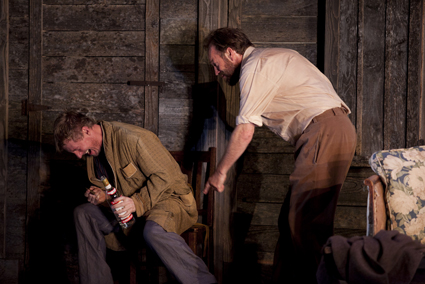
Richard Roxburgh, Hugo Weaving, Uncle Vanya
photo © Lisa Tomasetti, 2010
Richard Roxburgh, Hugo Weaving, Uncle Vanya
THE SYDNEY THEATRE COMPANY PRODUCTION OF ANTON CHEKHOV’S UNCLE VANYA LAYERS A PATINA OF THE ACCENT AND LIGHT OF MID-20TH CENTURY RURAL AUSTRALIA OVER THE PLAY’S LATE-19TH CENTURY RUSSIAN SETTING. ITS PRODUCTION OF SAM SHEPARD’S TRUE WEST, PLAYED BY AUSTRALIAN ACTORS, ONE OF THEM INDIGENOUS, IS RIGOROUSLY AMERICAN IN VOICE AND EMBODIMENT. UNCLE VANYA IS DIRECTED BY A HUNGARIAN, TRUE WEST BY AN AMERICAN. CROSS-CULTURAL COLLABORATIONS AND FIDELITY TO TEXTS HAVE YIELDED MORE THAN MERELY MEMORABLE THEATRE.
In each production a pair of superb male performances, Hugo Weaving and Richard Roxburgh in Uncle Vanya, Wayne Blair and Brendan Cowell in True West, provides the volatile dynamic that unleashes new realms of feeling and insight.
uncle vanya
In the beginning, harsh sunlight glares into a huge barn of a room, flies buzz persistently, a worker in the distance chops wood. At the play’s end, the walls have closed in, the light dimmed and cut logs fall through an open door as if in readiness for the internal exile imposed by the coming winter. In the meantime relationships have unravelled to the point of violence. Talk for talk’s sake, denial and alcoholic release have failed to veil the disappointments of love and ideals unrealised.
Central to Tamas Ascher’s direction, as it was in his Ivanov for the 2009 Sydney Festival, is a superb sense of rhythmic momentum: stillness followed by sudden propulsion, outbursts, reflection, dancing, subtle personal moves (Yelena’s hand momentarily on Vanya’s), household comings and goings and obstructions—a large door that comes to symbolise emotional barriers. These alternations are embodied in the performers’ characterisations: the doctor, Astrov (Hugo Weaving), energetically and loquaciously idealistic, immediately has an eager- to-dance bounce in his loping step. Richard Roxburgh’s Vanya is awkward, restive, his clothes don’t fit and his hair sticks out at odd angles—it’s as if he’s just got out of bed and is trying to make sense of a world with which he is out of step, making him all the more frightening when he moves, gun in hand, with the energy of a killer.
Cate Blanchett’s Yelena is, as one of the characters sarcastically puts it, “a sleek, beautiful ferret,” elegant, 1950s stylish. She attempts to move smoothly through the irruptions created by her husband’s self-pity, Vanya’s advances and Astrov’s attractiveness, her self-contained rhythm only broken temporarily in a bout of loose-limbed, tipsy playfulness with her step-daughter, Sonya (Hayley McElhinney), or in a desperate, passionate embrace with the doctor. Elsewhere her empathy for Vanya and Sonya can’t be allowed to get in the way of a necessary obtuseness that goes with a protected, if loveless, life with her wealthy husband, Serebyakov (John Bell). Sonya, on the other hand, is stolid and pragmatic, her stabilising presence and her physical assuredness soon undone by her passion for Astrov, as is the comforting rhythm of managing farm life with Vanya.
What is striking about Ascher’s account of the play is his perfect balancing of tedium and tension with immediacy and viscerality—when Vanya sees Astrov and Yelena embracing, he is like a man winded; when Yelena is exhausted by Vanya’s courting she slumps from the waist almost to the floor; when Vanya and Astrov dance it is almost dangerous; even the hypochondriacal Serebyakov confined to his chair bristles with an explosive nervous energy. These are not people living in a reverie of hope and despair or slow-motion rural life; body and soul they face a crisis. And although their jobs, their roles remain the same, we have seen them change, learn, suffer—Sonya’s first yearning for love, Yelena’s glimpse of love with Astrov, Vanya’s knowledge that he is unloved, the death of friendship between Vanya and Astrov. Life will go on as before but, equally, will not.
Performances overall are excellent, vividly detailed and constantly surprising. Roxburgh and Weaving together constitute the production’s greatest strength, partly because their joint dynamic is embodied in the writing—these friends are emotional and philosophical opposites and their shared attraction to Yelena the thread around which much of the play is delicately woven. In performance, the actors’ characterisations are idiosyncratic, contrastive but compatible, and each has a particular energy, emotional and physical—Roxburgh’s fascinatingly lateral, Weaving’s forthright. This is felt right to the end when Astrov has to retrieve the stolen morphine with which Vanya might suicide.
Andrew Upton’s adaptation is lucid, the language unlaboured, unadorned (effectively homing in on a few key words like “disgusting” and “nothing”) and peppered with just enough of the vernacular in the mouths of the minor characters to make sense of the unforced cultural transposition.
Ascher’s Ivanov for the Sydney Festival in 2009 located that earlier Chekhov work in 1960s Hungary (the effect, both seductive and disturbing, as I mentioned at the time [RT89], was not unlike watching one of Czech director Milos Forman’s 60s films). With its broader, less centred social palette and Ascher’s large company, Ivanov allowed for radical stage invention and an acute sense of analogies drawn between different eras. The STC-Ascher Uncle Vanya is much more restrained in its transposition; doubtless the play’s tighter structure left little room for anything more than Australian ambience in sound, light, occasional diction alongside uncluttered, un-rhetorical contemporary playing. Chekhov’s ecological sensitivity voiced by Astrov, still feels starkly contemporary. This surprised some in the audience who suspected adaptor Andrew Upton of updating the play because the STC has just gone seriously green at its Wharf venue (www.sydneytheatre.com.au/visit/greening-the-wharf).
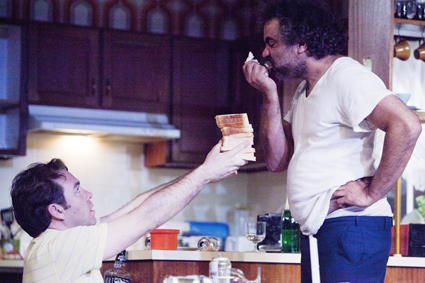
Brendan Cowell, Wayne Blair, True West, Sydney Theatre Company
photo Brett Boardman
Brendan Cowell, Wayne Blair, True West, Sydney Theatre Company
true west
A suburban home outside Los Angeles: kitchen, pot-plants, a writer at work, someone standing in the dark behind him. The sense of threat is immediate (the set thrusts out almost into the audience) and is sustained throughout American actor and director Philip Seymour Hoffman’s account of Sam Shepard’s True West.
The threat develops an increasingly delirious edge as the renegade desert-dweller Lee (Wayne Blair) takes over the life of his screenplay writer brother Austin (Brendan Cowell), goading him into crime (Austin opts for the non-violence of stealing toasters), usurping Austin’s contract with a producer so that he can get his ‘true’ western made, and forcing Austin to help him script it (“I want to do it myself…just help me get the talking right”). Lee, however, becomes preoccupied with the very art he has hitherto viciously derided (“What? You’re paid to dream?”) while Austin begins to reject anything that will compromise his integrity as a writer. He declares there is no true West (the streets of his childhood now look to him like replicas) and grows seemingly insane, but appears, at the very least, to be his own man. Art becomes too much for Lee who decides to return to the desert, despite having admitted that it has never constituted freedom so much as a refuge from the punishing suburban life that rendered him an outsider in the first place.
Shepard, like his near contemporary Harold Pinter, generates menace by creating in Lee a master manipulator who uses the ambiguities of language to trap his less verbally skilled prey with skewed logic and rhythmically forceful delivery. Lee’s aggression is compounded by physical threat, driving Austin to hide ineffectively amidst the pot-plants and to reluctantly comply with his wishes. Lee likewise repeatedly smashes the typewriter that will not yield the words he wants and, with Austin, eventually trashes their mother’s home as their joint reality becomes increasingly unhinged.
Blair’s Lee speaks with an almost movie-gangsterish growl, occupies space as if it was his alone, moves suddenly from sheer stillness into attack mode, and, most frighteningly, in his moments of revelation, stares wide-eyed into the distance as a prelude to some act of nastiness. Cowell’s Austin is tight, hands kept close to the body, his speech and walk neat, verging on fey. As the role reversal unfolds, Austin manically asserting himself (making a mountain of toast) and Lee rattled by the demands of art, the mood and body language changes: Austin becomes the threatening, psychotic presence. Blair and Cowell execute the reversal expertly, on the way adroitly playing out the episodes Shepard binds to riffing arguments about Idaho plates, art, golf, movie car chases and scriptwriting (a rare moment of hilarious unanimity over the rightness of, “I’m on intimate terms with this prairie”).
Wayne Blair, Brendan Cowell and Phillip Seymour Hoffman have finely realised True West’s raw, scary, scintillating portrait of brotherhood—loveless, intimidating and, finally, deadly, revealing how exclusion, the broken family and (as the nearest-to-hand excuse for Lee) Hollywood-fuelled creative ambitions can combine explosively. True West is a further step in STC’s welcome engagement with American theatre, its plays and its artists, while the invitation to Tamas Ascher to direct Uncle Vanya has proven to be even more cross-culturally inspired.
Sydney Theatre Company: Uncle Vanya, writer Anton Chekhov, director Tamas Ascher, performers Richard Roxburgh, Hugo Weaving, Cate Blanchett, John Bell, Hayley McElhinney, Sandy Gore, Anthony Phelan, Jackie Weaver, Andrew Tighe, designer Zsolt Khell, lighting Nick Schlieper, composer/sound designer Paul Charlier; Sydney Theatre, opened Nov 13; True West, writer Sam Shepard, director Philip Seymour Hoffman, performers Wayne Blair, Brendan Cowell, Alan Dukes, Heather Mitchell, designer Richard Roberts, lighting Paul Jackson, composer, sound designer Max Lyandvert; Wharf 1, STC, Sydney, opened Nov 2
RealTime issue #100 Dec-Jan 2010 pg. 36
© Keith Gallasch; for permission to reproduce apply to realtime@realtimearts.net
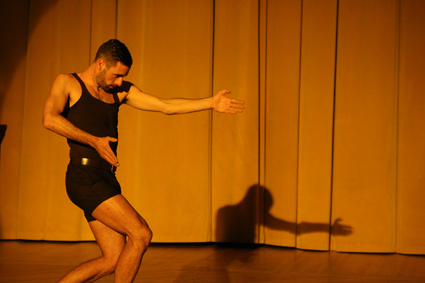
Matthew Day,Thousands
photo Gareth Hart & Next Wave Festival
Matthew Day,Thousands
THE SYDNEY FRINGE FEATURED SOME 200 SHOWS OF WHICH I CAUGHT A MERE HANDFUL AT PACT AND CARRIAGEWORKS. IT GRABBED A LOT OF MEDIA ATTENTION, ATTRACTED LARGE AUDIENCES FOR SOME SHOWS (ESPECIALLY AT CARRIAGEWORKS), SMALL FOR OTHERS (SOME ARTISTS COMPLAINED TO THE PRESS ABOUT LACK OF MARKETING SUPPORT), HANDED OUT MANY AWARDS WITH ITS SPONSORS AND TRUMPETED HUGE TICKET SALES, 35,000, AND MASSIVE BENEFITS FOR THE LOCAL ECONOMY. WISELY FOCUSED IN INNER CITY SUBURBS (REDFERN, ERSKINEVILLE AND MARRICKVILLE), THE SYDNEY FRINGE MAY WELL HAVE GAINED SUFFICIENT TRACTION IN 2010 TO GUARANTEE ITSELF A FUTURE.
matthew day: thousands
We’re seated mere feet away from Matthew Day, alert to the increasing tension in his body as he balances horizontally, close to the harsh floor on a mere two points of contact, suspended for a brief eternity before unfolding into a rotating, standing series of subtle transformations for…I don’t know how long. Time is erased as Day seamlessly mutates into slow-mo, non-literal evocations suggestive of body-builder, dance clubber (bizarrely headless as he faces away from us, head dipped), martial artist, butoh dancer, sportsman… as well as suggesting the body young and then strangely aged. The precision, control and focus are breathtaking. This is not dance in the usual sense, but it takes all the skill, strength and creativity of a talented dancer-choreographer to realise this acutely delineated state of being. Day, who studied at the University of Western Sydney and the Victorian College of the Arts, describes himself as a choreographer and dancer who works across dance, performance, film/video, queer cabaret, drawing and theory. Watch out for more from Matthew Day.
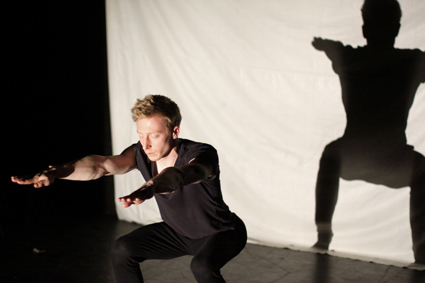
Skye Gellmann, Retinal Damage
photo Niki Bodle
Skye Gellmann, Retinal Damage
skye gellmann: retinal damage
Skye Gellmann, of Scattered Tacks fame (RT97), likewise induces an altered state in his audience. Two small rows of us face each other across a narrow performance space, plunged into darkness save for the flickerings of a slide projector that enable the artist to undo our perception of space. We see Gellman appear and disappear; we feel the rush of air and the too-near proximity of his body as he somersaults between us in the dark; we watch with the scary luxury of a close-up as, inches away, hands on wooden blocks, he walks upside down. As with Matthew Day, the proximity of the performance, the artist’s control, focus and inventive visual play, and a sense of risk, make for a very special experience of the body.
appelspiel: appeloft
Appeloft is performance taken to the nth degree of informality and apparent happenstance. Again, intimacy rules, but skill and focus are out of the picture—calculatedy elided in favour of building an aura of spontaneity. We’re seated on ancient lounge suites, fed homey cakes and treated like acquaintances who’ve wandered into a student party and are expected to participate, if with minimum pressure. The performance climaxes in a collective dance in sleeping bags. It’s painless fun with stories that don’t go anywhere (these people remind us just how slick Forced Entertainment are), games that don’t make sense and a silly making of a radio play that amusingly toys with vegetables and the relation of image to sound. But threaded through the non-sense are matters that are not played for their drama but nonetheless suggest deeper concerns: a female performer who is losing her eyesight decides she wants to cut the fruit that will be handed out to us, and an odd tale is told of the opening of revealing letters to a presumed-to-be-dead previous tenant. This is amiable performance, hovering between script and improvisation and dependent on the company’s ability to consistently riff in the party manner, which it largely did. I look forward to seeing what Appelspiel (whose members studied together at the University of Wollongong) can get up to beyond the party format.
elbow room: tiny chorus
Elbow Room’s well-travelled, much praised, Melbourne, Adelaide and Sydney Fringe festivals’ audience favourite, A Tiny Chorus is a clever take on the mechanics of clown duos of the ilk of Laurel and Hardy but, significantly, without manifesting the physical violence that typically results from dumb errors, envy, greed, embarrassment and one-upmanship that characterise the form. These are all on show in A Tiny Chorus, but crystallised into near stillness, slow, slow burns, simple motifs (a red straw and scissors) and routines (involving variously a jar of gherkins, jelly and a balloon) and climaxing with the requisite pathos as one clown gives the other heart, and a voice. The director and performers clearly know their clown stuff, even if it is stripped back and very knowing, delivering a meticulously crafted production, occasionally funny, if never hilarious.
aerialize: clammy glamour from the curio-cabinet
The sense of risk and mortality inherent in circus is made palatable by the pleasures of clowning, spectacle and the erotic. In Clammy Glamour from the Curio-Cabinet, Annabel Lines and Simone O’Brien, directing for the Aerialize circus training centre, heighten the engagement with death (a skeleton man, a possible killer) and sexuality. They weave together a large cast of skilled performers in an impressionistic, Edwardian gothic saga of seduction, rivalry, abduction and murder where the tools of the circus trade (ribbons, ropes, nets, trapeze and hoops) become the means not merely for virtuosic performance but equally for entrapment. The variety of characters (a lizard-like green imp, a hare, a clockwork doll, ‘diabolical’ twins), routines and layered deployment of the large performance space lend Clammy Glamour (there’s not a little sweat exuded) an epic quality that overrides the opacity of its delirious narrative. A little trimmer, more organic re-working would be worth a return season.
tantrum theatre: peepshow
Newcastle’s Tantrum Theatre presented a version of their March 2009 production Peepshow, a site-specific response to the architecture and history, real and imagined, of the city’s Civic Arcade. Inevitably that specificity was lost when transposed to PACT’s courtyard, foyer and performance space, but we did get a glimpse of some of the talent of this youth company’s senior ensemble. We were led through a series of solo performances, entailing encounters with a scary homeless guy blessed with tunnel-vision wit; a feckless party hostess determined to keep imaginary sexist male guests at bay; another hostess, anxious that we know our place and manners; an abrasive, sexist porn filmmaker who corralled us into auditioning; and, finally, a business woman frantically grappling with a whiteboard with a mind of its own—a finely sustained piece of comic business. While most of the performers got the tone right for their personae, the overall impression of Peepshow in this setting was of incomplete episodes and an absence of overall structure and context, for which the calibre of the performers was some compensation.
The Sydney Fringe: Matthew Day, Thousands, sound design James Brown, PACT, Sept 18-25; Skye Gellman, Retinal Damage, www.skyebalance.com, PACT, Sept 10-17; Appelspiel, Appeloft, PACT, Sept 17-25; Elbow Room, A Tiny Chorus, director Marcel Dorney, performer-devisors Eryn Jean Norvill, Emily Tomlins, CarriageWorks, Sept 10-25; Aerialize, Clammy Glamour from the Curio-cabinet, directors Annabel Lines, Simone O’Brien, CarriageWorks; Tantrum Theatre, Peepshow, director Brendan O’Connell; PACT Sept 16-23
RealTime issue #100 Dec-Jan 2010 pg. 37
© Keith Gallasch; for permission to reproduce apply to realtime@realtimearts.net
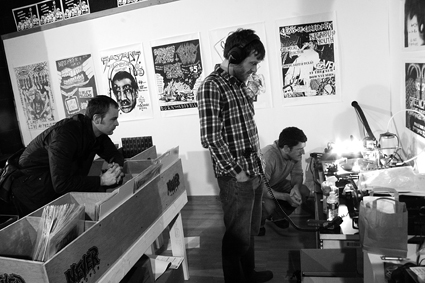
Never records, Ted Riederer
photo Ted Riederer
Never records, Ted Riederer
OBVIOUSLY BIENNALE FATIGUE HAD SET IN! I HAD DESTROYED MY FAVOURITE PAIR OF SHOES CRISS-CROSSING LIVERPOOL BUT WAS STILL HAUNTED BY THAT UNDER-NOURISHED SENSATION: SURELY THERE MUST BE MORE? AND WHERE WAS THAT MYSTERIOUS SOUND ART SHOW ANNOUNCED ON THE SMALL FLYER I KEPT SPOTTING IN VEGAN CAFES?
I knew I was getting close, somewhere on a cobbled side street just off the Rope Walks, in Liverpool’s manic club zone. I finally stumbled into a doorway with the correct address, but no, just a very funky record store, with a bunch of feral dudes setting up piles of well worn equipment. “Some kind of sound art show around here?” I ventured, “Sorry pal, maybe over the street like.” It looked interesting though, so I hung around a bit; there was even a record cutting lathe in there and heaps of old vinyl—but I was on a mission, my cultural stamina flagging and pressed for time, so across the cobbles I went.
The light switched on only a day or so later while I was discussing the Biennial with Asher Remy-Toledo the curator of No Longer Empty on the Road. I realised the funky record store was indeed an art project, but so convincing a simulation that even the roadies were duped!
Ted Riederer recreated his Never Records project which had made its debut in January 2010 in the old and abandoned Tower Records store in New York City. Riederer’s angle was to propose the record store as a site of social exchange and cultural production, part shop, part archive and part recording studio (hence the roadies with all that gear). During the Biennial, Never Records worked directly with the community, running performance and recording sessions and cutting and publishing vinyl—the local musos were very impressed!
No Longer Empty (www.nolongerempty.org) is a relative newcomer to the New York cultural scene but has already been astonishingly prolific. NLE is a volunteer-run program that takes over empty buildings and public sites, transforming them with temporary site-specific installations and events, often with little or no financial support. Not some flakey, mural painting hobby group, it is structured around professional museum curatorial practices, but is also plugged into the grass roots of artistic production in NYC and offers a platform for young arts professionals to volunteer their services in curatorial, management and PR roles. Asher Remy-Toledo, the co-founder and co-director of NLE, has recently branched out with an international version, NLE on the Road, with the first incarnation at Liverpool (so watch this space).
Okay, just across that cobbled street is a large semi-industrial building, either half-finished or half-demolished, another of those grand architectural projects that ran out of cash, another still-born investment. But just because it didn’t make it as a suite of IT or architects’ offices doesn’t mean it can’t resurrect as a great venue for sound art! Normally contemporary architecture makes a vile context for the sonic arts but this structure is so unfinished and labyrinthine that the 10 audio projects survive without too much cross-talk.
I head for the basement where traces of harmonic pulsing are seeping up the fire stairs. As I fumble around in the darkness of this bunker-like space the harmonics rise and fall, accompanied by swirling, circular traces of LEDs. The eyes acclimatise and the skeletal towers of Ray Lee’s Murmur come into focus, each topped by a rotating jib armed with a speaker, a visual ballet mechanique but sonically closer to the drone of a million industrious honey bees. Concerned about the work’s capacity to hypnotise, I head upstairs.
Turning a corner I narrowly miss falling into Phil Jeck’s Pool of Voices, a whimsical sculptural re-working of 1960s vinyl record players and paraphernalia. Jeck discovered three large pits sunken into the concrete floor and developed a site-specific work around them, literally turning sections into pools in which vinyl discs sink or swim, whilst others contain serried ranks of late valve or early transistor-powered turntables playing a chorus of voice fragments and synthetic sound. Jeck, a Liverpudlian who has worked with records and electronics since the 1980s, focuses on the excavation of meaning and poetry from the traces of history and memory that infuse abandoned technology, as one of his aptly titled prior works announces—Vinyl Requiem.
Leaving the domestic and anecdotal metaphors of the Pool of Voices, I enter a mausoleum-sized space to the sound of Old Glory and a visual horizon formed by five large and very black coffins. Giuseppe Stampone’s Play is inspired by the five countries that have contributed most effectively (and generously) to the collapse of the world economy. Play is a disarmingly simple work, at once theatrical and sinister and as such not unlike any normal funeral. This medley of national anthems is a wake for the wellbeing of millions in which profits have been privatised and debt has been made public—are you still proud enough to sing along?
I have run out of time (and space) and have to jump on a train (and plane) to get back to my own sound art show in Finland, but just before I go, around the corner from Lime Street station is another sound work in the historic Renshaw Hall, now incongruously (one might say savagely) gutted as a car park. Marina Rosenfeld’s soundscape Public Address No. 2 emanates from old-style spectral speakers mounted in the gods of the building, sweeping the transient vehicular traffic with fragments of an abstract composition. To broker a deal to install sound in a public space is one of the trickiest things ever, ergo the almost total paucity of permanent public sound-works. We make a polite and concerned tech-check with the lads in the pay booth and ask after their tolerance for really loud sound art. They grin; as we already know, Liverpool lads are pretty tough!
No Longer Empty on the Road, curator Asher Remy-Toledo, SQUAT program (Social Questioning Using Art Today), www.squatliverpool.com, Liverpool Biennale 2010, Liverpool, UK, Sept 18-Nov 27
RealTime issue #100 Dec-Jan 2010 pg. 38
© Nigel Helyer; for permission to reproduce apply to realtime@realtimearts.net
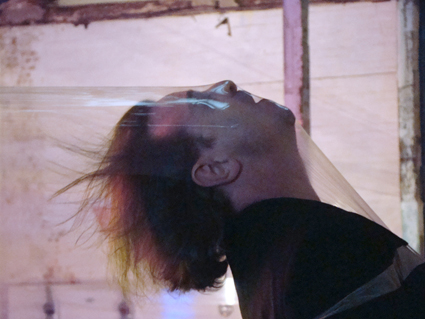
Johannes Sistermanns, SoundPlastic
photo courtesy of artist
Johannes Sistermanns, SoundPlastic
THE GUTTED QUEEN’S THEATRE IN ADELAIDE, A HERITAGE-LISTED GALVANISED IRON AND BRICK CAVERN WITH AN ASPHALT FLOOR, IS THE SITE FOR THE AUSTRALIAN EXPERIMENTAL ART FOUNDATION (AEAF) EXHIBITION (TO) GIVE TIME TO TIME, A GROUP SHOW SURVEYING EPHEMERAL AND TIME-BASED ART PRACTICES THAT HAVE EMERGED SINCE THE 1970S. COLOGNE-BASED ARTIST JOHANNES SISTERMANNS’ PERFORMANCE, IN TIME IS TRANSITION, TAKES PLACE AMONGST THE OTHER WORKS IN THE SHOW, INCLUDING HIS OWN INSTALLATION, INTUITION ROOM.
In the back corner of the theatre, lengths of kitchen clingwrap are tautly stretched between two pillars and the wall to demarcate a small space—the Intuition Room. Two piezo transducers attached to the wrap transmit a high-pitched but barely audible sound recording that lightly vibrates the stretched surface. The wrap reflects ambient light from other exhibits, overhead windows and the distant doorway. This fragile, whispering, Art Povera enclosure contrasts with the barren grandeur of the empty theatre, eliciting a sense of the uncanny.
Sistermanns enters from the far doorway pulling a thick roll of cling wrap, the end of which is attached near the entrance. He walks slowly, stretching the wrap to breaking point behind him, and more sound emanates from tiny loudspeakers in his pockets. He winds the plastic around another pillar and continues his walk, stopping occasionally, sometimes pushing his face into the wrap and singing a wordless falsetto through it that becomes a growl, vibrating it like a piezo and finding the theatre’s sonic resonance. He mimes eating the material before finally reaching the Intuition Room and so connecting the building’s entrance to this temporary space. The boundaries between performance and installation and between installation and site seem deliberately vague, as if they are a continuum. The slowness and abstraction of Sistermanns’ movement suggest powerful emotions on the verge of expression but ultimately withheld, inviting the audience to join in this pre-conscious and even cathartic moment.
Sistermanns later revealed that the sound is a mix of birdsong and ambient noise recorded at Oratunga in the Flinders Ranges, blended with ‘room tones,’ the standing waves created when sound is used to map a room’s sonic character. He has conducted performances at Oratunga in collaboration with architect and academic Gini Lee. This performance is an extension of that project, bringing to the city the sounds of the distant Flinders Ranges, a site that is significant for its Indigenous heritage and for being the location of some of the world’s oldest fossils. Time there is measured in eras.
Sistermanns’ 30-minute performance speaks of wrapping, not in the literal Christo & Jeanne-Claude manner, but symbolically, with the creation of a new space and the transient projection of sound into it to shift its form and character. Transparent plastic wrap can be made visible in the right light and, when transmitting sound, the insubstantial material acts as a carrier of information. Sistermanns has installed such work in a variety of locations and even in a garden to show how sound and space function in relation to each other. The location itself is appropriated as a novel element of the work and renews the audience’s perception of that space. The addition of the performance makes the awareness of sound in space still more acute, even poignant.
Australian Experimental Art Foundation, (To) Give Time to Time: Johannes Sistermanns, Intuition Room and In Time is Transition, Queen’s Theatre, Adelaide, Sept 11
RealTime issue #100 Dec-Jan 2010 pg. 40
© Chris Reid; for permission to reproduce apply to realtime@realtimearts.net
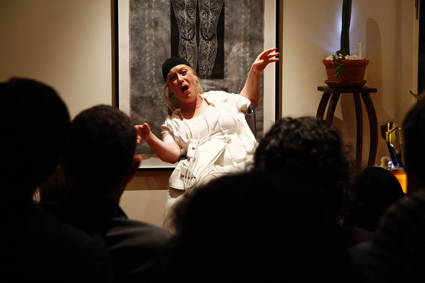
Carolyn Connors, The Itch, Chamber Made Opera
photo Daisy Noyes
Carolyn Connors, The Itch, Chamber Made Opera
I GOT LOST, THE CHAMBER MADE OPERA SIGN HAD FALLEN DOWN IN FRONT OF THE ELWOOD HOME, AND I WAS GREETED AT THE DOOR BY A LABRADOR PUPPY, BUT EVENTUALLY I WAS MILLING AROUND THE OPEN PLAN LIVING SPACE WHERE THE ITCH WAS TO BE STAGED.
Chamber Made Opera’s initiative is bold and timely: to address the arts’ fixation on government subsidy by producing a series of chamber operas in living rooms around Melbourne. The audience commission the work through buying tickets, while the host provides the site and context for the performance. As the lights of Fiona Sweet and Paul Newcombe’s kitchen were flicked on and off, the patrons seated themselves for the itchiest night of their lives.
The 19th century music theorist Eduard Hanslick diagnosed as “pathological” music whose principal effect on the listener was a “morbid irritation of the nervous system.” Beyond the physical excitations of rhythm and melody, music needed form if it was to satisfy the mind as well as the body. Though Alex Garsden’s agitating timbral creations for viola, cello, double bass, and female voice are fitting examples of Hanslick’s “pathological” music, they find their form as the physical side of an allegory, which I would like to call the “itch-scratch” model of the creative process developed by director Margaret Cameron. If Garsden’s music provides the itch, then the scratch is the dramatic form provided by Atul Gawande’s article from The New Yorker, June 30, 2008. If the itch-scratch model applies to all creative activity, then it also applies to Garsden’s compositional process. His use of both traditional and graphic scoring techniques not only represent the creative itch, but also influence the dramatic form of the work.
Gawande tells the story of M who awoke one morning with an itch on her scalp. The itch would not go away: not after medication, surgery nor scratching through her skull to her brain. Gawande likens M’s itch to a phantom limb resulting from a neuropsychological misrecognition of what is really going on in the body. Phantom itches are particularly easy to conjure: I have scratched my scalp three times just writing this paragraph. As The Itch demonstrates, Hanslick’s physical and Gawande’s mental pathologies are closely connected; thinking words such as ‘itch’ and ‘scratch’ is nothing compared to hearing Garsden’s score.
Himself informed by a bout of chicken pox during the composition period, Garsden conjures phantom itches using the most physical of musical resources. With a string trio scraping, rasping and rubbing their instruments for the better part of an hour, the composer makes it impossible to forget that every bowed instrument comes with half a metre-odd of taut, coarse, sticky, powder-coated hair. There are moments of simply unbearable tension produced through brutal, grinding bow-strokes contrasted with niggling tremoli on the edge of hearing.
Performer Carolyn Connors’ seemingly limitless timbral repertoire carries the audience through M’s bildungsroman-like battle with the itch. The audience feels a visceral sympathy with the woman as she resists the temptation to scratch with hair brushes, paint scrapers, gardening forks and bread knives. At least one person had to excuse herself in a (I like to think) sonically induced coughing fit. Though uncomfortably effective in its physical communication of itchiness, Cameron believes there is more to The Itch than meets the ear.
To the director, the itch is a “creative proposition,” an irresistible desire to create that cannot be directly satisfied. As Cameron suggests, “you can develop a relationship to it, a congruent relationship, a kind of equivalence between form and content.” M’s “congruent” answer to her itch is religion, a non-resolution that sees her exhaustedly croak a creepy chorale, holding aloft a crucifix of wire brushes. The pained chorale gives momentary form to her fathomless itch. She holds the crucifix immobile, as a ward against the temptation that previously saw her draw brushes and knives closer and closer to her vulnerable skin, or carve open a grapefruit filled with viscous, green fluid.
If M seeks momentary respite from her affliction through religious rituals and artefacts, Cameron seeks to allay the creative itch with dramatic structure, a process that she frames in terms of making dramatic sense of Garsden’s music. However, Garsden’s own congruent itch-scratch informs the dramatic structure of The Itch through his juxtaposition of traditional and graphic scoring techniques. Garsden’s graphic scores are collages of blood, bone and brain, unfortunately obscured from the audience’s view by the performers’ music stands. The performers read the scores using parameters set by Garsden. The horizontal axis determines duration, while gradations of shade and hue indicate timbre and pitch respectively. As Garsden noted, while the traditional score was made from a sonic basis by sampling and arranging workshop recordings, the graphic scores were produced through a primarily visual process. Like M and her crucifix, Garsden’s graphic resolution to the musical itch evades the fraught business of musical scratching.
In the context of The Itch, Garsden’s juxtaposition of traditional notation and graphic scoring results in contrasting moments of intense, timbral sophistication and freer, wandering movements. While performers and composers attempt to make the rendering of graphic scores as precise as possible, much relies upon a performer’s ability to improvise around a score’s parameters. In this instance, Garsden gives the performers freedom to wander on the vertical axis of the score as they move horizontally through the image, gaining access to different timbres and pitches. The performers also improvise dynamics and the techniques they use to render the timbral and pitch specifications. Providing moments of reflective calm between Connors’ tortured recitatives, they add interest to a performance that threatens to become a too-literal setting of Gawande’s article. Graphic and traditional scoring then form a cross that informs the dramatic structure of the piece. With its restless combination of dramatic form and pathological music, The Itch is itself an example of creative congruency.
Chamber Made Opera, The Itch, composer Alex Garsden, director Margaret Cameron, performer Carolyn Connors, viola Phoebe Green, cello Judith Hamann, double bass Anita Hustas, conductor Brett Kelly; private home, Melbourne, Nov 19, 20
RealTime issue #100 Dec-Jan 2010 pg. 40
© Matthew Lorenzon; for permission to reproduce apply to realtime@realtimearts.net
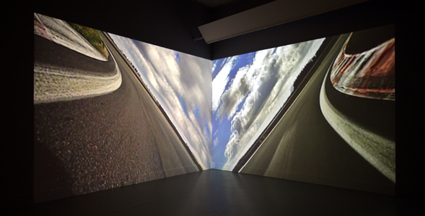
Accelerated Geographies, Alex Monteith
courtesy the artist
Accelerated Geographies, Alex Monteith
ALEX MONTEITH’S ACCELERATED GEOGRAPHIES IS ONE OF ONLY THREE SHOWS IN THE GOVETT-BREWSTER GALLERY’S 40-YEAR HISTORY THAT HAS COMMANDEERED THE ENTIRE VIEWING SPACE. AT THE ENTRANCE, VISITORS ARE ISSUED WITH FLUORESCENT YELLOW EARMUFFS, THOUGH MOST PREFER TO ABSORB THE FULL POWER OF THE HOWLING AND THROBBING THAT PERMEATES THE GALLERY SPACE.
Monteith has put the audio back in audio-visual, and long before you have sighted the full spectrum of multi-screen video installations, your eardrums have become acquainted with their soundtracks, blending subtly, and not so subtly, into a sonic whole that makes the gallery pulsate.
Works are numbered but there is no need for sequential viewing. There is no ‘narrative’ and in a sense all Monteith’s works do the same thing differently, riffing off each other as different angles or points of view trained on the same territory. And territory is one of the things Monteith’s work is all about.
It’s tempting to ascribe the artist’s fascination with the politics of place to the fact that she grew up in Northern Ireland, which perhaps also offers a clue as to why military vehicles (helicopters and airplanes) figure so prominently in her landscapes. It might also explain her deep sympathies with the Maori sovereignty movement, in which issues of land, ownership and occupation remain barely healed wounds.
But there’s another, more immediate aspect to Monteith’s practice which both augments and destabilises her politics; her love of danger and the throbbing machine. Not since the Italian Futurist Marinetti eulogised speed as the only beauty worth celebrating and the motorcar as its ultimate incarnation, has an artist derived such thrills from where the rubber meets the road. Apart from the surfing video Red Session #2, 2009 (Monteith was herself a surf champion), the entire exhibition can be read as a love letter to the internal combustion engine. Unlike Marinetti’s impassioned manifesto, however, Monteith’s digital love letter comes post-peak oil, where the future of excess consumption is uncertain at best. But Monteith’s political persuasions are the polar opposite of the proto-Fascist Marinetti, which makes her 21st century reworking of his macho-machinist lexicon all the more confounding.
But therein also lies the key to her success—for Monteith the petrol-head, the adrenaline junkie is deeply engaged in the communities of pilots, surfers, activists and motorcyclists she portrays. This isn’t some relational art junket where the artist travels the globe forcing dictatorial outcomes upon people she’ll never see again. Alex Monteith is committed to the sports she portrays; whether surfing or motorcycling, she’s just as likely to be in shot as out of it. When this attention is transferred to another community of expertise, for example the Royal New Zealand Air Force, her up-close and personal experiences with the technicalities of risk and speed allow her access to worlds that remain closed to most of us. Speaking a kind of universal language of controlled acceleration, she is, in effect, one of the blokes. Yet her non-bloke status gives the works a subtle nuance, another level in the discourse around insider/outsider, another perspective on territory and community.
The first work the viewer is confronted with is also the most recent, Composition with RNZAF No. 3 Squadron Exercise Blackbird For Three-Channel Video Installation, 2010 (Monteith’s titles are all very Kosuthian in their ‘what you read is what you get’ logic). Three Air Force Iroquois helicopters take off from the South Island’s Leese Valley, tussock grass billowing like tousled fur. I use the furry metaphor deliberately, because for a show all about machinery, there’s a strangely animalistic evocation in the gallery, a growling presence. Perhaps it’s the wildness within that we designate as animal because it scares us? The helicopters are plenty scary as they hover, black and brutish, over misty mountain peaks, the sublime natural landscape matching the magnificence of the war machines. The US Military named the majority of their helicopter models after Native American tribes, and ‘Iroquois’ graced the machine that is forever linked to the Vietnam War, a bitterly ironic label given its use in the attempted subjugation of an indigenous population.
The flipside to military might occurs in a quiet room, where Red Session #2 laps away along four screens, while two protest videos play back to back on a diagonal screen. These aren’t images of people marching or shouting, rather, in keeping with Monteith’s predilection for the motor, and in the era of the shopping mall and the drive-thru, they are vehicular. One features two red Land Rovers flying Tino Rangatiratanga (Maori sovereignty) flags in the Taranaki region, while the other depicts a small phalanx of vehicles, similarly decked out, being escorted by police over the Auckland Harbour Bridge on Waitangi Day 2008 (subsequently, the government decided to allow the flying of the Tino Rangatiratanga flag from the bridge on our national day). Monteith has dedicated Red Session #2 and the Taranaki protest work to the late Te Miringa Hohaia, who was a bridge between Maori and Pakeha activist and artist communities. Hohaia put Parihaka back on the map as the legendary Taranaki site where Maori prophets Te Whiti and Tohu gave birth to passive resistance while Gandhi was still a boy. Parihaka, as much as the Govett-Brewster, has brought artists of a political persuasion to Taranaki, particularly the collective Local Time, of which Monteith is part.
In all this talk of communities, however, let’s not forget the art community, to whom Monteith pays homage with the intense rigour and formalism she brings to each project. The video screen can be likened to an abstract picture plane, and nowhere is this more apparent than Ascents and Descents in Real Time, V1 and V2, 2008, in which motocross riders traverse a sand dune, carving brushstrokes across a great golden canvas. In Composition with RNZAF Red Checkers for Five-Channel Video Installation, 2009, the five yellow tail wings maintain a central verticality while the landscape tilts, other planes loop and veer, and contrails billow across the blue sky. And in Looping Manoeuvre with Shaun Harris and Onboard Dual-Cams for Two-Channel Video Installation, 2008, the motorcycle champion creates lurching diagonals, which are either mesmerising or sick-making, depending on your constitution. It’s a kind of Stargate Sequence for would-be racers, an opportunity for voyeuristic thrills. But what differentiates Monteith is that she is not a voyeur, but a participant. Her work is about delivering her audience that coveted point-of-view shot, so that they, too, can be up close and personal with the action. Her work does not describe these worlds, it lives these worlds, presenting them to us with palpable integrity.
Alex Monteith, Accelerated Geographies, Govett-Brewster Art Gallery, New Plymouth, Taranaki, New Zealand, Sept 25-Nov 28; www.govettbrewster.com/
RealTime issue #100 Dec-Jan 2010 pg. 41
© Tessa Laird; for permission to reproduce apply to realtime@realtimearts.net
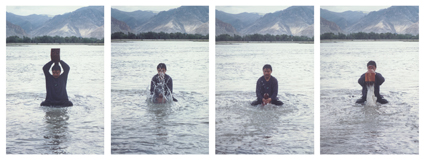
Song Dong, Stamping the Water 1996
courtesy the artist and Beijing Commune
Song Dong, Stamping the Water 1996
RIVERS EVOKE JOURNEYS AND A SENSE OF PASSAGE. ON A QUIET SUNDAY MORNING AT THE CAMPBELLTOWN ARTS CENTRE, IT WAS THE GRINDING WHIR OF A MOTOR THAT FIRST DREW ME TOWARD JUN NGUYEN-HATSUSHIBA’S HALLUCINATORY TRIPARTITE FILM, THE GROUND, THE ROOT AND THE AIR (2004-07).
I soon found myself transported to Laos as I followed a flotilla of boats carrying art students painting at their easels, gliding down the Mekong, the brisk pace of the boats and the amplified volume of their engines at odds with the slow and tranquil activity of making art. The contradiction alluded to the ways modernity can run in opposing currents to tradition and was just one of the many explorations into the psychological and physical terrain of the river that visitors were invited to undertake at the Arts Centre’s latest exhibition, The River Project.
In fact, the notion of opposing currents offers an apt avenue into not only The River Project but also the debate over waterways generally, as the current difficulties the Murray Darling Basin Authority faces in negotiating competing economic and environmental demands clearly demonstrate. The River Project didn’t deal specifically with this river system: however it did take the Campbelltown Upper Georges as its starting point, then extended its reach to arteries throughout the Asia-Pacific from China, Korea, the Philippines and India, to Vietnam, Papua New Guinea and Laos, offering a kaleidoscopic view of the diverse factors driving rivers toward crisis point. Yet as much as this interdisciplinary program exhibited a strong environmental conscience, it didn’t feel like an eco art show since curator Binghui Huangfu appeared more concerned with engagement than activism. In this way, most artists departed from literal responses in favour of more open-ended and sophisticated styles of visual poetry, resulting in a surprisingly diverse, nuanced and frequently absorbing program.
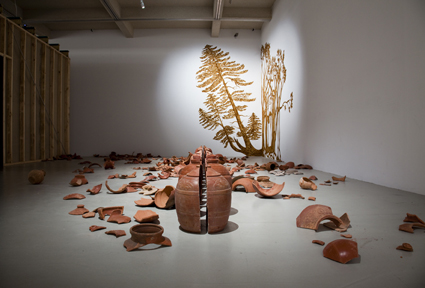
Reena Kallat, 2 Degrees
courtesy Campbelltown Art Centre
Reena Kallat, 2 Degrees
Particularly affecting was Reena Kallat’s installation 2 Degrees (2010), which responded to the geopolitical volatility of the Indus River Basin on the border of India and Pakistan where most recently disastrous flooding from severe monsoonal rains cost thousands of lives and rendered over 20 million people homeless. With just a soundtrack of gushing water, a hybrid tree—half Indian Banyan, half Pakistani Deodar—painted directly onto the wall with henna and a row of ceramic vessels seismically split down the middle and marooned in a sea of broken shards, Kallat imaginatively transported the viewer to a flooded riverbank, eliciting empathy via the senses. Drawing the viewer into the aftermath, the installation rendered universal the sense of loss and vulnerability humans experience at the hands of natural disasters as well as the painful divisions that can be forged between nations over water.
The displacement of human communities and natural resources was likewise conjured elliptically in Zhuang Hui’s suite of black and white photographs which depicted geological close-ups of holes in the ground the artist had dug over a decade ago in regions to be affected by the Three Gorges Dam, Longitude 109.88E and Latitude 31.09N (1995, 2008). The holes now deeply submerged, video footage of the Yangtze on the opposite wall pointed to the cause and effect relationship, the void in between creating an air of elegy and melancholia. Vietnamese artist Tiffany Chung, meanwhile, responded to annual flooding of the Mekong with varying degrees of light and shade in a series of five topographic maps including one charming mixed media work that mapped the migratory routes of local fish species. Like a spider spinning cobwebs across a canvas, Chung plotted a dense network of sprawling tracks with pearlescent beads, trails of brightly coloured stitching and clusters of silver grommets, offering an optimistic and joyful celebration of the rich diversity of life that abundant water breeds.
Works by Cao Fei, Ringo Bunoan, Minouk Lim and MM Yu among others exhibited a strong focus on Asia. Meanwhile a selection of specially commissioned works by prominent Sydney artists responding to the local landscape reflected the program’s role as a key component of the three-year Upper Georges River Urban Sustainability Project. Indigenous artist Graham ‘Nudge’ Blacklock’s painting The Point, The Georges River (2010) employed highly expressive, radiating brushwork to capture the region’s spiritual resonance while Elisabeth Cummings’ deft, painterly treatment revealed the land’s lyrical beauty to be marred by evidence of subsidence from longwall mining. Along with a suite of cryptic photographs by Bonita Ely that married reportage with more poetic meditations, these works offered aesthetically interesting inroads to discussion, although their location at the entrance, rather than in the main gallery spaces integrated with the international works, made them appear somewhat adjunct.
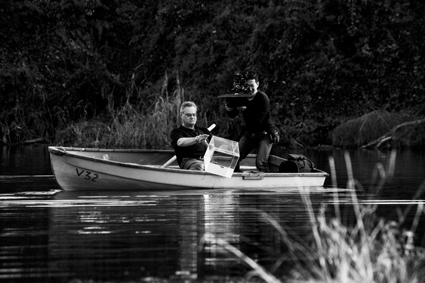
Mike Parr, Gotaro Uematsu, Pure Water Into Polluted Water 2010, Georges River, performance still
photo Silversalt photography, courtesy the artist and Anna Schwart
Mike Parr, Gotaro Uematsu, Pure Water Into Polluted Water 2010, Georges River, performance still
Given rivers have long symbolised flux and impermanence, the restaging of three seminal performance works was particularly well suited to the exhibition’s theme and highlighted the unstable meanings of performances over time. In addition to Chinese artist Song Dong’s ongoing gesture of writing calligraphy with water, Water Diary (2010), and the repetition of a 1995 action of scrubbing down frozen blocks of polluted water by the Beijing-based Yin Xiuzhen, Washing River (2010), an invitation was also extended to Sydney artist Mike Parr to revisit a performance from 1971, Pure Water into Polluted Water. Initially the action saw Parr drop a plastic bag filled with distilled water into the Georges River to produce a Minimalist-style “hole in nature”; however, when Parr came to revisit the gesture he soon realised the plastic bag had become a too heavily loaded material. To regain some of the gesture’s initial conceptual potency he revisited the action with a clear perspex cube and in an accompanying community discussion noted how this sinking message in a bottle epitomises our psychological problem as humans—“we want to have an effect.”
Community involvement took an unusual turn, too, in the form of a formidable Maori Waka canoe restored and carved by young local job seekers, led by Verdun Walker and Peter T Elers, and moored in one of the gallery’s main spaces amidst an installation of contemporary and traditional art from Papua New Guinea, The Sepik River Project. Something of an exhibition within an exhibition, and one that could warrant its own review, The Sepik River Project was a fascinating exercise in cross-cultural exchange, presenting cultural artefacts acquired by independent curator Dr Susan Cochrane alongside portraits painted by Port Moresby artist Jeffry Feeger on a recent trip to the Sepik River. The pair had in fact navigated their journey along the river by canoe. There were also paintings created by local artists when Feeger and Cochrane gifted the Sepik some contemporary art materials. According to Cochrane, “within two days, some 30 paintings and drawings of Kambot ancestral stories were produced, and the painting session was still going when it was time to leave.”
Making my way out of the gallery, I paused to admire a tableaux of 36 photographs documenting another performance by Song Dong, Stamping the Water (1996). Propped on the surface of the Lhasa River, the artist lifted an archaic wooden seal carved with the Chinese character for water high above his head then plunged it with great physical exertion into the water as if trying, however futile the effort, to imprint the uncontainable. Like Parr’s Pure Water Into Polluted Water, this was an action of conceptual sophistication that also held something of the charm of riddles. It was the slippery, more mysterious and elusive moments like these that arguably proved The River Project’s most compelling. If it lacked anything it was a sense of the fury and passion surrounding contested and polluted waterways; however by engaging the imagination these quietly powerful works revealed how rivers are not only vital natural conduits and givers of life, but also deeply connected to memory, desire, cultural identity, spiritual pilgrimage and mental transformation. When it comes to reasons to get the balance right to ensure their future survival, how many more do we need?
The River Project, curator Binghui Huangfu, Campbelltown Arts Centre, Sydney, Aug 28-Oct 24
RealTime issue #100 Dec-Jan 2010 pg. 42
© Ella Mudie; for permission to reproduce apply to realtime@realtimearts.net
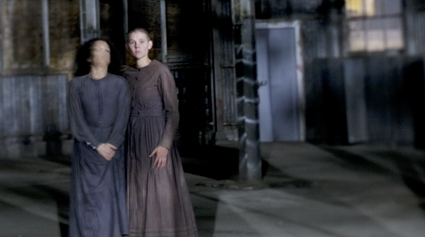
Night Watchman Portrait #2, Cordelia Beresford, Nightshifters
courtesy the artist
Night Watchman Portrait #2, Cordelia Beresford, Nightshifters
IN THE EARLY DAYS OF NOVEMBER, AS TWILIGHT REACHED PERFORMANCE SPACE AT CARRIAGEWORKS SO DID THE WEATHER. THE CHANCE ACCOMPANIMENT OF RAIN TO NIGHTSHIFTERS, BEC DEAN’S THOUGHTFULLY CURATED SHOW OF MOVING IMAGE INSTALLATIONS, SERVED TO HEIGHTEN THE EXHIBITION’S EMPHASIS ON THE INTERRELATIONSHIP OF SPACE AND SUBJECTIVITY. A BACKDROP OF ENSUING DARKNESS AND FLEETING SILHOUETTES ALONG WITH THE SEASONAL ELEMENTS ADDED TO THE ROMANTIC MISE-EN-SCÈNE OF THE SHOW’S NIGHTTIME STAGING ACROSS THE FORMER EVELEIGH RAIL YARDS.
Despite the theatricality of the site’s industrial ‘ruins’, Nightshifters did not engage in nostalgic rehearsals of the past. Instead, the eight exhibiting artists were invited to broadly respond to the location, both within the gallery complex and on the grounds outside, in ways that drew upon and extended their existing practices and conceptual concerns. As such, the openness of Dean’s curatorial brief meant that the exhibition’s trajectory didn’t develop into an overdetermined history lesson. The show responded critically to the site’s immediate and comparative geography through a diverse staging of personal memories and public histories, with notable works by Cordelia Beresford, Kate Murphy (with Bill Hogios) and John Tonkin.
Filmed on location at Cockatoo Island and relocated inside CarriageWorks, the architectural kinship of Beresford’s work Night Watchman (2010) threaded subtle allusions to the industrial and cultural histories shared between these sites. Both locations were originally places used by the first Australians, the Eora people, before colonial invasion. In the 19th century the sites were developed industrially; Cockatoo Island went through myriad uses, from convict prison to girls’ reform school and maritime building yard. In a small, free-standing enclosure resembling a cell, Beresford’s three-channel video of still and moving images presented the imagined journey of a contemporary night watchman’s (Djakapurra Munyarryun) encounter with the colonial past of Cockatoo Island. Against a sustained reverberation of vocalised sound, the ritualistic dance performance of the watchman drew forth the ghosts of two young women (Narelle Benjamin, Miranda Wheelan), who appeared as previous tenants of the island’s reformatory. The assemblage of empathic movements shared between the three performers across each screen presented a sombre meditation on the marginalised histories and spaces of Australia’s colonial heritage.
Kate Murphy’s Yia Yia’s song (2010) also drew upon the concept of shared memory. Using an eight-channel video and nine-channel sound installation, the work’s narrative centres upon a found acoustic recording of Diamanda Psihogios, the grandmother of Bill Hogios, Murphy’s collaborator on the piece. Like much of Murphy’s previous work, such as Prayers of a Mother (1999), Yia Yia’s song explores the role of witnessing and memory in response to a central familial figure. The installation of the work within a dark and otherwise empty train shed lends an operatic quality to Psihogios’ singing, as her sonorous tones fill the cavernous space. While it plays, the viewer is able to watch nine video portraits of the Psihogios’ family, filmed listening to a recording of the song. As each recorded face maps and mirrors a series of emotions back to the viewer, the interplay between the filmed and live audience creates an uncanny atmosphere of intimacy and pathos.
When the vocals conclude, Psihogios’ son and daughter-in-law, presented on a raised split screen at ‘the head’ of the semi-circular installation, proceed to reflect on the song’s meaning and relevance to their own lives. Through their analysis, it becomes apparent that Yia Yia’s song was their grandmother’s tale of grief over her children’s migration from their homeland of Greece to Australia. Charting the course of domestic history through a genealogy of embodied remembrances and shifting stories, Kate Murphy’s work traces a compelling exploration of loss and its counterpoint within the home.
Closer: eleven experiments on proximity (2010), by John Tonkin, also placed the viewer’s body in a series of affective encounters with the everyday. Drawing on the unmonumental poetics hidden within life’s daily habits, Tonkin’s two video projections on opposing walls of a purpose-built corridor screen a series of vignettes based on ordinary objects and common spaces. Whether it is a kettle beginning to boil, a plastic water bottle caught in the step-feed of an escalator, or the quiet grace of a young woman’s head resting on a laminated menu in a restaurant, the durational dynamics of each scene are intensified through Tonkin’s placement of interactive sensors within the installation. Building on his ongoing interest in the interstices of time that make up our cumulative experience of duration and motion, the work choreographs the viewer’s body against the changing speed of the scenes as they play. Running or walking, advancing or retreating in proximity to the work serves to change the tempo and narrative progression of each video, from fast to slow, forwards or backwards, respectively. By using the audience as a wayward metronome, Tonkin highlights the body’s liminality in relation to time’s unfolding.
The constant slippage between past and present narratives underpinned the exhibition’s structure as a whole, with each work operating as an internalised conversation across time. This self-reflexive structure offered provocative insights into the performative threshholds of the moving image as well as the opportunity to connect with CarriageWorks as a repository of the city’s living history through its reinvention. Like the imagined world of the somnabulist lost between night and day, Nightshifters gave viewers a way to navigate and reconnect with the changing history of the space against the imagined certainty of life’s waking routines.
Nightshifters, curator Bec Dean, artists Cordelia Beresford, Alexis Destoop, Sam James, Angelica Mesiti, Kate Murphy, Eugenia Raskopoulos, Dominic Redfern, John Tonkin; Performance Space, CarriageWorks, Sydney, Nov 4-13
RealTime issue #100 Dec-Jan 2010 pg. 43
© Tanya Petersen; for permission to reproduce apply to realtime@realtimearts.net
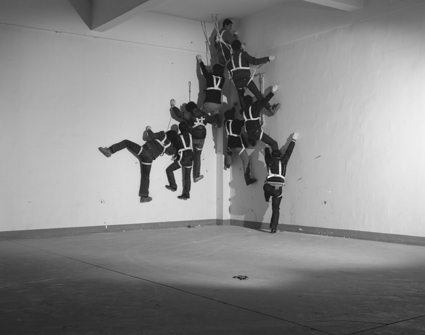
still from Total Eclipse (2010), Gao Shiqqiang
courtesy the artist and Magee Gallery, Beijing
still from Total Eclipse (2010), Gao Shiqqiang
IN THE LEAD UP TO THE 2008 BEIJING OLYMPICS AS CHINA’S CAPITAL RAPIDLY REDEVELOPED TO GREET WESTERN CAPITALISM, SO DID ITS ART SCENE. CHINESE CONTEMPORARY ART BECAME THE ‘NEXT BIG THING’ AS GALLERIES AND ART ZONES OPENED UP ALL AROUND THE CITY, WITH INTENSE INTEREST FROM INTERNATIONAL DEALERS AND COLLECTORS. IT ALSO SAW THE ADOPTION OF VIDEO AS A MEDIUM BY MANY MORE CHINESE ARTISTS. LAURENS TAN, AN AUSTRALIAN ARTIST OF CHINESE ORIGIN RELOCATED TO BEIJING IN 2006 AND THE VIDEO EXHIBITION, ARENA, WHICH HE HAS CURATED FOR THE HAZELHURST GALLERY, REFLECTS ON WHAT HAS HAPPENED IN BEIJING AFTER THE INITIAL FRENZY.
Not surprisingly, many of the works exhibited deal with the changing cityscape and the built environment. The most engaging of these is Nan Hao’s Chi 3 (2008) in which Hao performs Tai Chi in the middle of eight lanes of traffic. While it could be seen simply as an act of bravado, Hao’s performance is humble and contained, shifting through small gestural sequences occasionally obscured by large trucks. At one point he holds his hands forward in a stance of resistance, and for a fleeting moment we think that he has succeeded in stopping the oncoming cars, but it’s the traffic lights that have this ultimate power. The footage is low quality, but it adds a sense of intervention and immediacy to this simple yet powerful work.
Beijing Ballet (2010) by Allan Chawner explores similar territory. An Australian artist, in-residence at the Red Gate Studios in Beijing, Chawner has captured a street scene in moody dusk light. Watching the ebb and flow of traffic, he focuses on a man on a bicycle carrying an unbelievably large load. Stranded in the sea of cars he exhibits patience similar to Hao’s, however Chawner aestheticises the experience by replacing the traffic sounds with a version of Debussy’s Clair de Lune. The music heightens and poeticises the visual material but, verging on cliché, steers the piece towards a romanticised western vision of the contemporary east, in effect flattening the power of the original footage and, played at volume, it dominates the gallery space.
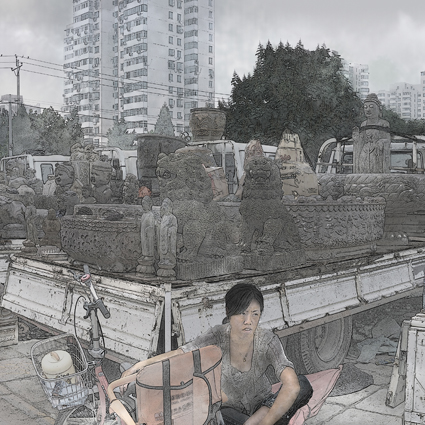
Beijing Handscroll (detail, 2009), Miao Xiaochun
courtesy the artist
Beijing Handscroll (detail, 2009), Miao Xiaochun
Also using Beijing streetscape as his material is Miao Xiaochun in the photomedia work Beijing Hand Scroll (2009). Drawing on the ancient art of hand scrolls, which by tradition depict cityscapes in intense detail and can reach to over five meters in length, Xiaochun has used a 360-degree camera to capture panoramas of Beijing streets. Exhibited as stills over eight screens, these panoramas illustrate city crowds, street markets, decrepit lanes and new high-rise developments. The images are manipulated using something like the ‘find edges filter’ in Photoshop creating a density of detail that resembles etching. The images of humans are treated with a variety of smudging tools, giving both a sense of movement and a dreamy insubstantiality to the figures, in contrast to the precise representation of their environments. As you can never take in the whole image at once, the depth of detail is both fascinating and overwhelming. Further exploration of Miao Xiaochun’s vision of the city was not possible as his interactive work, Bejing Index (2009), was not functioning.
Wang Qingsong’s Skyscraper (2008) is perhaps the most explicit in its presentation of the rapidly changing environment. A time-lapse exploration of a building growing into the sky, the work takes on more weight when research reveals that the artist and 40 workers in fact built the apparent skyscraper over a month, specifically for the shoot. This level of commitment is perhaps what make’s Qingsong’s work particularly impressive.
In Ironman (2008), Qingsong himself appears to be repeatedly beaten around the head until he is bloody and disfigured, hair and teeth missing, yet still laughing at his oppressors. The sharp rhythmic editing and time-lapsing of images makes the work shockingly brutal. The angle of the head to the camera references an old propaganda poster that prompted people to live with strength and dignity in the face of adversity. Qingsong’s joyous expression at the end is ambiguous—is he laughing victoriously or has he cracked under the relentless violence?
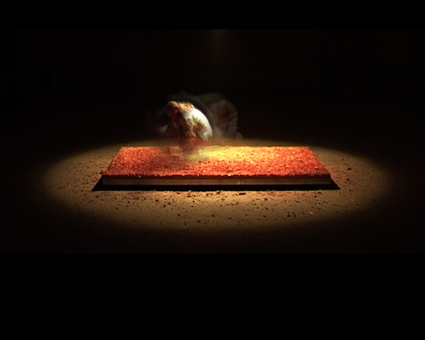
123,456 Chops (2008), Wang Qingsong
courtesy the artist
123,456 Chops (2008), Wang Qingsong
However Qingsong’s third work, 123,456 Chops (2008) is even more disturbing. In a darkened space a pool of light illuminates a large wooden platform. A man enters with the body of a dead goat and chops it into pieces with two cleavers, as if preparing it for cooking. The chopping continues, but now in time-lapse—over many hours the meat is diced, minced and pulverised and it is finally sprayed around the entire space, creating a velvety red carpet. Qingsong presents this obsessive behaviour as a means to vent “anger, violence, suffocation, sadness and disappointment” (artist statement). The work certainly raises questions about sanity and violence, and how a society deals with or, in fact, contributes to these.
Animation also featured strongly in Arena. Two works by Rei Li, one of Beijing’s up and coming artists, employ a quirky hand-drawn approach that playfully explores ideas of conformity. In Magic Cube and Ping Pong (2010), figures with mixed up Rubik’s Cube heads wander through an intricate futuristic city but run the risk of being set to normal—all colours in order—unless saved by the touch of love and a ping-pong ball. Each to their own metaphor. His second work, Pear and Alien (2008), is particularly visually appealing: drawn only with red and blue pens on graph paper, it explores our fear of the other, which is revealed to be just ourselves turned upside-down.
Wu Junyong (previously featured in Mu:Screen at the UTS Gallery, RT98) also contributed a series of animated works, Carps (2007), When We Are Rich (2005) and two interactive pieces, Central Park (2006) and Pixel Underground (2007). This artist’s idiosyncratic symbology is dominated by naked figures, each wearing a dunce’s cap: they expose their phalluses, wave flags, urinate or blow money out of their arses. Junyong’s absurdist scenarios offer incisive criticism of nationalism, capitalism, greed and decadence. Zhang Xiaotao’s Scar (2009), which draws more on 3D animation techniques, is particularly impressive in its exploration of the macro and micro, as the POV vision zooms across landscapes and delves deep down into the cellular level in gaming style, exploring a tangled environment, half reality, half hallucination. The work was diminished somewhat by an inaudible soundtrack.
With 21 works works in total, several approaching feature film length, it was not possible to view everything in its entirety. Perhaps a screening program would have been more beneficial for some works such as Total Eclipse (2010) by Gao ShiQiang. Presented in black and white, shot at high-frame rates and beautifully lit for noirish effect, it presents a series of poetic metaphors. Factory workers and their boss, standing in a circle, gradually begin to laugh and float up towards the ceiling. Another man stands laughing amidst his possessions, strewn about in total chaos, but then all the objects gracefully return to their rightful order—the reversed footage revealing that the man himself caused the disorder in the first place. Perhaps the most potent image is of a group of people ‘rock climbing’ into the corner of a low-ceilinged room, clustered like a hive of bees. This image resonates for Arena: A Post Boom Beijing as a whole— an exhibition which offers an intriguing insight into a nation that is in a complex process of renegotiating the individual’s aspiration within the collective pursuit of national prosperity.
Arena: A Post Boom Beijing, curator Laurens Tan, Hazelhurst Regional Gallery and Arts Centre, NSW, Oct 16-Nov 28
RealTime issue #100 Dec-Jan 2010 pg. 44
© Gail Priest; for permission to reproduce apply to realtime@realtimearts.net
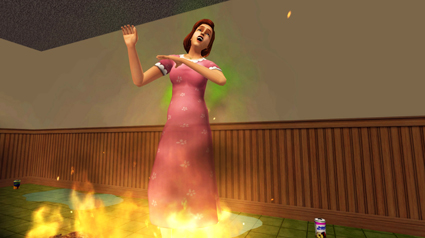
Homesteads, 2009, Chris Howlett
courtesy the artist
Homesteads, 2009, Chris Howlett
THIS INSIGHTFULLY CURATED AND COMPELLING EXHIBITION BRINGS TOGETHER SEVERAL ARTISTS WHOSE WORK EXPLORES OUR SOMETIMES DESPERATE NEED TO EXPRESS UNHAPPY THOUGHTS AND TALK TO SOMEONE. TAKEN TOGETHER, THE WORKS EXAMINE SIGNIFICANT ISSUES IN MENTAL HEALTH AND PERSONAL RELATIONS IN A COMPLEX, ELECTRONICALLY MEDIATED WORLD. VOCAL THOUGHTS IS GREATER THAN THE SUM OF ITS PARTS, ACTING LIKE A CUBIST’S ANALYSIS OF AN OBJECT, IN THIS CASE HUMAN PSYCHOLOGY, IN WHICH WE SEE MANY FACETS SIMULTANEOUSLY.
Firstly, Daniel Johnston’s drawings of a fantasy world of comic book heroes such as Captain America and his enemies depict life as a contest between good and evil. These cartoons question the heroes we turn to for aid—Captain America might represent a USA unable to deliver promised assistance. Johnston is best known as a musician and his art is an alternative voice. In the context of this exhibition, the story of his apparent mental health issues prompts us to address the nature of society’s response to those calling for help.
In Anna Davis and Jason Gee’s video Biohead Actualised (2008), a ventriloquist’s dummy lectures us on the power of positive thought, for example, “think wealth,” “poverty is a mental disease” and “never discuss your problems with anyone except a financial counsellor.” The dummy implies control by unseen forces, and the work parodies self-help books and critiques the materialist values that conflate health with wealth. The video screen can also be seen as a mirror, where the viewer becomes the dummy, helplessly parroting empty liturgies that become increasingly negative and disturbed, like our own inner dialogues. Adjacent is Kate Murphy’s video The Appointment (2009), showing a consultation with a psychologist from the client’s perspective. The therapist asks typical questions and pauses while we privately answer, perhaps revealing more to ourselves than we would to a real psychologist. But, juxtaposed with Davis and Gee’s creation, we wonder if counsellors are just Bioheads preaching nonsense. Both works invite us to consider the possibilities and likely effectiveness of pre-programmed online therapy.
These themes develop in different ways in the remaining works. Chris Howlett’s three animations, Homesteads, Homesteads I and Homesteads II (2009), resemble The Sims VR games, but here the characters play out predetermined routines and we can’t interact with them. Homesteads shows a dysfunctional family accompanied by dialogue sampled from talk shows in which members of the public tell tales of loneliness, vulnerability, bullying and abuse of all kinds, including online predation. In Homesteads II, the Grim Reaper stalks a Kevin Rudd lookalike, the vision accompanied by the soundtrack of an ALP political advertisement, a discussion of the controversy surrounding Bill Henson’s photography, referencing Rudd’s much publicised comments on the matter, and a US soldier’s account of his role in a fatal military blunder in Iraq. Howlett’s work critiques our dystopian world and especially our selfish disregard for the welfare of others. But it also speaks of the essential human need for communication and self-disclosure.
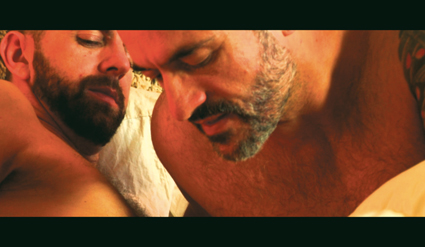
Time is the fire in which we burn, 2009, Dani Marti
courtesy the artist and BREENSPACE
Time is the fire in which we burn, 2009, Dani Marti
Dani Marti’s two videos provide contrasting perspectives on the individual seeking intimacy and personal connection. Time is the fire in which we burn (2009) is an emotionally charged interview conducted by the artist with a lover in bed, evidently one of series in which the artist encourages his subject to speak openly about his life and feelings in such a setting. This absorbing documentary presents the tragic personal account of the subject but also renders us as voyeurs intruding into an intimate moment. Projecting the video at an enlarged scale and showing it in a curtained space (to meet censorship requirements) amplifies the intimacy and makes our voyeurism seem uncomfortably acute. But, unlike Murphy’s psychologist, Marti is actively intervening in his subject’s life by establishing an intimate relationship with him. Whether Marti is catalysing his partner’s self-awareness or his partner is self-consciously acting a role, we see how, in any relationship, we might recreate our persona for our partner.
Marti’s second video, Andrea greeted with a pubescent smile (2008), is a soliloquy in which a young woman speaks of her social encounters through the internet, another example of self-disclosure that reveals how we have come to rely on the superficial companionship of chat rooms while guarding ourselves against predators with fake identities. Marti’s video is a profound commentary on the impact of the internet on social interaction, and both his works are extraordinarily candid and deeply affecting personal accounts that ache with loneliness. When seeking friendship, information or advice through the internet, we open ourselves to abuse and colonisation by quacks, lovers, voyeurs and fakes—gamers of all kinds.
As if to reassure us, the final works in this exhibition offer the semblance of real life. Tellervo Kalleinen and Oliver Kochta–Kalleinen organised a series of amateur choral performances in St Petersburg, Tokyo, Chicago, Helsinki, Hamburg and Birmingham, and recorded them on video as the Complaints Choir (2006). We see ordinary citizens of all ages happily singing their complaints about their lives—unsatisfactory relationships, workplace difficulties, incompetent and uncaring governments, incomprehensible technological gadgetry and so on. In this exhibition, the Complaints Choir seems more like group therapy than activism and we readily identify with these people and their wish to be heard. Their camaraderie is both palpable and uplifting.
Vocal Thoughts is an essay in human communication, intimacy and relationships. The themes of vulnerability, emotional and psychological disturbance, confession and the nature of self-awareness run throughout, making the exhibition richly illuminating. If technological development has brought us to the verge of a radical form of post-humanism, Vocal Thoughts reminds us of the privacy and humanity we risk losing, and urges that we understand our own psychology better before proceeding. As well as revealing the potential for communications technologies to mediate self-awareness, Vocal Thoughts demonstrates the level of sophistication artists have attained in using video and animation. The art lies in positioning the work in the interstices between cinema, documentary, web page, game and cartoon so as to capitalise on the power of those media and synthesise new forms and effects. The inclusion of Johnston’s drawings in the show locates each medium in a broader perspective, revealing its relative authority and reach.
Vocal Thoughts, curator Peter McKay, artists Anna Davis and Jason Gee, Chris Howlett, Daniel Johnston, Tellervo Kalleinen and Oliver Kochta-Kalleinen, Dani Marti, Kate Murphy; Contemporary Art Centre of South Australia, Adelaide, Sept 10-Oct 10
RealTime issue #100 Dec-Jan 2010 pg. 46
© Chris Reid; for permission to reproduce apply to realtime@realtimearts.net
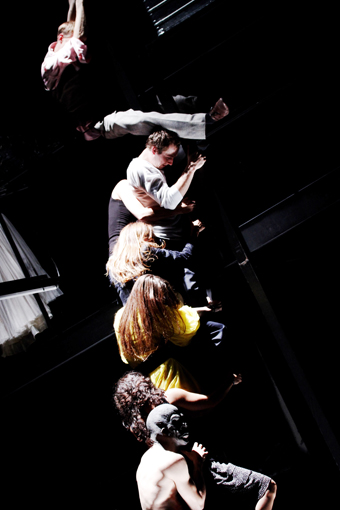
Trust, Schaubühne
photo courtesy Perth Festival
Trust, Schaubühne
perth festival
If you needed a reason to head west this summer, some of the offerings at the Perth Festival should float your boat. When we saw Trust at Berlin’s Schaubuhne last year, we hoped that this innovative theatre-dance work would hit the festival circuit and here it is! Trust is a socially critical and sometimes comical work in which Falk Richter’s lateral text is spoken but also inventively danced/moved by a multi-skilled team of actors and dancers co-directed by Richter with choreographer Anouk van Dijk (RT95). The program also features Out of Context: for Pina, Alain Platel’s Les Ballets C de la B tribute to Pina Bausch which our writer Jana Perkovic described as “emotionally penetrating and deliriously enjoyable” (R98). Lucy Guerin Inc performs its disturbing Human Interest Story (RT99); Steve Reich presents the Australian premiere of his acclaimed new work 2 x 5; and Bang on a Can All Stars bring rivetting works by Julia Wolfe, Michael Gordon, Thurston Moore, Steve Martland and David Lang. 2011 Perth Festival, February 11- March 7; www.perthfestival.com.au
ten days on the island
True festival junkies will then move on to cooler climes for Tasmania’s Ten Days on the Island in March. We’ll have a full preview in RealTime 101, but a sample of the program might whet your appetite. Power Plant from the UK will transform the Botanical Gardens into a series of sound and light installations “where the nocturnal beauty of the gardens is the real star.” New works and commissions from local and interstate artists include Craig Walsh’s magical Digital Odyssey projections at Sullivan’s Cove. In Dance Marathon, Canadian company bluemouth inc somehow creates a “fun show” inspired by the dance endurance contests of 1920s and 30s America. Chamber Made Opera presents the first part of their Minotaur project, a contemporary chamber reconstruction of Monteverdi’s lost opera, L’Arianna. Launceston’s youth dance company, Stompin’, premieres I Love Cars, “a site-specific, multi-art mash-up exploring our enduring love affair with motor vehicles.” Tasdance’s Artery brings together four choreographers—Trisha Dunn, Alice Lee Holland, Solon Ulbrich and Adam Wheeler—and Scottish composer/ choreographer/musician/writer Billy Cowie’s Stereoscopic combines “stereoscopic filmmaking with inventive dance choreography and sound scores for an immersive 3D encounter.” In the Dance Hall series you can dance yourself silly to music “from Greece to Haiti, from Trinidad and Tobago to Zanzibar, and with the sounds of Pacific reggae.” Ten Days on the Island, March 25-April 3, www.tendaysontheisland.com
stop(the)gap
Stop(the)Gap: International Indigenous Art in Motion is a major international Indigenous moving image project developed for the 2011 BigPond Adelaide Film Festival (BAFF) in partnership with the Samstag Museum of Art. Curator Brenda L Croft has selected works that “challenge preconceptions of contemporary Indigenous expression and address themes of human rights, environmental concerns, cultural security and negotiating diversity.” She says, “Some of the most provocative and illuminating moving image work today is being created by Indigenous new media artists—yet there has been no international focus on this work until now. Despite physical distances, Indigenous communities around the globe are linked through their shared colonial histories, each bearing scars borne of dispossession, injustice, inequality and misrepresentation.” The project explores the connections between cinema and the visual arts, and will feature moving image exhibitions, film screenings, outdoor projections and discussions. Filmmaker Warwick Thornton has been commissioned through the Adelaide Film Festival Investment Fund to create a new work for the project. Other participating artists include r e a and Genevieve Grieves (Australia), Dana Claxon and Rebecca Belmore (Canada), Alan Michelson and Eric Lord (USA) Nova Paul and Lisa Reihana (Aotearoa /NZ). Stop(the)Gap, Samstag Museum of Art, Feb 24-April 21, 2011, www.unisa.edu/samstagmuseum; www.adelaidefilmfestival.org
push international festival of performing arts, vancouver
Director Norman Armour describes this year’s PuSH program as engaging with ‘cityness’. He writes, “The 125th Anniversary Series (a suite of performances and events that looks at questions of urban experience, the everyday, our history and civic identity) is our single most ambitious curatorial undertaking to date…There are a number of boundary-pushing works that invite you to venture from the theatre and out into public spaces. It’s a time to speak to the values and vision we have as a city. It’s a time to affirm how profoundly art impacts individuals, and how radically it can transform societies.” The Antwerp-based company Berlin will present a documentary installation on Canada’s smallest capital, the Inuit city of Iqaluit, and a cinematic portrait of a desolate mining town (Bonanza). Rimini Protokoll continue their 100% series and, after 100%Berlin and 100%Vienna, create an accurate demographic synecdoche of Vancouver on stage, using 100 randomly selected local participants. Boca del Lupo, Vancouver performance company, collaborate with Argentinian writer and director Mariano Pensotti on La Marea (The Tide), a dramatic work presented throughout the urban space over the course of the evening, while the incidental audience can read the characters’ inner thoughts through projected subtitles. It is hard to do justice to the riches on offer. Visit the PuSh website and see for yourself, then make your way to Vancouver. PuSh International Festival of Performing Arts, Jan 18-Feb 6, 2011, http://pushfestival.ca
womadelaide
Adelaide is the place to be in March when Botanic Park will again be the setting for WOMAdelaide, Australia’s iconic four-day celebration of music, arts and dance from around the world. This year’s potent line-up includes Angus and Julia, Afro Celt Sound System, Amadou and Mariam, Joanna Newsom, punk-reggae icon Don Letts, UK DJ Norman Jay, Nigerian singer-songwriter Asa, The Necks, Irish rockabilly singer Imelda May and the big band Juan De Marcos Afro-Cuban All Stars. As always there’s much more than music: France’s Le Phun will spend three weeks leading up to the festival “building six magical installations for their performance piece Les Gûmes (a play on the French word for vegetables), where a surprising society has taken root in a vegetable kingdom and mutated into half-human, half-plant beings.” Dance, with more exciting music, comes in the form of Breathe, a collaboration between Leigh Warren & Dancers, Bangarra Dance Theatre’s Frances Rings and didgeridoo player William Barton. Womadelaide, March 11-14 March 2011, www.womadelaide.com.au
the now now, sydney
In recent years, there’s been a marked increase in experimental music activity over summer. To a large degree this is due to The NOW Now festival, which in 2011 celebrates its 10th year and swaps the crisp air of the Blue Mountains for the gritty city over two weekends in three venues—the Red Rattler in Marrickville, Serial Space in Chippendale and a “secret” venue—People’s Republic of Australasia. As always, an abundance of artists will be ready to spontaneously make music in all manner of combinations. The Un-Australian String Quartet features Jon Rose, Hollis Taylor, James Rushford and Judith Hamman; from Zurich, Jason Kahn will perform on analogue synthesiser with Matt Earle and Adam Sussmann of Stasis Duo fame on electronics; Roil brings together Chris Abrahams, Mike Majkowski and James Waples; and then there’s the warped wonder of Sky Needle—Joel Stern, Alex Cuffe, Ross Manning and Sarah Byrne (see earbash review). Add to this more international artists also presented at Sound Out (read on). The NOW now, Red Rattler, Serial Space, The People’s Republic of Australasia, Jan 21-24, Jan 26-28, Sydney, www.theNOWnow.net
sound out, canberra
The NOW now is no longer alone in the summer time slot, since 2009 there’s MOFO (see interview with curator Brian Ritchie) and now an even newer kid on the block. Canberra’s Sound Out director Richard Johnson spruiks his festival as celebrating the “tremendous growth and maturing within the experimental and new music scene in the Canberra region.” This new event creates an attractive touring circuit in Australia over January for international artists. The NOW now and Sound Out have the joint honour of presenting Yan Jun, pioneering noisician from China; drummer Tony Buck and Berlin-based pianist Magda Mayas; Duo Vulgarités from Canada, who appear to play just about everything from batteries to trumpet; guitarist Kim Myhr from Norway; pianist Cor Fuhler from Germany; and Scandinavian trio The Thing, with Mats Gustafsson on saxes, Paal Nilssen-Love on drums and Ingebrigt Haken Flaten on double bass. Sound Out, offers four concert sessions over two days at the Street Theatre and will also feature Australian musicians Dale Gorfinkel, Laura Altman and Monica Brooks as well as artists from the healthy local scene such as Spartak, Shoeb Ahmad and Evan Dorria. Plenty of good reasons for a road trip to the national capital! Sound Out 2011, Street Theatre, Canberra, Jan 29-30, 2010, www.thestreet.org.au http://soundout2011.blogspot.com/
RealTime issue #100 Dec-Jan 2010 pg. 47
© RealTime ; for permission to reproduce apply to realtime@realtimearts.net
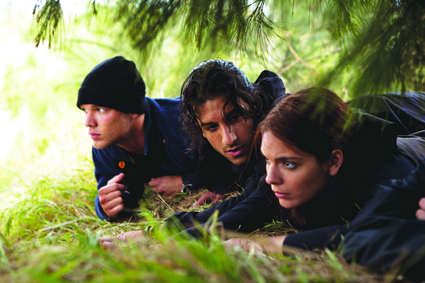
Tomorrow, When the War Began
“GET READY. THIS IS REAL. THIS IS TRUE.” SO READS THE BLURB ON MY BATTERED PAPERBACK COPY OF TOMORROW, WHEN THE WAR BEGAN, JOHN MARSDEN’S RIPPING YARN FROM 1993 ABOUT A BAND OF TEENAGE GUERRILLAS DEFENDING THEIR HOME TURF. ONE OF THE MOST POPULAR AUSTRALIAN ‘YOUNG ADULT’ NOVELS OF ALL TIME, TOMORROW SPAWNED NINE SEQUELS AND HAS NOW MORPHED INTO A BIG-SCREEN ACTION-ADVENTURE THAT MARKS THE DIRECTING DEBUT OF STUART BEATTIE—ANOTHER LOCAL HERO, WHOSE HOLLYWOOD SCREENWRITING CREDITS INCLUDE THE FIRST PIRATES OF THE CARIBBEAN (2003) AS WELL AS COLLATERAL (2004).
Marsden’s book and Beattie’s film share a simple, irresistible premise: seven high school friends—three boys, four girls—go camping in the bush outside their country town, in an Edenic secret valley ironically known as “Hell.” On their return, they find that everything has changed: power lines have been cut, dogs slaughtered, family members are nowhere to be found. Australia is at war with an unnamed country and these kids just happen to be at ground zero of the attack.
In both book and film, the trick is that the invasion is equally a nightmare and a wish-fulfilment dream. Marsden’s novel combines derring-do and soap-opera romance with open-ended moral inquiry, catering to his readership’s yearning for maturity while proposing anguish over bloodshed as part of the price. Beattie adheres to a simpler version of the same coming-of-age formula: “I want to do more, see more, I want to be more,” Corrie (Rachel Hurd-Wood) tells the protagonist Ellie (Caitlin Stasey) early on, never guessing how swiftly her prayers will be answered.
From Marsden’s perspective, Ellie and her mates aren’t so distant from, say, the gang in Buffy the Vampire Slayer, using jokey camaraderie to fend off darkness without and within. Far more streamlined and externalised, Beattie’s outwardly faithful adaptation is closer to Home and Away with guns. Where Marsden refuses easy philosophical solutions, Beattie’s slant is straightforwardly Darwinian: Ellie may express guilt over the death of an enemy her own age, but this is merely a character beat, a step on the transformative journey to adulthood.
Struggling to manufacture chemistry between his actors in the awkward dialogue scenes, Beattie is more at ease with a convention familiar from horror cinema, whereby pent-up emotions are relieved in bursts of cathartic violence. Unlike her counterpart in the novel, Corrie announces at the outset that she’s had sex with her boyfriend Kevin (Lincoln Lewis), a ‘loss of innocence’ that irrationally seems to trigger the destruction of her cosy childhood world. By contrast, Ellie remains a tough virgin resembling the Final Girl in a slasher flick—though keeping the franchise possibilities in mind, Beattie avoids bumping off any of his leads.
Jingoistic speeches are kept to a minimum, and we’re briefly reminded that the mainly Anglo heroes are themselves the beneficiaries of an earlier invasion. Not quite dog-whistle cinema, Tomorrow still serves its purpose as ideological propaganda, in the vein of recruiting advertisements (“The Army – The Edge”) that continue to screen regularly in Australian multiplexes. Beattie’s exploitation of the teen-soldier gimmick recalls both John Milius’ World War Three adventure Red Dawn (1984) and Paul Verhoeven’s sci-fi satire Starship Troopers (1997); while in plot terms the invaders of Tomorrow could be replaced by extra-terrestrial bugs, the point of the exercise lies in bringing the fantasy back home, letting us view an outlandish scenario as potentially ‘real.’
There’s little doubt that this frightening yet enticing prospect matches the national mood in an era when “border security” is not only an election issue but the title of a top-rating reality show. Back in the pre-Howard days, John Marsden felt obliged to cover his tracks by refusing to specify the origins of his bad guys, as well as assigning a central heroic role to a Thai-Vietnamese character (played here by Chris Pang). For his part, Beattie unambiguously portrays the invading army as Asian, a decision he has justified in interviews by noting that geography limits his options: “Why would New Zealand invade Australia? It doesn’t make sense.” No, indeed—but with China or Indonesia, it’s presumably a different story.
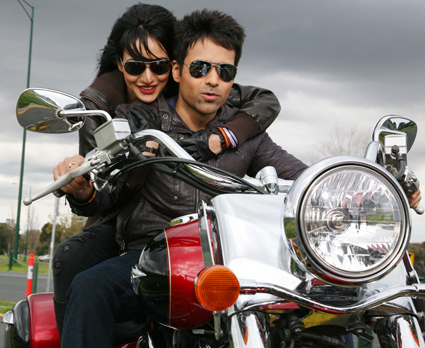
Crook: It’s Good to Be Bad
The boot is on the other foot in Mohit Suri’s Crook: It’s Good To Be Bad, another paranoid fantasy of an alternate-universe Australia torn apart by racial warfare. Already a Bollywood veteran at twenty-eight, Suri shot part of the film in Melbourne last year, inspired (if that’s the word) by attacks on Indian students that gave the city the kind of media profile money can’t buy. Predictably, the film’s eventual release in Australia was beaten up into a minor controversy: “Bollywood Movie Paints Melbourne As Racist,” announced a disapproving headline on the ABC news website. Had those cheeky sub-continentals gone too far?
Or not far enough? A typical Bollywood melange of song, comedy and melodrama, Crook (like Tomorrow) exploits an attention-getting theme while disavowing any goals beyond the unimpeachable one of ‘entertainment.’ The initial comic sequences in Mumbai introduce us to Jai Dixit (Emraan Hashmi), a larrikin packed off to Australia by his uncle (Gulshan Grover) in order to get him out of the DVD piracy game. But his eye for the main chance remains undimmed: after an effort to impersonate a scholarship student, he settles for pursuing the beautiful radio presenter Suhani (Neha Sharma), though it’s unclear if he cares more for her personal attractions or her Australian citizenship.
As Jai explores his new surroundings, Crook idles in first gear for half an hour or more, reinforcing a dubious image of Melbourne as a sporty city by the bay that harks back to the touristic glamour of Siddarth Anand’s Salaam Namaste (2005). Suhani inexplicably lives in a million-dollar mansion with ocean views, while Jai joins a group of expatriates in a purple bungalow complete with backyard swimming pool, at the end of a suburban cul-de-sac with an inner-city nightclub just round the corner.
Jai’s quest to win over Suhani is complicated by her firebrand brother Samarth (Arjan Bajwa), a racial separatist who denounces Australia as a decadent land of former convicts and rampant pre-marital sex. Jai himself is more susceptible to the lure of the mysterious West, finding a secondary romantic prospect in a bottle-blonde stripper (Sheila Allen) with a troublesome brother of her own (Francis Michael Chouler). Just to complicate the film’s racial politics, a handful of scenes were shot with Cape Town doubling for Melbourne, and both these representative Aussies speak in what seem to be South African accents.
Meanwhile, student bashings are on the rise, with the connivance of at least some members of the Australian Police. For a few moments the film takes on the appearance of an agitprop documentary as Indian activists gather in protest, though collective struggle holds little interest for the stubbornly individualistic Jai. For my money, the highlight of Crook comes immediately before interval, when the hero slips away from a brawl and races desperately towards Flinders Street Station—just as Ava Gardner did all those years ago in On the Beach (1959).
Thereafter, the narrative goes haywire: the nightclub burns down, a major character is revealed as a serial killer, and the city looks set for a full-scale riot unless our feckless hero manages to mend his ways and convince us all to get along. Lurid but not ill-natured, Crook ultimately goes out of its way to propose a moral equivalency between Anglo and Indian bigots (other ethnicities hardly get a look-in) while depending like Beattie’s film on a strictly enforced opposition between ‘us’ and ‘them.’ What Asia will make of Tomorrow, When the War Began is anyone’s guess, but Melbournians may be legitimately perturbed that their city has become an internationally recognised byword for prejudice: even a distorting mirror can reveal genuine faults.
Tomorrow, When the War Began, director, writer Stuart Beattie, novel John Marsden, cinematography Ben Nott, editor Marcus D’Arcy, production design Robert Webb; Crook: It’s Good To Be Bad, director, story, Mohit Suri, script Ankur Tewari, music Pritam, producer Mukesh Bhatt
RealTime issue #100 Dec-Jan 2010 pg. 15
© Jake Wilson; for permission to reproduce apply to realtime@realtimearts.net
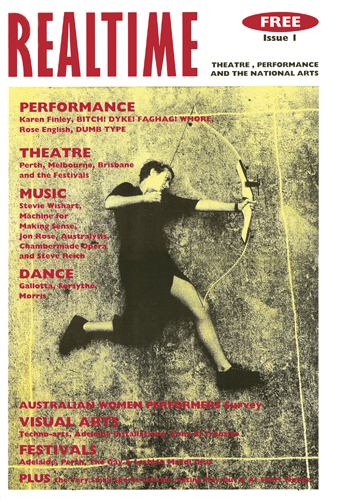
RealTime issue 1 featuring Angharad Wynne-Jones
RealTime is 100! Well, not exactly. But we have reached our 100th edition and, after a very busy 2010, will celebrate on the occasion of our 101st in February 2011. Performance artist Angharad Wynne-Jones appeared on the cover of our first edition in 1994 before becoming house manager and then artistic director of Performance Space and, later, director of LIFT (London International Festival of Theatre). Most recently she’s been the organiser in Australia of the Tipping Point forums on the relationship between the arts and the future of the environment. The RealTime issue 1 cover reminds us how far we’ve come and the changes the arts have been through and how they’ve changed the world—and not. There’s work to do. We look forward to celebrating our 101st with you in 2011.
Our thanks go to the 40 NSW artists, companies and organisations who wrote statements of support for RealTime after we failed to win funding from Arts NSW for two years running. Now we’re back on the Arts NSW books and deeply appreciative of your generosity. Meanwhile, in the way of the swings and roundabouts of arts funding, after many years of receiving support from and engaging in joint publishing ventures with what is now Screen Australia, we no longer fit that organisation’s more corporate bill or its tiny funding allocation for screen culture. But that won’t deter us—we’ve had an excellent year and 2011 is looking good.
RealTime issue #100 Dec-Jan 2010 pg.
© RealTime ; for permission to reproduce apply to realtime@realtimearts.net
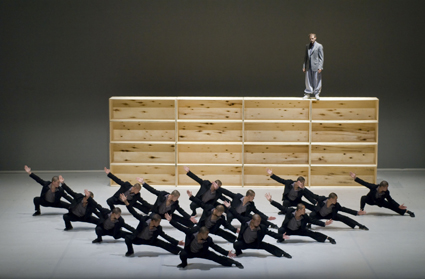
Sutra, Brisbane Festival 2010
photo Andree Lanthier
Sutra, Brisbane Festival 2010
THE BOXES WHICH FIGURED AS MAJOR MOTIFS IN TWO OF THE DANCE WORKS IN THE 2010 BRISBANE FESTIVAL ALSO SIGNIFIED THE PACKAGING IN WHICH A PROPORTION OF THE FESTIVAL CAME WRAPPED—AN INVITATION TO EXAMINE THE DIFFERENT INFLECTIONS GIVEN TO WORKS DEEMED TO BE THE PRODUCT OF INTERCULTURAL COLLABORATION, AND HOW THEY ARE POSITIONED IN THE GLOBAL ART HYPERMART. ANDREW ROSS, ARTISTIC DIRECTOR OF THE BRISBANE POWERHOUSE, VOICED TO ME HIS MISGIVINGS ABOUT THE AESTHETIC AND IDEOLOGICAL TRENDS PROMULGATED BY INTERNATIONAL FESTIVALS, PARTICULARLY AT THE EXPENSE OF INTRA-CULTURAL WORKS THAT SEEK TO REASSESS THE SOURCES OF A PARTICULAR NATIONAL OR REGIONAL STYLE OF PERFORMANCE IN ORDER TO SITUATE IT BETTER IN RELATION TO OUTSIDE INFLUENCES.
These issues were tangentially raised during one of the Festival Conversations between the London and Sydney-based Spanish choreographer and director of the Sydney Dance Company, Rafael Bonachela, and the Algerian-born director, choreographer and performer Sidi Larbi Cherkaoui who lives in Belgium. The two share a common cosmopolitanism, but diverged markedly in their approaches to intercultural collaboration, particularly regarding their sensitivities to the inner contradictions of two nominally Communist, but culturally different, societies. Bonachela rather naively came across as a liberator, describing Cuba as a prison but failing to mention the US-led embargo which has kept Cuba isolated from the rest of the world and ruined its economy. Unfortunately I missed out on Danza Contemporanea de Cuba and its “gifted, gorgeous Cubans…[who were] a very welcome ray of sunshine” (Daily Telegraph), hardly Bonachela’s grey prisoners. Whether intended or not, Bonachela seemed to be endorsing a neo-colonialist, post-cultural stance that deceptively positions itself, as Patrice Pavis has written, “outside the social, outside class conflicts and economic interests, outside political and historic relationships.”
sidi larbi cherkaoui, sutra
Cherkaoui was more circumspect, more willing to credit aspects of Chinese society which reflect badly on us in the West, and more subtle in delineating criticisms. The set design for his festival work, Sutra, comprising 21 rectangular-shaped boxes by Turner-prize winning artist Antony Gormley, was inspired by the living conditions of factory girls Gormley saw in China. A directorial coup had the Shaolin monks with whom Cherkaoui collaborated perform a martial arts routine dressed as modern office workers, then lying down in boxes which had been stacked like skyscrapers in a complex image which functioned both as an allusion to the factory workers and as a wry comment on what has been both lost and gained in China’s rush to urbanisation.
Cherkaoui has received criticism for indiscriminately engaging with the cultural Other (Flamenco, Kathakali), but Sutra was an exquisitely parsed model of cultural exchange, depicting the intimate inner journey of a uniquely placed European sensibility attempting to come to terms with the message of Buddhism. A Zen Buddhist parable about the appearance of phenomena describes a still lake from which a fish suddenly leaps and as quickly disappears back into the depths. This was recapitulated by the actions of the monks who were choreographed to mysteriously appear and disappear and, with their invisible manipulation of Gormley’s boxes on the bare stage to create vast vistas, cave temples, the monumental walls and walkways of ancient China, culminating in the towering motif of a lotus flower with a child, also a monk, at its heart.
The child performer who mimicked Cherkaoui and enthusiastically performed cartwheels across the stage during a quietly triumphant finale portrayed the artist’s own inner child let loose, in contrast to the rather clownish adult seeker of enlightenment which Cherkaoui so elegantly and unobtrusively manifested when as a dance performer he got amongst the action. Western self-reflexivity and dual mind were also represented by Cherkaoui periodically returning downstage to disconnectedly operate the changes by rearranging a small replica of the stage set. (See also Martin del Amo’s review p27)
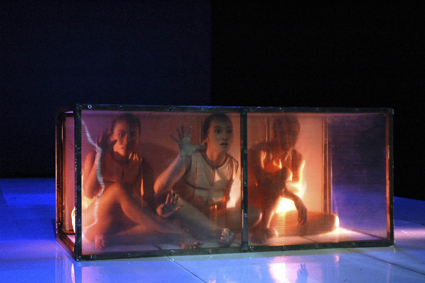
Di Dalam/Di Luar (In/Out), Hartati, Brisbane Festival 2010
photo Eva Tobing
Di Dalam/Di Luar (In/Out), Hartati, Brisbane Festival 2010
tarian baru dari indonesia
Tarian Baru Dari Indonesia (New Dance from Indonesia) spoke first to its own culture, not to any universal construct. Nevertheless, while reworking tradition, these works also employed contemporary languages of the body. If other cultures can appear exotic, assuaging our deep ennui with our own culture, Hartati’s Di Dalam/Di Luar (In/Out) turns the tables on what Rustom Barucha calls “the euphoria of pluralism” whereby we are free to choose amongst cultures. Three women are trapped in glass boxes. They struggle to free themselves, only to become entrapped, individually, in a succession of other boxes, each containing a promising but ultimately limited experience of exploration and choice. When the women themselves become the means whereby the boxes are lifted from the stage it is the beginning of a celebratory dance passage where contemporary and traditional culture are harmonised before the final stage picture. A woman crouches down, meditating on a pair of red shoes placed before her on the floor; precariously balancing on one high heel, a second woman seems to interrogate the matching red shoe dangling from her hand; the last woman, immaculately turned out in her red shoes, gazes out at the audience for a long moment before breaking eye contact and confidently exiting the stage box.
If Hartati knowingly dissects the seductions of contemporary global culture for Indonesian women, Ery Mefri contemplated the figure of Eve’s centrality to the creation myth of all three monotheistic religions originating in the Middle East and imported to Sumatra as an Islamic cultural influence in the 14th century. Layered over the indigenous, matrilineal Minangkabau culture where property passes from mother to daughter, it seems both modernity and the resurgence of militant Islam constitute a two-pronged attack on the deep roots of Minangkabau society. Mefri’s Sanghawa (Eve) enacts the story of a son asking his mother’s permission to embark on a rantau, an Odyssey traditionally undertaken by young men from Sumatra for economic reasons. Reversing the myth, Mefri has Eve lamenting the forces tempting the young man away. This work was spare, tender, fraught and oddly sensual.
The mother’s centrality to the integrity of Sumatran family life was further explored in Rantau Berbisik (Whisperings of Exile) as a family running a food outlet in the capital descends into petty feuding in her absence. The folkloric Plate Dance and exciting, rhythmic percussion on glass and china vividly recreated the atmosphere of a working kitchen. The superb control of the dancers was hypnotic to watch, and Mefri’s intense vision induced powerful emotions of lost connectedness.
conor lovett, beckett’s first love
Beckett once wrote loftily that “[vaudeville] at least inaugurates the comedy of an exhaustive enumeration.” The phrase “comedy of an exhaustive enumeration” flies like a dove out of Beckett’s own mouth to describe First Love, a 75-minute rendition of an early novella, delivered brilliantly by Conor Lovett who was alert, and alerted us, to Beckett’s every word and nuanced silences. I can’t resist quoting: “But what kind of love was this, exactly? Love-passion? Somehow I think not. That’s the priapic one, is it not?…Perhaps I loved her with a platonic love? But somehow I think not. Would I have been tracing her name in old cow shit if my love had been pure and disinterested?” You can hear the voice of a stand-up comic, can’t you? The misogyny and the misanthropy? And the Irish accent? Always the Irish accent explicating Beckett—correcting early impressions when you had read him without the lilt; thrusting you into the mud of existence. This was the treat of the festival, and all the better for sharing the pleasure with an appreciative audience.
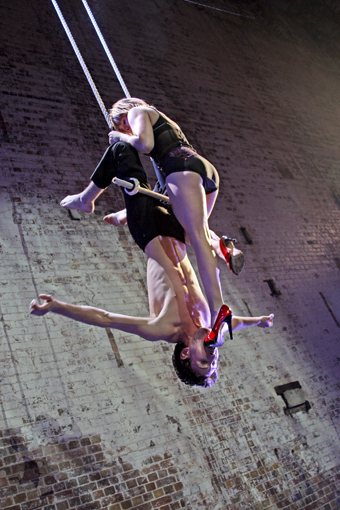
Jesse Scott, Emma Serjeant, Wunderkammer, Circa, Brisbane Festival 2010
photo Justin Nicholas, Atmosphere Photography
Jesse Scott, Emma Serjeant, Wunderkammer, Circa, Brisbane Festival 2010
circa, wunderkammer
I thought I was over circus spectacles, but Wunderkammer, Circa’s world premiere at the new Powerhouse outdoor venue, has converted me. Simply, this was the best circus I’ve ever seen. Consistently inventive, moving along at a turbo-charged rate, provocatively sexy and displaying a full complement of skills across the ensemble, it left you gobsmacked. While it had touches of artistic director Yaron Lifschitz’s trademark S&M aesthetic with dark asides and nods to neo-burlesque, this was his homage to the body in its extreme flights, taking you to another realm. The industrial wall of the Powerhouse as backdrop suited this aim, as did the intimacy of the Spiegeltent for Strut and Fret’s circus cabaret which offered more theatrically devised satisfactions, recreating a louche, 1920s Parisian bar. The skills were just as evident (I haven’t seen a contortionist to equal Henna Kaikula, and what Mozes did with a neckerchief was hilariously risque), and it was a more corporeal experience. The radiant Charleston routine performed by the ensemble tied all the elements together.
Brisbane Festival 2010: Sutra, director, choreographer Sidi Larbi Cherkaoui, design Antony Gormley, music Szyom Brzoska, performers Sidi Larbi Cherkaoui, the Shaolin Monks, Playhouse-QPAC, Sep 8-11; Tarian Baru Dari Indonesia (New Dance from Indonesia): Di Dalam/Di Luar (In/Out), choreographer Hartati, Powerhouse Theatre, Sep 7-9; Nan Jombang Dance Company, Sanghawa (Eve) and Rantau Berbisik (Whispering of Exile), choreographer Ery Mefri, Powerhouse Theatre, Sep 10-12; Gare St Lazare Players, First Love, director Judy Hegarty Lovett, performer Conor Lovett, Visy Theatre, Brisbane Powerhouse, Sep 21-25; Circa: Wunderkammer, artistic director Yaron Lifschitz, Plaza, Brisbane Powerhouse, Sep 14-18; Strut and Fret Production House, Cantina, performers Mozes, Chelsea McGuffin, David Carberry, Daniel Catlow, Henna Kaikula, Spiegeltent, King George Square, Brisbane, Sep 5-25
RealTime issue #100 Dec-Jan 2010 pg. 2
© Douglas Leonard; for permission to reproduce apply to realtime@realtimearts.net
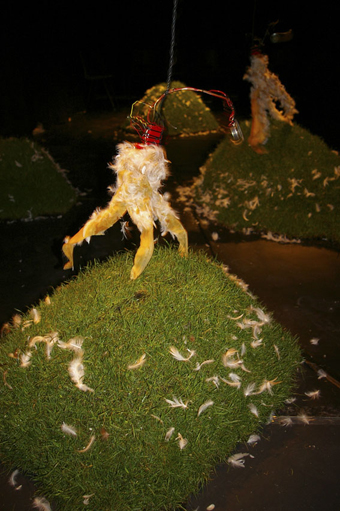
Birdmachine, Ivan Thorley
photo courtesy of the artist
Birdmachine, Ivan Thorley
UNDER THE RADAR HAS EARNED A PERMANENT PLACE IN THE BRISBANE FESTIVAL AS A CURATED PROGRAM OF ALTERNATIVE, ARTIST-INITIATED WORKS DRAWN NATIONWIDE. FOR THE FIRST TIME THIS YEAR IT APPEARED IN THE MAIN PROGRAM WHICH PERHAPS ACCOUNTED FOR AN EXPANDED AUDIENCE INTERESTED IN CONTEMPORARY PRACTICES AND LONGER IN THE TOOTH THAN LAST YEAR’S MORE PAROCHIAL AUDIENCE OF DRAMA STUDENTS, SUPPORTERS AND FRIENDS (I’M TOLD THAT THERE WERE FAR FEWER SUBMISSIONS FOR THIS PROGRAM FROM QUEENSLAND THIS YEAR). SELF-CONTAINED IN THE MULTI-PURPOSE PRECINCT OF METRO ARTS, UNDER THE RADAR CONSTITUTED ITS OWN DISCREET, ATMOSPHERIC FESTIVAL OF PROVOCATIVE IDEAS AND INTIMATE, ENGROSSING WORKS.
birdmachine
On the outer edge of R&D into performance practices, the Birdmachine created by technologist/animateur Ivan Thorley and sonic artist Frederic Reuben was an animatronic performance installation that explored “the vitality and ability of movement to create difference and meaning between ‘forms of life’.” The installation consisted of a sparse (perhaps in the sense of last of the species) bird colony that performed ritualised, choreographed movements. Two tussocks were sites for a mating dance, the sex difference indicated by a stub of dowling, the atmosphere that of a silent rainforest until the microphones angled for interactive responses were utilised and triggered birdcalls. This was the most fragile, funny and endearing encounter of Under the Radar, one that enticed you, in the absence of narrative, to render your own meaning, to become aware of your movements as you bobbed up and down at the microphones, circled for a better look, moved in for closer inspection and away again as you shuffled round the space. We were an audience machine. These autonomous simulacra were deliberately tacky, daggy cloth puppets shaped from coat hangers with four elementary appendages to suggest flight and scuttling across a forest floor. Yet this bizarre assemblage conveyed the full bathos of Charles Darwin’s admission, “The suffering of the lower animals throughout time is more than I can bear.”
nostalgia
Also in the extreme R&D category was Nostalgia, a collaboration between three well-known Brisbane emerging artists: director/sound designer Matt O’Neill and performers Kieran Law and Ron Seeto. This work was intended to demonstrate that “different experiences and approaches were still capable in performance and, furthermore, that they could be realised and articulated with only the meanest of resources and the most rudimentary of skills.” Nostalgia’s concerns with movement relationships between bodies, the environment and a technologically produced soundscape echoed Birdmachine to an eerie extent. The piece began with the two performers immaculately miming industrial process work, a metaphor perhaps for the level of reproduction involved in the discipline of rehearsing and polishing a performance to the level of marketable product. This metamorphosed into free-form dance improvisation that was carried on over such a long time, to the point of physical exhaustion, that one ceased to be embarrassed by the lack of dance training and instead, dropping expectations, becoming fascinated by the performers’ monstrous prodigality and endurance. At the end, the audience was invited onstage for a free-for-all dance. Easily dismissed as self-indulgence, I was impressed nonetheless by the generosity of spirit in Nostalgia and the way the company re-envisaged community interaction with the arts and refused to be ghettoised. I only wish they’d been brave enough to perform in the City Mall.
brightness
It took a foolhardy Irishman to do that deed. In Brightness (funded by the Irish Arts Council), a modern version of an Aisling, or vision poem, the interventionist artist, Denis Buckley, presented poems and writings in Gaelic and English that were sometimes pre-recorded, sometimes read aloud, but went mostly unheeded in the gaderene rush of late-night shoppers or were drowned out by blasts of music emanating from Hooters, a strip club on the Mall. Buckley took this in his stride—he deliberately chose the location—as he performed against the incongruent projection of an Irish sky crisscrossed by plumes of jets carrying the latest wave of emigration caused by the collapse of the Celtic Tiger. In a formal suit, minus the jacket and bardically arresting, he grandiloquently called for the restoration of Irish culture as a cure for the country’s economic woes. Buckley was inspired by the Muse in a medieval poem who upbraids the poet to forsake his arty ways for the sake of Ireland in terms that reminded me of the irreverent slanging match between Kirsty MacColl and Shane McGowan in the Pogues’ song “Fairytale of New York.” It was Buckley’s sincerity that convinced this fellow Celt, with its perspective on place that seems only shared by the Indigenous first culture in this country.
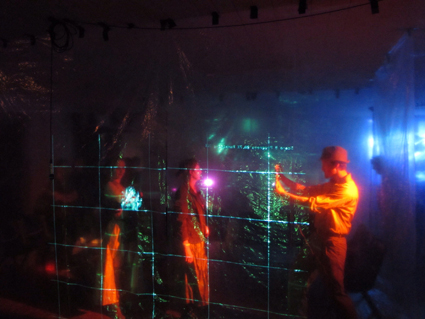
Last Man to Die
courtesy the aritsts
Last Man to Die
the last man to die
The two installation performances that most impacted on a richly textured, deeply poetic level were the technologically sophisticated The Last Man to Die and the noir moodiness created in Of the Causes of Wonderful Things. (Unfortunately I didn’t see Neon Toast, but I heard great reports.) When I said to the crew of The Last Man to Die that the work reminded me of the library scenario in a David Tennant episode of Dr Who, they told me I was on the money. Normally I’m averse to multimedia overkill, but here the futuristic setting warranted, and vindicated, its skilful use, creating a subtly retro aesthetic to match the artists’ retrograde view of the immortality industry. Black and white time-lapse video of the production was projected on the back wall so that you recognised yourself ‘back then.’ As the hard working central performer, Hanna Cormick was costumed as a sexy cover girl from a 1950s sci-fi magazine. Everything was accommodated in the glow of a black and white film aura before the invention of technicolour; and each episode returned at the whim of an audience member placing a card in the alloted slot. We were in Borges territory, caught up in a maze of fine writing by Peter Butz and fine acting by Cormick with whom, as sadistic collaborators with technology, we were forced to repeat in an endless loop. Immortality.
of the causes of wonderful things
In Of The Causes of Wonderful Things performed and created by Talya Rubin we were in the noirish milieu of the 1940s and 50s, given a surreal aspect as the world of the dead merged with the living. This was a pure performer’s piece, and Rubin was in absolute control of her material. I particularly loved the slow, patient pace with which she drew us in. Rubin played all the characters, women and men, in riveting style as well as manipulating light, sound and sinister puppet vignettes onstage. Five children had disappeared while in the custody of their aunt, and a police hunt was on. The implicit conjecture was that they had been murdered and buried. An air of suspicion cloaked everyone, and, although there were hints, events remained a mystery to the end. The children’s natural mother who had seemingly abandoned them for a Latin lover is pure noir—torn, fragile and chain-smoking next to a single onstage lamp. The men—the Police Chief who falls for the aunt, the Latin lover and the aunt’s neighbour, a Japanese Bonsai lover—were portrayed by Rubin with, I suspect, undeclared humour.
With her own suspicions about the children’s fate, the aunt precariously attempted to keep sane in the world above ground, but was assailed by an elaborate symbology of underground motifs that gradually absorbed her. These were an assortment of found objects that atmospherically conveyed fragments of the children’s own story. Sometimes their voices conversed hollowly as if from a lonely grave. A cabaret MC of the underworld introduced a woman struggling dumbly to speak the silence of a lifetime in an anguished manner that was painfully, and artfully, prolonged. Another act from the realm of the dead involved the use of an enormous head of a donkey with an articulated jaw straight out of Goya.
the raven project
There was another work in the same vein that was lighter in tone, less integrated, but in the end as insinuatingly sinister as Alice in Wonderland. The Raven Project invited us into a parlour where we were offered tea and biscuits by white-suited Jeff Stein and black-suited Frank Mainoo making up a reticent ‘Gilbert and George’ pair. We were treated to a deliberately fumbling presentation with video illustrations of the ‘blot’ that allegedly appears on the horizon in Hitchcock’s movies and has ominous, even apocalyptic connotations. Halfway through we assisted in removing kitsch paintings from the wall to reveal peepholes through which we would espy the famous shower scene from Psycho. Instead, an alternative reality was revealed where we dimly recognised our vanished hosts in their true guise as demonic, hierophantic figures. They returned in their quietly polite mode to continue the lecture, but the orbit of our world had changed. I was reminded that I’ve never really trusted the bourgeoisie.
2010 Brisbane Festival: Under The Radar: Birdmachine, creator Ivan Thorley, sonic artist Frederic Reuben; Nostalgia, creator and director Matt O’Neill, creators and performers Kieran Law, Ron Seeto; Denis Buckley, Brightness; The Last Man to Die, creators, performers Hanna Cormick, Benjamin Forster, Charles Martin in collaboration with writer Peter Butz; Of the Causes of Wonderful Things, creator, performer Talya Rubin; The Raven Project, creators, performers Jeff Stein, Frank Mainoo; Metro Arts, Brisbane, Sept 5-25
RealTime issue #100 Dec-Jan 2010 pg. 3
© Douglas Leonard; for permission to reproduce apply to realtime@realtimearts.net
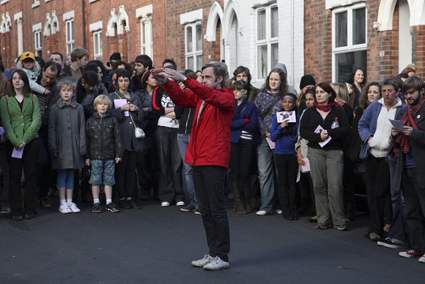
Street Dance at Nottdance, Lone Twin
photo Julian Hughes
Street Dance at Nottdance, Lone Twin
I MEET ROSIE DENNIS IN THE LOCAL PIZZA SHOP NEXT DOOR TO MINTO MALL THAT SERVES A PRETTY GOOD SOY CAPPUCCINO. FOR CAMPBELLTOWN ARTS CENTRE DENNIS HAS BEEN WORKING ON MINTO:LIVE, PART OF THE 2011 SYDNEY FESTIVAL, THREE EVENINGS OF PERFORMANCE CELEBRATING THE SUBURB’S CULTURAL VITALITY THROUGH COLLABORATIONS WITH AUSTRALIAN AND INTERNATIONAL ARTISTS.
community collaboration
Dennis has previously worked in Minto, in Sydney’s south-west, developing her performance work Driven to New Pastures, which features a local senior resident June Hickey (this work is also in the 2011 Sydney Festival program). She says of the area, “When I started coming to Minto, I was really struck by the people living here, and how passionate they were about this suburb.” Dennis hopes to tap into this depth of feeling to create MINTO:LIVE in collaboration with the community. She describes the overall vision for the performance:
“It’s all off-site. None of it is in traditional gallery or theatre spaces. The whole event is set on an 800-metre walking route in Minto. We start over near Tyrepower. There’ll be eight performances, a mix of internationals (existing works) and new commissions. And all of the works are from artists who have some kind of connection with community, or work with non-performers. So it requires a lot of participation from local residents in Minto to make it a success.”
The work of UK duo Lone Twin (Gregg Whelan, Gary Winters) offers a good indication of the tone of the event. Their piece, Street Dance, will involve the duo and Sydney choreographer Julie-Anne Long visiting over time six to eight local households to explore and expand on ‘domestic choreographies.’ For the live event, the participating families will take to the streets with their creations, sharing them with each other and the public. Dennis saw the work when it was first performed in Nottingham and says of the experience, “It’s very beautiful…people are so generous not only in the performance but in the reception of others’ work. It becomes very clear what a big act it is for the people performing, as they’ve never done it before. There’s a lot of negotiating between audience and performers to develop that level of trust.”
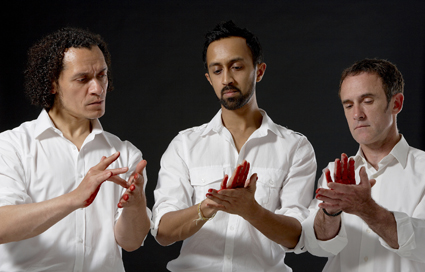
Hetain Patel (centre), TEN
photo courtey the artist
Hetain Patel (centre), TEN
UK/Indian artist Hetain Patel will be working with two local men from the Pacific Islander community to realise his piece TEN. Patel uses the 10-beat rhythms of traditional Indian music to underscore his humorous and thoughtful deliberations on cultural identity. Part performance lecture, part stand-up, part autobiography, Patel will be performing on the recently completed basketball court in the new parklands area.
Those who have experienced Rosie Dennis’ performances, will recognise a few personal preoccupations in her curation, most noticeably the musical elements. She is very excited to be able to include the Camden-based trumpet player and composer Freddie Hill, who will bring together an all-trumpet ensemble to serenade the crowd at sunset. The evening will kick off with Sweet Tonic, the 35- strong senior citizens’ choir singing from the back of a flatbed truck.
public and private
Because it’s in a state of considerable change, Dennis finds Minto particularly fascinating. Until recently, a large proportion of housing was public. However, many public residents have been moved to other areas and the land redeveloped under the “One Minto” scheme. Much of the evening’s performance will take place on parkland and streets that are still in the process of transformation.
The tensions between public and private, inside and outside are clearly represented in the work of Australian textile artist Nicole Barakat. She has asked the community to donate old fabrics from their homes: curtains, sheets, towels and so on. Working with the Embroiderers and Quilters Guilds and the Minto Tongan Tapa Group, she will cut up the donations to create string that will then be used to craft a three dimensional sculpture. Dennis elaborates: “…something from people’s private space becomes very public. Nicole likes this idea because where the evening finishes, it used to be all public housing and now it’s all very private.”
The final act of the night, which takes place in the newly built amphitheatre also offers a potent metaphor for this public/private notion. Belgian artist Gwendoline Robin’s Instant no 6899 is a pyrotechnic display unlike any other, in which the artist’s body becomes the site for ignition and explosion.
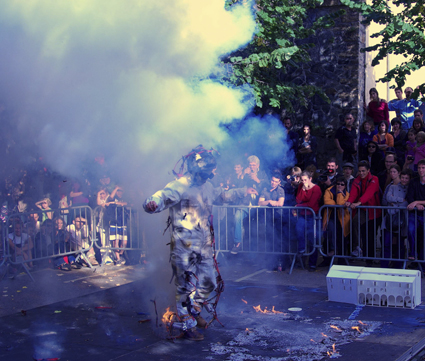
Gwendoline Robins, Instant no 6899
photo courtey the artist
Gwendoline Robins, Instant no 6899
onsite ongoing
While MINTO:LIVE is a rather large undertaking in itself, it is actually but one element of an overarching ‘Live’ program Dennis has developed for Campbelltown Arts Centre. In November 2010 the first of a series of Site:Lab residencies will kick off, with artists on-site in various Minto locations. For example Lara Thoms will be in the library where she will invite visitors to read from a chosen book, from which an audio work will be created. Frank Mainoo will inhabit a vacant house, continuing his performative research into public and private spaces and acts. Barbara Campbell will work with local Chinese groups, opening up discussion of a politically charged poem.
While some of these residencies will not have outcomes until later in the 2011 Live program, three will feed directly into MINTO:LIVE in January. One of these is Nicole Barakat’s project mentioned above, which will based at a local church. Mickie Quick and Kernow Craig from Blood & Thunder Press will set up their printing press in the former supermarket in Minto Mall, inviting the local Bangladeshi community, and others, to collaborate on a publication that will be available at the end of the event as a souvenir.
UK/Australian artists Howard Matthew and Caitlin Newton-Broad will be in residence for nine weeks in the Sarah Redfern Primary School where they will work with third graders and their parents or grandparents on a storytelling project. Creating an actual waterhole in the school grounds, the pair will conduct hands-on, cross-artform workshops which will culminate in short videos. These will be displayed during MINTO:LIVE on screens on the back of bikes ridden through the suburb.
Site:Lab will continue in 2011. Dennis says, gesturing towards the buildings nearby: “It’s going to be more ambitious, hopefully across 10 shops in Minto Mall for three weeks. Someone will be working out of the bakery; someone working out of the optometrist’s; there will be a small theatre company in the beginnings of something in a shop over there; a sound artist over there; a video artist over there. Everyone in the same place.” Many of these projects will go on to have public outcomes in MINTO:LIVE 2012.
a living centre
While Dennis is setting up a mini-art centre in Minto Mall, she is also utilising the custom-built Art Centre back at Campbelltown. She explains, “So many local groups already use the Arts Centre who are unbelievably skilled and passionate. I’m looking to make interesting matches with artists who might be able to come and be in-residence with groups over a six-month period and then possibly make a work out of that.”
There is also an ‘artist initiates’ commission that gives a chosen artist a lump sum to realise a particular project. “The reality is the resources are finite, but it’s getting artists to think about how to do something on a small amount of money… [allowing for] a bit of movement, a bit of room for spontaneity. Video artist Sam James is the first one next year—he wants to do a creative documentation of Site:Lab in 2011.”
And that’s not all. There will also be a new writers’ initiative that, from an open call, will see three writers a year exploring their fascination with text in a series of residencies. At the end of the three-year project there will be some form of compilation or outcome, a festival of words or a publication to bring the works together and to the public. When you throw in the possibility of an international residency exchange, Dennis’ program looks diverse, ambitious and offers some amazing opportunities for artists engaged in live practices.
But before all that, Rosie Dennis has to nurture MINTO:LIVE into reality. To finance the event Dennis has undertaken extensive fundraising and attracted several corporate sponsors as well as state and federal project grants. In addition, she admits that the collaborative nature of the event requires constant energy and attention. But it is this that will make the event work. She says, “All of the service providers in the area are happy that something like this is happening. They see it as really positive to combat lead stories about a drug bust in Minto, a shooting in Minto, a stabbing in Minto. They’re actually few and far between and they happen everywhere. The majority of people who live here, it’s their home, they shop here, it’s their community, they go to the club here, to the PCYC. That’s what this is about.”
Sydney Festival 2011: Campbelltown Arts Centre, MINTO:LIVE, curator Rosie Dennis, the streets of Minto, Jan 20-22, 2011; artist talk with Lone Twin, Nicole Barakat, Caitlin Newton-Broad and Howard Matthew, January 22, 2pm-5:30pm, St James Anglican Church, Minto; Driven to New Pastures, creator Rosie Dennis, performers Rosie Dennis, June Hickey, Seymour Centre Jan 11–16
RealTime issue #100 Dec-Jan 2010 pg. 5
© Gail Priest; for permission to reproduce apply to realtime@realtimearts.net
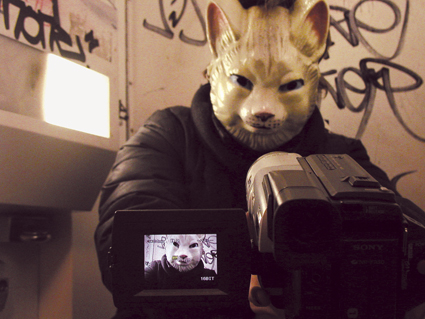
Super Night Shot
photo courtesy Gob Squad
Super Night Shot
“A 4-SCREEN VIDEO EVENT FILMED ONE HOUR BEFORE THE AUDIENCE ARRIVES, SUPER NIGHT SHOT CONTAINS NO CUTS OR EDITS AND IS PRODUCED WITH FOUR VIDEO CAMERAS BY FOUR PERFORMERS. STARTING OFF AT BASE CAMP (THE VENUE), ALL CAMERAS ARE SYNCHRONISED TO RECORD AT THE SAME TIME. THEN IN A MILITARY STYLE BRIEF, THE PERFORMERS DECLARE A ‘WAR ON ANONYMITY’ BEFORE TAKING TO THE CITY STREETS ON A SET OF MAGICAL ADVENTURES THAT CELEBRATE UNPLANNED MEETINGS WITH STRANGERS…THE FOUR ACTIVISTS THEN RETURN BACK TO BASE CAMP…THE VIDEOTAPES ARE THEN IMMEDIATELY PLAYED BACK SIDE BY SIDE IN SYNCH, BECOMING UNITED IN ONE WIDESCREEN EPIC.” WWW.GOBSQUAD.COM
The Berlin and Nottingham-based Gob Squad, who will present Super Night Shot at the 2011 Sydney Festival, are the perfect product of a post-mediatised world: a clever mix of party, audience activation, technology and a reflection of our times. Witty, ironic and comfortable with failure, Gob Squad have been inviting the audience into their search for “beauty, meaning and humanity amongst the glittering facades and dark corners of contemporary culture” (their words not ours) for some time now and have become very good at it. They have pioneered a style of live filmmaking that includes the audience in its creation.
The stakes seem high in the company’s work; creating a film in real time in front of their audience with a seemingly casual approach to the countless chance elements makes each moment of a performance feel like risky fun. There is a lot going on and it seems that at any moment it could all go horribly wrong. This element of risk is of course all part of the joy ride. In their performances Gob Squad turn a humorous light on to this idiosyncratic world of ours and while challenging popular assumptions and beliefs, they are kind and generous in their approach. As they extend their relationship to the audience, there is no singling out, no ridicule or any attempt to undermine our vulnerable presence in the work. They welcome us with open arms, introduce themselves, smile and hold our hands. Gob Squad entrust their show to us and for an evening we are part of the collective: and together there is nowhere to go but forward, towards the curtain call.
In Kitchen (You’ve Never Had It So Good), Gob Squad reconstructed a series of Warhol videos, some of which they had seen and others that they had only heard about. The work is filmed live and projected on three screens in the middle of the theatre. In RealTime 83 we wrote about our experience of participating in a performance of Kitchen, “The essence of Warhol’s time is not the essence of Gob Squad’s time. In their frustration, the performers stop the film, they walk out from behind the screen and one by one replace themselves with an audience member. The performance ends with Gob Squad in the audience. With us standing in their place, they can be a blank canvas; they can be whoever they want to be. Gob Squad are making a new film before our very eyes and it’s free of histories. They are capturing the essence of here, right now; live in front of a camera and with an audience.”
In a recent conversation, Gob Squad’s Sean Patten explained that the motivating principle behind their works is their interest in reality and randomness; the work they make is driven by a desire to remain responsive and alive to the possibilities of encounter with the audience. To see their work is to quite literally find oneself in it as the performance is constructed in real time, live, with you in the centre. They have “designed the holes into which the audience fit” and the experience is spellbinding.
The story goes that Sarah Thom and Sean Patten met at Nottingham University in 1992. They started off making short, funny dance performances at Glastonbury Festival, the main incentive for which was to secure a free ticket to the party. Joined by visiting artists Berit Stumpf and Johanna Freiborg from Giessen University in Germany at the end of their final year, they made their first professional work, House, in a council house in Nottingham and history was made. In the beginning there were four of them and they made small, funny works that appealed to festivals and challenged a world consumed by work and bad clothing. In the years that followed, performers/artists Simon Wills and Bastian Trost joined. They have collectively made shows for theatre, interventions on the streets and in galleries and have toured across four continents. It is surprising then (at least for us) that it has taken them this long to come to Australia.
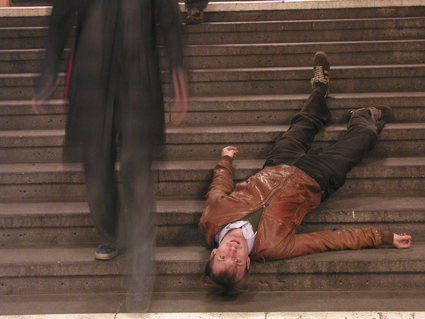
Super Night Shot
photo courtesy Gob Squad
Super Night Shot
The company now works with a core of six and a growing series of guest artists who orbit the company’s collective practices and serve to enrich the world of Gob Squad. It’s a fairly unique entity in the world of performance, working without a director or hierarchy, making decisions together about each part of the work. We asked Sean Patten how they had managed to make a collective work over their 18 years. He told us about one of their most recent works, Are you with us, which addresses the difficulties of working together. The members interview each other, asking the difficult and potentially dangerous questions that they wouldn’t dare ask in private, each taking it in turn to play the role of counsellor or life coach. The results, said Patten, are funny and surprisingly therapeutic.
In the world of big business there is an increasing interest in collaborative, networked approaches to corporate environments. In offices across the world, projects called In touch, Blue Sky and Horizons are taking shape, trying to understand how collective learning, sharing and non-competitive approaches might function in the workplace. In the fraught world of the corporation it will take a long time for change to really be felt across the culture of work. In this context Gob Squad’s example might be held up as a shining beacon for collective working practices in action. If life really is a series of tests of grace under pressure, then Gob Squad are model modern citizens.
Patten says that Gob Squad’s members all remain ideologically committed to the idea of group work, which is always going to be better than work they make on their own—they don’t want to be solo artists. “You have to be a bit of a communist in order to be in Gob Squad.” He uses the metaphor of marriage or family: resentments build up, arguments and heated discussions happen and it takes the sort of work you would put into any relationship, checking in, talking about things, not leaving things to remain difficult.
“We remain interested in the world, hungry to experience culture, politics, the news and television. We start each day of rehearsal with a discussion of the books we are reading, the films we are watching, exhibitions we see.” This cycle makes sense to them, they are both producers of culture and consumers of culture.
Although Gob Squad has performed Super Night Shot over 140 times in various parts of the world, it remains an unfinished work. Patten says “It is a great mix of things that are planned and things that randomly happen on the streets. So while we may have performed the show over 140 times, we never tire of it, it always feels like the first time.” And this is true of all of their work. Gob Squad are the pop stars of contemporary performance, their much anticipated better-late-than-never arrival on Australian soil can, for performance enthusiasts, be likened to the Beatles’ tour of Australia in 1964 or perhaps Abba in 1974. Super Night Shot is one performance not to be missed in the 2011 Sydney Festival, so buckle up, you’re in for a hell of a ride!
See “Gob Squad saves the world,” RT83, p34 for Panther’s account of their encounter with the company in Europe in 2008.
Gob Squad, Super Night Shot, The Studio, Sydney Opera House, Jan 25-30, 9pm; presented by Sydney Festival, Performance Space and Sydney Opera House; www.sydneyfestival.org.au; ACMI, Melbourne Feb 3-5 www.acmi.net.au/; World Theatre Festival, Brisbane Powerhouse, Feb 10-12, www.brisbanepowerhouse.org
RealTime issue #100 Dec-Jan 2010 pg. 4
© Panther ; for permission to reproduce apply to realtime@realtimearts.net
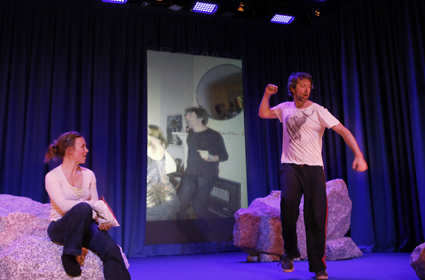
Intimacy, Ranters Theatre
photo Jeff Busby
Intimacy, Ranters Theatre
PREMIERING AS PART OF THE MELBOURNE INTERNATIONAL ARTS FESTIVAL, RANTERS THEATRE’S INTIMACY BEGINS WITH A SMILE. IT’S THE LOVELY, BEGUILING, DISARMING SMILE OF THE ACTOR PAUL LUM, DIRECTED AT US, THE AUDIENCE, AND ECHOING THE BEGINNING OF RANTERS’ PREVIOUS PLAY, AFFECTION, WHICH ALSO BEGAN WITH THE ACTORS SMILING AT THE AUDIENCE, IN THAT CASE, FROM THE COMFORT OF A COUCH. THE RANTERS SMILE IS NOT A MASK OF HAPPINESS BUT AN ATTEMPT TO MAKE US COMPLICIT WITH THOSE ONSTAGE.
ranters’ intimacy
The success of this attempt is beside the point. Ranters does not seem concerned with whether we trust the smile or not, because it is the attempt that makes manifest the slipperiness of the social contract inherent in the relationship between actor and audience. No matter how open and charming the actor’s smile, it still seems odd and unnaturally jaunty, like the quizzical gesture of someone feigning recognition at a party of half-remembered acquaintances. Indeed, is Paul Lum actually smiling at us, or is it his onstage persona? And does he actually see us, or is he simply smiling at the black void below the bright lights? And, with a nod to Zen, how much does our presence matter?
Later in the production, a character tells Lum that he is a good listener because “you’re there, but not there,” like a priest behind the confessional, the paper of the diary or the analyst behind the chaise longue. In Ranters’ theatre, the audience is similarly there but not there—we are good listeners precisely because we are imagined rather than active interlocutors, intimates invited in by an ingenuous smile. But again, the success of the invitation is beside the point.
Ranters’ aesthetic fundamentally relies for its dramatic tension on the slippage between the performer’s invitation and the audience’s response. There is typically no plot and minimal character dynamics. Raimondo Cortese’s writing evades obvious subtexts and thematics. Instead, the actors speak of ordinary happenings, of personal thoughts in a meandering manner that defies obvious interpretation. Nevertheless, the mere ordinariness of the text invites listening and, crucially, interpretation—because we are in a theatre, where we expect things to mean something. Thus, by simply framing and detailing the ordinary, Ranters engages the audience in the process of theatrical meaning-making until the ordinary becomes something else that both reflects what it emerged from and transcends it.
In Intimacy, the distinction between the ordinary and the theatrical is twisted even more by its simple conceit—the vox populi. We are led to believe that Lum ventured out one balmy St Kilda night and asked strangers to chat. And they did. Or did they? It is one of those glorious suspensions of disbelief that some in the audience would not think to question. That we can believe that a pilot with panic attacks, an emotionally distant father who loves roller coasters, a man who performs birds and a chef who cannot sleep would all talk to Lum around Fitzroy Street on the same night is, in hindsight, extraordinary. But at the time, it all seemed so ordinary. That’s Ranters.
jack charles v the crown
Jack Charles V The Crown is based on the life of one of Melbourne’s most admired, beloved and recognisable actors. Jack Charles, born in 1943, was one of the Stolen Generation and his life, no matter how idiosyncratic or personal, is inevitably representative of this most rending of experiences. Nevertheless, Charles is defiantly not one to stick to a script, as he winkingly acknowledges after roaming off his cues a few times.
Early on, Charles shows us a slideshow of his childhood, filling in the images with anecdotes and self-effacing humour. Though the breezy language and inescapably cute faces in the photos push us into the realm of This Is Your Life, the effect is perfectly undercut by a slightly off-key violin note from Nigel MacLean that keeps the tone uneasy and complicated—not everything is snowdrops and nostalgia.
Charles’ knack for pottery, which he picked up during a gaol stint, is a central motif of the piece. At the start, we see him at his wheel, throwing a vase. He tells us the Kulin Nation creation story of Bunjil and Pallian, the first men, shaped by Birrarung clay. He shares a tender and beautiful moment of falling in love with another prisoner as he teaches him to shape the clay, the reverie of their touching made all the more sweet by Charles’ memory of “his PK spearmint breath.” The pottery wheel keeps spinning and coming back to the same place, but each revolution and glide of the fingers redefines the subject little by little.
In many respects, Charles’ stage presence is this piece. His warmth, effusiveness and gentleness draw us in, his deft touch with language and song wins us over. The structure is wandering, like the man himself, and never in a hurry, but never happier than when walking and talking.
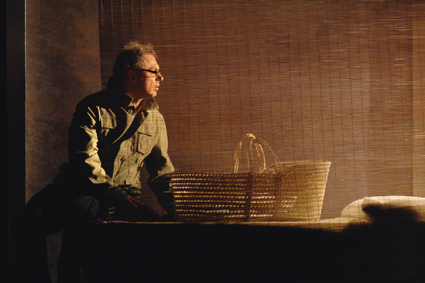
Blue Dragon, Ex Machina
photo Yanick Macdonald
Blue Dragon, Ex Machina
robert lepage, the blue dragon
When Robert Lepage comes to town, chances are there will be an army of black-clad theatre technicians stuffed into his valise. His production of The Blue Dragon does not disappoint on that level, with extremely detailed and ingenious scenography and spatial transformations.
The play represents Lepage’s second bite at the cherry of China. In 1985, his company, Ex Machina, produced The Dragons’ Trilogy, which refracted three generations of Chinatowns in Canada’s major cities into a spectrum of experiences that looked at China from afar. In fact, the Trilogy was less about China than Canada. The Blue Dragon is set in China but still it is more about Canadians suffering a bout of Orientalism than about the country it is set in, which steadfastly remains the Other in an unreconstructed sense. The narrative is a progression of hackneyed situations and the piece as a whole feels like a Fabergé egg, a hollow confection.
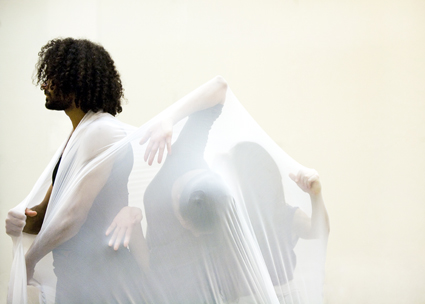
Vertical Road, Akram Khan Company
photo Rachel Cherry
Vertical Road, Akram Khan Company
akram khan, vertical road
Fresh from its British premiere, Akram Khan’s latest dance piece, Vertical Road, begins in an unexpectedly literal manner. Seven figures covered in chalk stand in deathly stillness in front of a scrim. Their costumes evoke both the tight winding sheaths of fabric of East Asia and the looser robes of Sufism, but in their stillness and texture they bear a clear resemblance to Emperor Qin’s faded Terracotta Army. An eighth dancer remains outside this wedge formation of warriors and discovers at the front of the stage seven tablets arranged carefully but precariously on their sides. He inspects them with curiosity and then knocks them over like dominoes, a booby trap that revivifies the army of clay behind him. Alas, Harrison Ford does not appear with a whip and a hat to safely lead our hero past the flaming gates and rivers of mercury.
Instead, Khan’s imagery grows in confidence and complexity, threading together disparate motifs and ideas into a visual narrative that is borne along by Nitin Sawhney’s throbbing sweeps of drums and strings. From Plato’s Cave to whirling dervishes, from the invisible puppet strings of fate to the devotion of impassioned lovers, the choreographic language builds and extrapolates, always reaching towards ascension.
Ascension comes at the end of Vertical Road and is, appropriately, its most startling and transformative achievement. The scrim at the back of the space is the liminal point of communication between mortal and immortal worlds. Like the plane of water in Bill Viola’s Three Women, it diffuses and obscures the eternal figures behind it. As barely visible streams of water cascade down the scrim’s surface and haze fills the space behind it, a lone dancer, reaching towards the hands beyond, breaks through in a flash of golden light that unifies for one breathtaking instant the physical and metaphysical.
2010 Melbourne International Arts Festival: Ranters, Intimacy, devisor, director Adriano Cortese, text Raimondo Cortese, co-devisors, performers Beth Buchanan, Paul Lum, Patrick Moffatt, set & costume design Anna Tregloan, lighting Niklas Pajanti, sound design David Franzke, video Keri Light, choreography Alison Halit, Malthouse, Beckett Theatre, Oct 1-23; Jack Charles V The Crown, performer Jack Charles, co-writers Jack Charles, John Romeril, director Rachael Maza Long, design Emily Barrie, lighting Danny Pettingill, music Nigel MacLean, Fairfax Studio, The Arts Centre, Oct 12-17; Ex Machina,The Blue Dragon, director, writer Robert Lepage, writer Marie Michaud, design Michel Gauthier, choreography Tai Wei Foo, Playhouse, The Arts Centre, Oct 8-12; Akram Khan Company, Vertical Road, choreographer Akram Khan, composer Nitin Sawhney, devised & performed by Eulalia Ayguade Farro, Konstantina Efthymiadou, Salah El Brogy, Ahmed Khemis, Young Jin Kim, Yen-Ching Lin, Andrej Petrovic, Paul Zivkovich, costumes Kimie Nakano, lighting Jesper Kongshaug, design Akram Khan and collaborators, Merlyn Theatre, Malthouse, Melbourne, Oct 19-23
RealTime issue #100 Dec-Jan 2010 pg. 6
© Carl Nilsson-Polias; for permission to reproduce apply to realtime@realtimearts.net
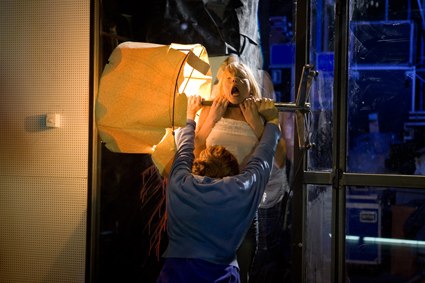
Opening Night, Toneelgroep Amsterdam
photo Jan Versweyveld
Opening Night, Toneelgroep Amsterdam
FROM A DISTANCE, IT WOULD APPEAR THAT BRETT SHEEHY’S SECOND MELBOURNE FESTIVAL WAS THE MOST CONTROVERSIAL IN YEARS—NOT FOR WHAT IT OFFERED, BUT FOR WHAT IT LACKED. CRITICISING AN ABSENCE IS ALWAYS A SHAKY STARTING POINT, BUT FOR ME THE FREQUENT KEENING (FOR A NO-HOLDS-BARRED-EPIC; FOR A CENTRAL CONVERSATION HUB; FOR A CITY-CHANGING EVENT) DREW ATTENTION AWAY FROM THE FACT THAT WHAT WAS PRESENTED WAS OFTEN EXCITING, REWARDING OR SURPRISINGLY ENGAGED WITH ITS ENVIRONMENT. THE HITS OUTWEIGHED THE MISSES, AND EVEN THEN THE TRAIN-WRECKS WERE MOSTLY HEAD-TURNERS.
toneelgroep amsterdam, opening night
Take Toneelgroep Amsterdam’s Opening Night, an outrageously ambitious and strikingly realised merging of realist drama, filmic de- and re-construction and theatrical conjuring. Taking its cues from the screenplay of the 1977 Cassavetes film (RT99, p15), it presented the behind-the-scenes preparation for the premiere of a new play in which interpersonal tensions and past grievances threaten to derail proceedings. The imminent meltdown of the leading performer acted as an emotional 18-wheeler bearing down on the edifice of appearances erected to conceal these fragile relationships.
Simultaneously, a set of real time cameras and projections reproduced the live performances as a filmic spectacle beamed across the space and on downstage monitors. The result was both a hyperreal, immediate play and a fragmented panoply of artificial surfaces, each of which could not be fully separated from the other. The power of the screen image to seduce our gaze constantly asserted itself, even if that image was just the second-order rendering of the fleshy, three-dimensional bodies being flung around the stage before us. Cinema’s epistemological status as a negation—as always referring to an elsewhere, an else-when—also produced a rich confusion, compounded when the projected image seemed to lag behind the real events, or freeze. Technical hitch or cunning ploy? What does it matter?
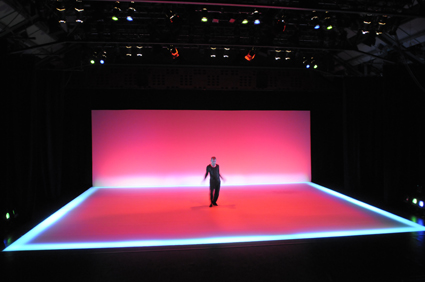
Hiroaki Umeda, Haptic
photo Alex (sic)
Hiroaki Umeda, Haptic
hiroaki umeda, adapting for distortion, haptic
An astonishing technological wizardry also animates Japanese choreographer/dancer Hiroaki Umeda’s paired billing of Adapting for Distortion and Haptic. In both, light is central to any meaning generated by the work—the body subsumed by the post-human abstraction of light. Indeed, Umeda seems to epitomise Donna Haraway’s conception of the ideal cyborg as a machine made of sunshine. Identity and the individual are stripped by the excoriating divinity of luminescence, but this works to radically different effect in the two pieces.
Adapting for Distortion is a monstrously visceral encounter with the binary order of 21st century technology. Fast-shifting grids of light, expanding and contracting potentially infinite horizons destabilise any sense of depth, in a case of Cartesian perspective taken beyond the capacity of the mind to comprehend. Approaching the sublime in its most classically terrifying of definitions, it was seizure-inducing stuff that made for anything but a pleasant experience. Hard to argue with its effectiveness, however, and the work, though brief, acted as a potent reminder of the unseverable connections between our physical forms and the perceptual capacities that orient them in space and time.
Haptic presented a marked contrast in tone. Here the dancer was a liquid shadow against warm, shifting waves of coloured light; a half-visible organism skittering across the surface of a radiant lake of unfathomable depth. Where Adapting to Distortion’s alien landscape was one of cold dislocation, Haptic produced a pre-Oedipal plenitude, the return of the individual into a fullness of being where world and self no longer suffered rupture.
It seems paradoxical that within these two works Umeda still managed to carve out a distinctive style of dance. Though he may now claim to be more visual artist than choreographer, his performance still drew on techniques of classical dance and hip-hop—body rolls that defied the limits of the skeletal, foot-slides of eye-blinking dexterity.
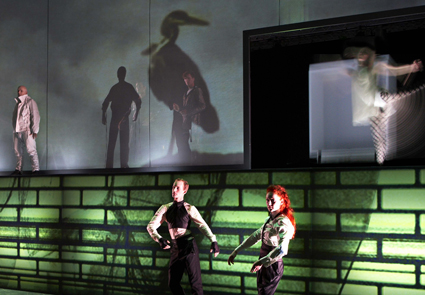
Tomorrow, In A Year, Hotel Pro Forma
photo Claudi Thyrrestrup
Tomorrow, In A Year, Hotel Pro Forma
hotel pro forma, tomorrow, in a year
Despite this particular style, it’s not easy to determine Umeda’s contributions to Hotel Pro Forma’s electro/dance opera Tomorrow, In A Year. He is billed as “choreographic consultant” but none of his signatures are legible—instead, the elements of dance here appear so naively rendered as to make me wonder if this is deliberately the case.
Tomorrow, In A Year is one of those rare encounters where I wonder too if some elaborate prank is being pulled. It’s self-consciously obscurantist, visually drab and gestures towards complexity and exquisite chaos without actually engendering either. It takes its inspiration from the life and writings of Charles Darwin, but its collision of elements—divergent modes of dance, vocal styles, visual effects and the very forms of opera, electronica and postmodern theatre—result less in a new species of performance evolving beyond its ancestors than a lumbering Frankenstein’s monster in natty duds. There’s no natural law which states that the combination of random genes will produce a hybrid able to survive, any more than a random combination of words will result in a comprehensible sentence. And while the libretto may have drawn heavily on Darwin’s own words, phrases such as “Scissor-beak lower mandible flat elastic/it’s an ivory paper-cutter” make me focus less on the evolutionary arc of the avian than the increasing furrow of my brow.
michael clark company, come, been
& gone
If Tomorrow, In A Year falters under the weight of its own ambitions, Michael Clark Company’s come, been and gone is crushed beneath the onus of its own history. Paying tribute to several decades of work by the renowned British choreographer, its supposedly groundbreaking rebellion appears tired and shorn of context today. Set to a series of songs by artists such as David Bowie and Lou Reed, at its worst it presents an embarrassing literalism: The Velvet Underground’s “Heroin,” for instance, produces a dancer in a flesh-coloured bodysuit studded with foam needles writhing around in someone’s half-baked notion of a drug nightmare. For Bowie’s “Heroes,” the audience is even provided a large-scale projected video of the track’s video clip—it’s a hard task for rather uninspired dancers to compete with such an iconic figure, especially when the image isn’t deployed with the kind of understanding of its fascination suggested in Opening Night.
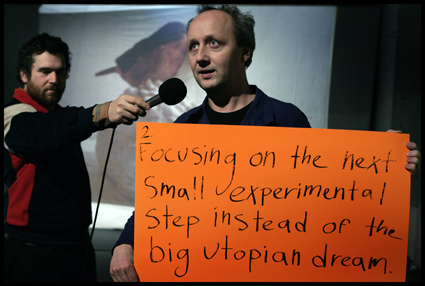
An Anthology of Optimism, Jacob Wren, Pieter De Buysser
photo Phile Deprez
An Anthology of Optimism, Jacob Wren, Pieter De Buysser
wren & de buysser, an anthology of optimism
There is inspiration to be found in Jacob Wren and Pieter De Buysser’s An Anthology of Optimism, but it’s of a coy and delicate sort. The pair—both writers, one a performance artist and the other a sort of contrarian humorist and philosopher—present a lo-fi dialogue exploring a notion of “critical optimism.” It’s a somewhat Socratic exchange with a clear argument and obvious structure. Wren is established as a sceptic, suspicious of the potential for optimism to bear any efficacy in a contemporary climate as troubled as ours; De Buysser takes the case for an optimism which admits of the world’s troubles without succumbing to defeat. Eventually they find some agreement: a cautious kind of positivity that promotes small steps in the face of big problems. It’s not radical thinking, but it makes its point both succinctly and without excessive guile.
The conceit of the production is delivered in a style that often threatens to tip over into a terrible tweeness. A retro slide projector, hand-written signs and a manually operated sound system nod to the mode of conspicuously no-frills, DIY theatre, but there’s a strained casualness to the performances that seems the result of much effort not to become mannered or artificial. Perhaps that would have created a tone of seriousness, undermining the inherently didactic nature of the work; these days, self-conscious irony is a more acceptable way of putting forward very political points.
But this is exactly the sort of work that, for me, fleshes out an international festival. It’s not a grand showcase of spectacular talent—as works like come, been and gone and Tomorrow, In A Year indicate, such productions too often make for monumental disappointment. Opening Night proved the exception, but on a smaller scale this year’s festival was marked by a great number of successes that add up to something more than two weeks of art with a single defining moment. I don’t know that festivals of this sort need such a defining moment. Rather than stamping in our minds an image of one event over all others, this year made for a plurality of miniature epiphanies and quiet fades, even blurring into the surrounding non-festival productions. That’s worth our attention, at least.
2010 Melbourne International Arts Festival: Toneelgroep Amsterdam, Opening Night, after John Cassavetes’s Opening Night, director Ivo van Hove, design, lighting Jan Versweyveld, video design Marc Meulemans, Playhouse, Victorian Arts Centre, Oct 20-23; Adapting for Distortion, Haptic, choreographer, dancer Hiroaki Umeda, sound S20, images S20, Bertrand Baudry, lighting S20, Hervé Villechenoux, Merlyn Theatre, Malthouse, Oct 14-17; Hotel Pro Forma, Tomorrow, In A Year, directors Ralf Richardt Strobech, Kirsten Dehlholm, music The Knife, design Ralf Richardt Strobech, State Theatre, Arts Centre, Oct 20-23; Michael Clark Company, come, been and gone, choreographer Michael Clark, lighting design by Charles Atlas, costumes Stevie Stewart, State Theatre, the Arts Centre, Oct 8-10; Pieter De Buysser and Jacob Wren/CAMPO, An Anthology of Optimism, Fairfax Theatre, the Arts Centre, Oct 20-23
RealTime issue #100 Dec-Jan 2010 pg. 8
© John Bailey; for permission to reproduce apply to realtime@realtimearts.net
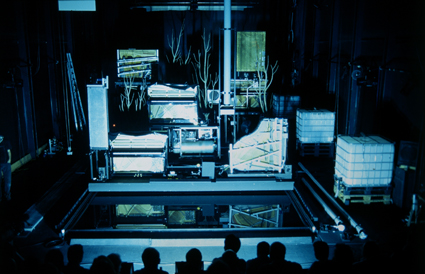
Stifters Ding
photo Mario Del Curto
Stifters Ding
WHAT IS A ROSE BEFORE IT HAS A NAME? WHAT IF OUR ABILITY TO INTERPRET AND INTERVENE, OUR AGENCY TO DECIDE WHAT THINGS ARE, RECEDED AND WE COULD SEE THE WORLD WITHOUT ADJECTIVES, UNMEDIATED BY INTENTION? TO WHAT EXTENT ARE WE MADE IN TURN BY THE WORLD WE THUS CREATE? AND WHAT IS THE AGENCY OF THINGS? BETWEEN CARNIVAL OF MYSTERIES, HOTEL PRO FORMA, HEINER GOEBBELS’ STIFTERS DINGE, DAVID CHESWORTH’S RICHTER/MEINHOF-OPERA, SOME VAST GROUND ON THE TOPICS OF SYMBOLISATION AND REPRESENTATION WAS COVERED. IT SOUNDS PREPOSTEROUS; BUT THIS IS HOW.
richter/meinhof-opera
David Chesworth’s Richter/Meinhof-Opera was a highly anticipated take on the Red Army Faction’s Ulrike Meinhof. Announced as a 45-minute, pocket performance artwork (opera it wasn’t), it was an even shorter, quieter beast than expected. Tackling a potentially inexhaustible subject with an absolute minimalism of input and effect, it treads that usual fine line between the open-ended and the non-committal. It barely skims the complex story of Meinhof, respected journalist who joined a terrorist organisation, and whose simultaneous canonisation as left-wing martyr and demonization as Communist murderer still divides Germany. The only trace of the other members of the RAF is a record player, playing an Eric Clapton track, exactly as it did when Baader committed suicide in his prison cell. This is a rare instance in which the music goes beyond atmospheric soundscape; the other is a string duet, which mellifluously contrasts with the rest of the work, enhancing its thinness somehow. A few of Meinhof’s best-known quotations are projected onto ACCA’s shard-like walls, while centre-stage stands Gerhard Richter (Hugo Race), who famously painted RAF members’ death portraits in 1988, and was accused of mythologising terrorism.
The intended core of this work is the enormous disjuncture between direct action, advocated by Meinhof (often paraphrasing Brecht), and the indirectness and detachment of representational art, which often gives life to such ideas. The inability of our own cynical, ideologically unconvinced contemporary era to present the full spectrum of Meinhof’s time is another big theme. However, to say that Richter/Meinhof-Opera ‘explores’ them would be to give it excessive credit. Between Richter’s moody, detached canvases, the monochrome photos of the stylish Faction (which overwhelmingly comprised young women) and the occasional discursive duet (the libretto is a slim pastiche of quotations), the myth of RAF is presented as a matter of aestheticising or not; and the issue of direct action as a matter of professional ethics (to identify or not with one’s subject matter). Cold War politics lie forgotten, and ideas are not so much revealed as hinted at.
Even Richter, whose engagement with RAF is the focal interest of the opera, remains shorthand for the generic Artist. Evading all the big questions on this big topic, Richter/Meinhof-Opera feels and looks as if in development, like a sketch for a bigger work.
stifters dinge
Those who work with things (sculptors, architects, furniture makers) are often perplexed by the readiness with which more idealist disciplines (theatre, poetry) turn this material into signs and ideas. The result is frequently naive mystification, or embellishing fetishism: we have all seen signed urinals, soup cans, as well as their less rounded children—from derelict buildings employed as metaphors to artsy tapestries. What makes Heiner Goebbels’ Stifters Dinge so remarkable is that it does none of this, and has its audience enraptured. Its form is sui generis: a peopleless performance, or perhaps just a giant moving contraption. And yet, its workings are magical, for idealists and materialists alike.
Stifters Dinge’s dramaturgy is a sequence of apparently unrelated mechanical events: light changes, mechanical actions, sound clips and video projections. These are organised around a host of motifs: principally, the writings of Adalbert Stifter, a 19th century Austrian novelist whose prose is notoriously thickly furnished, upholstered, landscaped. (Literary lore has it that modernisation was already making advances into the order of things, and that 19th century naturalism was a kind of urgent stock taking.) Other motifs are the Renaissance dicovery of geometric perspective (chiefly Paolo Uccello’s paintings), utilitarian traditional music (Greek, Papuan, Colombian), voice recordings of Malcolm X. With technical perfection, the sequence of mechanical events coalesces into a world, all whilst remaining first and foremost mobile matter, without metaphors or superimposed meaning. The work builds into a deeply satisfying and meaningful totality by making us aware precisely of the bottomless materiality of its devices. When dry ice bubbles up in the three shallow water pools, seeing the trick does not stop the entire audience from holding their breath in awe. Stifters Dinge purges the stage of illusion and interpretation, but the ‘things’ that remain are neither threatening nor banal. Rather, they assume almost sacral fullness.
carnival of mysteries
Carnival of Mysteries, conversely, is an image of a carnival world. It has it all: tents, noise, nudity, candy floss, its own (inflated) currency and many short acts of varying skill and engagement. It is as entertaining and uneven as any carnival. It is also no more dramaturgically cohesive, nor exploratory: neither does it try to bring a superior level of artistry to the content, nor interrogate the form (in the vein of One-on-One Festival; RT99, p10). With many times more mini-shows than can be experienced in the allotted two hours, it is a somewhat frenzied experience, lacking the relaxed atmosphere of a fair. But the intensity does not translate into superb artistry, at least not in the fraction of the shows I witnessed. Should we be deconstructing it critically, suspending critical judgement, or witnessing it referentially? If Carnival is the answer, what is the artistic question? Is it a lowbrow event for a highbrow audience, with highbrow performers? Is it a replacement for Spiegeltent, which used to be the place at MIAF for circus, burlesque and other kinds of friendly lowbrow? A ‘carnival but of another kind,’ it is both too close, and once removed.
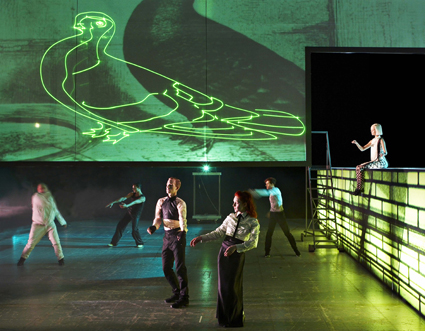
Tomorrow, In A Year, Hotel Pro Forma
photo Claudi Thyrrestrup
Tomorrow, In A Year, Hotel Pro Forma
tomorrow, in a year
Hotel Pro Forma’s Tomorrow, In a Year, an ‘electro opera’ about the life and work of Charles Darwin, was the most controversial show of this year’s MIAF (its response coming close to the outrage caused by Liza Lim’s The Navigator in 2008 (RT87, p8); opera is clearly fraught cultural ground in Melbourne). It is a conceptual work, with no plot to retell. It explores the thematic links between four moments in Darwin’s life—including the death of his daughter (potentially linked to his marriage to a first cousin)—and the implications of his theory . The endless mutability of the natural world, whose laws form us despite our pretended detachment, and whose laws we can never break, is the terrible heart of this work. It opens with potentially bewildering, undifferentiated stage sludge, an image of the original primordial soup of life; it ends as accelerating hydroponic chaos, or perhaps complex order?
The stage imagery is poor: only two planes of horizontal movement, no interaction between the performers, green laser beams and much dry ice. Using botanical drawings and video footage of water, Hiroaki Umeda’s algae-like choreography and the occasional verse about geological time and entombed carcasses, it explores a complete intangible: the fact that the material world is bigger than a human being, that we do not become through it, but are crushed by it.
But unlike Chesworth’s non-committal opera, it is fully exploratory. A note of the Romantic sublime runs through the work, unnoticed by those who bemoan its coldness. It unearths a potential Western counterpoint to the Japanese concept of ‘mono no aware’: the awareness of the dyingness of things, of the essential inability of matter to last. Just as cherry blossoms are less pretty than tragically transient, so is Tomorrow, In a Year not so much beautiful to watch as it is a despairing attempt to grasp cosmic complexity.
In the absence of meaningful stage action, enjoyment of this opera is strongly predicated on appreciating the music, by the Swedish electronic duo The Knife, which forms its narrative, emotional and intellectual core. It is a complex composition of natural and electronic noises, bel canto, house beats, borrowings from Purcell, early polyphony. And yet this collage of pop and found remains staunchly anti-metaphorical, a postmodernist pile of stuff asking to be understood literally: when Kristina Wahlin sings that “epochs collected here,” she is relating a geological fact, not a poetic truth.
While the work has been hailed as showing the future of the operatic form, it seems to succeed largely in musical terms. Visually, it attempts an abstract variation on a nature documentary, with results too reminiscent of late 1990s raves to be genuinely eligible for the label ‘innovation.’ Knowing that cyborgs, virtual reality and Dolly the Sheep were all the rage circa 1998 provides some dramaturgical solace, but does not compensate for Tomorrow, In A Year falling short of its promise.
2010 Melbourne International Arts Festival: Richter/Meinhof-Opera, direction, music, sound design David Chesworth, text David Chesworth (after Tony MacGregor), performers Kate Kendall, Hugo Race, lighting Travis Hodgson; ACCA, Oct 14-16; Stifters Dinge, concept, music, direction Heiner Goebbels; Malthouse, Oct 8-11; Carnival of Mysteries, creators, directors Moira Finucane, Jackie Smith, production design The Sisters Hayes; fortyfivedownstairs, Oct 6-30; Hotel Pro Forma, Tomorrow, In A Day, directors Kirsten Dehlholm, Ralf Richardt Strobech, music The Knife; Arts Centre, Melbourne, Oct 20-23
RealTime issue #100 Dec-Jan 2010 pg. 10
© Jana Perkovic; for permission to reproduce apply to realtime@realtimearts.net
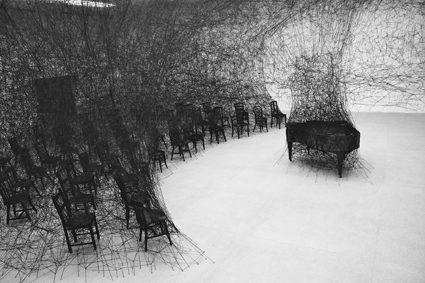
Chiharu Shiota, Biel Klavier
photo courtesy the artist
Chiharu Shiota, Biel Klavier
WHEN BRIAN RITCHIE IS NOT CURATING THE MONA FOMA FESTIVAL OR TOURING WITH ONE OF HIS BANDS, HE IS RUNNING A TEA SHOP WITH HIS WIFE IN HOBART. DISCUSSING THE MENU HE SAYS “THERE’S THIS DISH CALLED NATTO. IF YOU TELL A JAPANESE PERSON ‘I LIKE NATTO,’ THEY SAY ‘NO, WESTERNERS CAN’T EAT THAT, IT’S ONLY FOR JAPANESE.’
“We put that on the menu and just call it soybeans and a lot of vegetarians and other people order it, unsuspecting. They say ‘This is wonderful, I love this,’ because nobody has told them that they’re supposed to be afraid of it.” It seems Ritchie’s culinary strategies perfectly reflect his curatorial approach to MOFO—one of the most interesting Australian festivals to emerge for quite some time.
The Museum of Old and New Art Festival of Music and Art (MONA FOMA, or MOFO for short) landed in 2009, as Ritchie puts it, “like a meteor smacking into Tasmania.” In 2008 Salamanca Arts Centre approached the then studio resident Ritchie (the former bass player of Violent Femmes had recently relocated to Hobart) to curate a music festival. Initially Ritchie said no, but “then of course my ego got in the way and I thought, ‘well, if I had a festival what would it be like?’ and I started to fantasise. I drew up a proposal for something that looks remarkably similar to MONA FOMA, and we went to David Walsh looking for sponsorship money.” Walsh, owner of Moorilla, one of Tasmania’s oldest wineries, has a history of arts philanthropy, including an ongoing relationship with BalletLab (see interview with Phillip Adams) and has been building the Museum of Old and New Art to house his extensive art collection. Along with marketing manager Lee Carmichael, Walsh decided that rather than sponsor the event, he’d like to partner it. With this backing, the Tasmanian State Government also came on board and by January 2009—a remarkably short turn-around time—the first MONA FOMA was thrilling Hobart’s locals and visitors.
an experimental flavour
While billed as a festival of music and art, music is the primary focus, with the performance and visual art elements of the program exhibiting a strong reliance on and collaborative approach to sound. However, unlike the majority of music festivals in Australia, MOFO is decidedly genreless—alternative rock/pop sits happily beside jazz, classical, world music, experimental electronic, improv and sound art. The broadest sweep indicates that there is an emphasis on instrumental rather than vocally driven music but the programming really takes its flavour from Ritchie’s appreciation of and search for the experimental across this broad range of styles. This allows for the mingling of international headline artists like Nick Cave, John Cale and Philip Glass with Australia’s most interesting, emerging and established experimentalists.
Ritchie points to a challenge: “Music is the comfort food of the arts…[It’s] the artform where people are trying to re-live something. That’s the reason 50,000 people will go to something like U2. It’s comforting for them.” Therefore, “one of the things we pride ourselves on,” says Ritchie, “is packaging the content of the festival in a really engaging fashion—to get people to listen to music that they’re not familiar with.
“Mostly we present unknown artists, or in some cases known artists, doing new things—[allowing] them to explore various facets of their creativity. For example last year we had John Cale. Everybody knows that John Cale is from The Velvet Underground, but [for MOFO] he played rock music, he played some classical music, he did some solo improvised piano, he did an art installation. You’re seeing a lot of different sides of John Cale that you don’t normally see.”
The MOFO team seem quite skilled at creating a sense of openness that invites audiences to try new things, from the clever juxtapositions within programming to the laidback, unpretentious marketing copy. Ritchie says, “A lot of times I think people are kind of defensive about what they’re putting out there in front of the public. ‘You might not like this,’ or ‘this is going to challenge you.’ How do you know? It’s presumptuous to assume that people are going to be challenged by something. Maybe people are going to say, ‘Wow, this is what I’ve been waiting for my whole life. Why haven’t I heard this before?’ In fact people have told me that.”
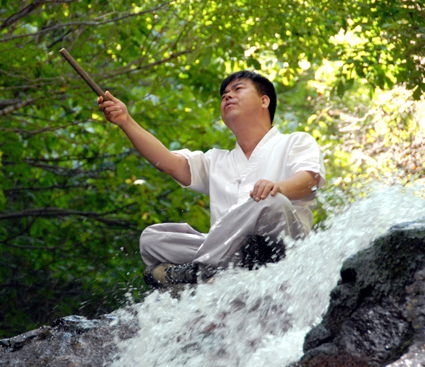
Bae Il-dong
photo Emma Franz
Bae Il-dong
the menu
The 2011 program is still taking final shape, but Ritchie is able to share several highlights. One of the high profile artists this year, as mentioned, is Philip Glass. Nick Cave will be returning to MOFO with his compatriots Warren Ellis, Martyn P Casey and Jim Sclavunos, as the Grinderman, to present their swampy, epic tales. Also from the more popular, yet gritty end of the spectrum will be the Jon Spencer Blues Explosion.
Melbourne’s Speak Percussion celebrate their 10th birthday with a massive percussion orchestra installed around the Princes Wharf venue presenting an all-percussion program including Edgar Varese’s Ionisation, along with a world premiere of a work composed by Anthony Pateras (who will also appear in MOFO with the Pateras/Baxter/Brown trio).
Ritchie is particularly excited about Chiri, a collaboration between renowned Australian jazz musicians Simon Baker (drums) and Scott Tinkler (trumpet) and traditional Korean singer Bae Il-dong, whose technique was acquired by singing into a waterfall 18 hours a day for seven years. Ritchie, a shakuhachi player himself, is no stranger to the difficulty of such cross-cultural musical mixes and considers this a particularly exciting fusion of world music and jazz.
In quite a different exploratory vein, Australia’s Jon Rose will return after last year’s cycling concert (RT90, p48) with another interactive experience—a giant ball that responds to audience play—as well as performing in virtuoso violinist mode. Other Australian artists include the Necks, the much beloved improv trio of Tony Buck, Lloyd Swanton and Chris Abrahams; Philip Samartzis, who will present his latest installation based on field recordings from Antarctica; and the audiovisual duo Botborg, who will induce hallucinations with their frenzy of sculptured static. Local Tasmanian electro-synth group Scientists of Modern Music will also play their home town as will SS2Q, an up and coming classical chamber ensemble.
While music is the focus, the gallery-based installations have been a highlight of previous festivals. Co-curated by Nicole Durling from MONA, this year’s program offers a range of impressive works including Australian Indigenous artist Brook Andrew’s Op-Art jumping castle (seen at the 2010 Biennale of Sydney) and Berlin-based Japanese artist Chiharu Shiota’s suspended, burnt-out piano inviting silent contemplation. Nor is the body forgotten with the inclusion of Philip Adams’ BalletLab presenting a trilogy of works: Above, Miracle and Amplification (see the interview with Adams, p23).
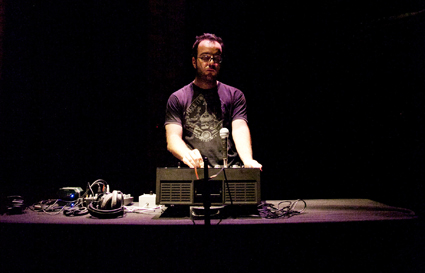
Anthony Pateras
photo courtesy MOFO
Anthony Pateras
a bonus course
After a week of MOFO activities in the heart of Hobart, the action will then move to the Moorilla Estate for the long awaited opening of the Museum of Old and New Art—a 6,000 square metre “secular temple” built to display David Walsh’s extensive collection of antiquities and contemporary marvels, exploring sex and death and everything in between. There’ll be more performances with concerts by the UK band Wire and Health from the US, a pyrotechnical spectacle by Groupe F from France, a “live car-crash sculpture” by Swiss artist Roman Signer, plus the provocations of Singapore-based Serbian performance artist Ana Prvacki.
a different kind of cooking
One of the most important aspects of MOFO is that the majority of performances (bar some of the headliners) are completely free. But Ritchie maintains, “You still have to engage [the audience], and draw them in, because people’s time is valuable.” Furthermore, the fact that MOFO is largely funded by private money perhaps frees it from some bureaucratic imperatives. Ritchie says, “I think there’s kind of an orthodoxy in the arts here—even the experimental arts—a way of doing things, and ticking boxes that we don’t really have to do…People are looking at us thinking, they’re not playing by the rules.”
What Ritchie wants to do in future festivals is offer more project-based creations like last year’s 48 Fugues for Frank, a collaboration with Michael Kieran Harvey and four visual artists [RT96, p40] celebrating the music of Frank Zappa. He says, “This year we have something like that with Tormented Gong by the Hong Kong New Music Ensemble and visual artist Samson Young. Next year we’ll have an opera we’ve commissioned. That’s the direction I’d like to go in rather than having a bunch of people doing their usual gigs.”
Ritchie is inspired to create these projects because he is deeply impressed by some of the great artists he’s found in Australia, like Michael Kieran Harvey, Eugene Ughetti, Robin Fox and Anthony Pateras. “It’s really fun to be able to get them to do what they want to do. A lot of the times artists say ‘What do you want from me, what do you want me to do?’ I say to them, ‘Do what you want to do.’ Sometimes they say ‘I’d like to have a triple orchestra’ [laughs]—but if it’s something that’s doable I like to just let them run with their ideas. When you give these artists a free hand then they usually come up with something dazzling.”
MONA FOMA, Hobart, Jan 14-20, MONA opening, Jan 21-23; www.mofo.net.au
RealTime issue #100 Dec-Jan 2010 pg. 11
© Gail Priest; for permission to reproduce apply to realtime@realtimearts.net
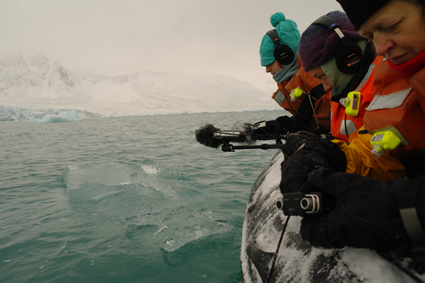
Interviewing the ice, Arctice Circle Artist Residency
photo courtesy the artists
Interviewing the ice, Arctice Circle Artist Residency
TENG CHAO-MING IS MARKING OUT AN AREA OF SNOW WITH LONG RED POLES AND PHOTOGRAPHING HIS NEW, POTENTIAL ‘HOME.’ THE MEASUREMENTS EXACTLY MATCH HIS FAMILY’S TAIPEI HOUSE. BEHIND HIM, THE MOUNTAINS HIORTHFJELLET AND LOUISFJELLET TOWER, THEIR SLOPES MERGING INTO THE FOREGROUND AND SHARP SUMMITS BLOWN OUT INTO WHITE SKY. A FEW GREY LINES ETCHED ON THEIR FLANKS GIVE THEM FORM.
Nearby but just out of shot, Mexican/US artist Rebeca Méndez is filming herself trudging through knee-deep drifts with a substantial flagpole and Mexican flag. Her figure crosses the preview screen: a tiny, comical beetle at odds with the dramatic background. Halfway through the take, the whole flag assembly flutters wildly in a gust before completely collapsing.
‘Nearby but just out of shot’ is how it often works here, as 19 artists from around the world negotiate quasi-individual relationships with the ‘sublime’ landscapes of Norway’s Svalbard archipelago, on a two-week sailing voyage at around 80° North. Here at Advent City, a deserted mining town boasting little but boot-slashing strips of rusted metal, our last day’s work, October 20, is in progress under the watchful eye of an armed guide—polar bears are present throughout these islands.
october 12: gravneset, magdalenefjorden
High on the north-west coast, it’s perfectly okay for New York’s Janet Biggs to set up a video camera and brace herself: she fires a flare gun into the sky, releasing a cloud of red smoke along with crackling shock waves. Nobody registers it as a call for help, because there’s nobody else for hundreds of miles around. A snow-white fox leaps out of a hollow, though, and dashes for cover. Biggs’ installation, Anana Dream, was shown at PICA in Perth last year—a video loop of endlessly swimming, zoo-bound polar bears. 2010 is her second Arctic Circle residency; she aims to complete a video work—a “kayak ballet” that both addresses our presence here and engages directly with power, fantasy, gender and desire.
Early in the voyage, we feel our way in an environment that is, in a sense, both fairytale and nightmare. At Gravneset, artist and trained coastal engineer, Jane Chang Mi (USA) is zipped into a dry-suit and swims in the freezing shallows between chunks of glacier ice. Later in the trip she spends an entire day aboard ship while everyone else hikes, making delicate blue and white ‘postcards’ that reference Svalbard’s somewhat ironic history as a tourist destination.
Cameras are a safety valve for the unsure or overwhelmed: if in doubt, document. But photographers Christina Seely (USA) and Regina Kokoszka (USA) settle in with ease and purpose; so do painters Saul Becker (USA) and Carrie-Ann Bracco (USA). Belgian Eric van Hove also has a clear focus: working with a concocted ‘scientific instrument’ which he calls an “anthropochronic theodolite,” he photographs a landscape rendered inextricable from his tripod, pendulum and human femur assembly. He’s “surveying in the anthropocene era, and suggesting the instalment of a series of new survey markers which include the human presence as a geophysical force.”
Day after day we’re delivered to new shores to “make work.” The struggle to think, respond and maximise each opportunity competes with the practical necessity of ‘suiting up,’ watching our step on treacherously loose rock, or trying to stay in one place without freezing to death. The challenge is one of the strengths of the program. Over two weeks at sea, Bracco, for example, is a constant, almost iconic presence: although her paintings read as ‘traditional’ within the gamut of contemporary practices, her commitment to daily two-hour plein-air sessions (working in a mix of oils and, inevitably, snow) reflects the resilience of everyone on board.
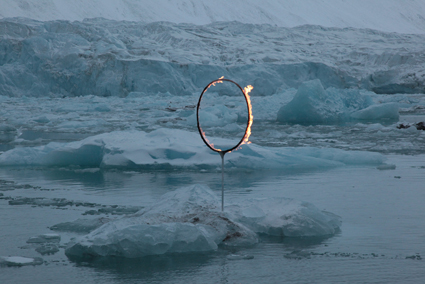
Arjen de Leeuw, Hoop
photo courtesy the artists
Arjen de Leeuw, Hoop
october 17: monaco glacier, liefdefjorden
Around mid-voyage, our ship spends a whole day close to the formidable Monacobreen, its five-kilometre front of crumbling blue ice rising to 80 metres high. ‘Bitty-bergs’ drift around us; now and then the thunder of a bigger, calving berg carries from the near distance.
Dutch video artist and sculptor Arjen de Leeuw makes a connection between memory loss and the melting of Arctic ice. “I look at the glacial landscape as a centuries-old storage space of the earth’s memory,” he says. “As the ice and its data moves into the sea, this data is no longer available, it is gone forever.” De Leeuw is making a film featuring our group as ‘cast’; Wendy Jacob (USA) has been co-opted as a scientist who has lost her memory. At Monacobreen, de Leeuw sets a flaming hoop on a chunk of floating ice and films the drifting, incongruous scene.
Wendy Jacob has a coincidental interest in glacial ice and its millenia-old air bubbles, whose sounds she hopes to record and embed in a tactile sound installation. Perth choreographer/performer Aimee Smith is also recording, fascinated with both the visual and sonic ‘fracturing’ of ice. (Smith is undertaking a development with dancers Aisling Donovan and Sharlene Campbell in December 2010, focused around the complications of water as a resource, and responding to The Arctic Circle experience.) Danish artist Eva la Cour joins Smith and Jacob for a Zodiac trip closer to the glacier to, as La Cour puts it, “interview the ice.” The scene is slightly absurd: three heavily-clad bodies, faces mostly hidden but brows furrowed, pointing recording devices at blobs of ticking, popping, whistling, melting ice as it bobs elusively by.
The absurdity of all artistic endeavour in the Arctic (or perhaps anywhere) is central to Chad Stayrook’s (USA) work. At every opportunity, he sets up a gigantic cardboard ‘telescope’ and is documented surveying the landscape searchingly; or co-opts others into wielding mysterious ‘tools’ “to interpret the unknown.” At Monacobreen, he zips back and forth amid the ice in the Zodiac, perched with his ’scope in the bow; his work aims to expose “the futile nature of such a search, as well as the liberation one might find within the futility.” Inspired in some degree by Melville’s Moby Dick, his solo show, The Search for an Unattainable Beast, opens in San Francisco in December.
october 14: moffen island
Our furthest point north is Moffen Island, startlingly different from Svalbard’s mountains and fjords—just a barely-exposed shoal covered in snow and driftwood. The absurdity continues: Temujin Doran (UK) and several others set up a ludicrous bocce game with coloured aluminium fishing floats—every activity here somehow takes on the sense of an ‘intervention.’ Rebeca Méndez manages to complete a film piece, Recurrence Relation #2—complementing earlier work in Iceland—despite driving, horizontal snow.
Laurie Palmer (USA) is one of several participants with specific interest in science, particularly “signs and markers of very slow time” including extremophile bacteria and lichens, some of which spend thousands of years chewing their way through rock. On Moffen she attempts to collect core ice samples with equipment borrowed from the University of Svalbard, hoping to have it analysed for “extreme life and extreme chemical inclusions.” Palmer is “looking for what is invisible in all that obviously spectacular landscape” and for changes “on scales other than human.”
Returning to the Arctic for her second voyage, Raphaele Shirley (USA) spends her time on Moffen filming the groups of walruses that swim up to the shore to examine us, in hope of completing a sequel to her film, StarGaze in Sandnes. Describing the immense and disarmingly curious walruses as “like some kind of oddly formed gods of antiquity,” Shirley articulates a desire to “echo the harmony of the environment and play with it and its meaning.” Her technically complex light sculptures (photographed at dusk, over water, using moving lights and long exposures) glow and hover like beckoning UFOs. Moffen Island, in particular, “feels like a portal,” she says. “Mental barriers melt and self, space, place, start resonating in a really strange new way.”
october 20: abandoned
While half the group works at Advent City, others join Bruno Martelli (UK) and a second guide, hiking inland in search of Abandoned—a named ‘non-place’ he’s found on Google Maps. With collaborator Ruth Gibson, Martelli creates virtual or gaming environments as locations for inquiry, “not trying to simulate a place but to evoke it…mixed with fantasy and other real elements.” He’s considering creating a virtual Abandoned from his experience combined with Gibson’s imagined view of it. Interested “in ‘mashing up’ places and bending geography rather than recreating or simulating,” Martelli has previously utilised height map data sets from NASA, converting them into 3D terrain; but he admits that Svalbard’s DEM (digital elevation models) “may be hard to come by.”
Throughout the two-plus weeks of The Arctic Circle residency, we all undergo a kind of artistic boot camp—a Survivor experience which, rather than resulting in competitiveness and territory-grabbing, encourages cooperation, collaboration and generosity across the board. Billed as an art/science collaborative residency, no scientists joined the voyage in 2010, although the ship was fortunate to spend a half-day in Ny Ålesund—rated as the world’s northernmost permanent scientific community. Many of the artists cite an active interest in science and/or in critiquing scientific paradigms. It will be interesting to see how the scientific focus develops within future voyages, and in particular how greater interaction between scientists and artists, particularly in such a close and challenging environment, pans out.
–
The Arctic Circle international arts/science collaborative residency Svalbard, Norway, Oct 7-24
RealTime issue #100 Dec-Jan 2010 pg. 12-13
© Urszula Dawkins; for permission to reproduce apply to realtime@realtimearts.net
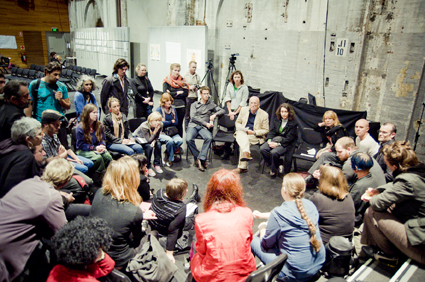
Tipping Point Australia, Sydney
photo Lucy Parakhina
Tipping Point Australia, Sydney
THE SALIENT MESSAGE FROM TIPPING POINT AT PERFORMANCE SPACE WAS THAT THE JOB OF SCIENTISTS ON CLIMATE CHANGE IS LARGELY DONE. THEY HAVE PROVED BEYOND REASONABLE DOUBT THE SCIENCE BEHIND GLOBAL WARMING—WHAT REMAINS IS TO GALVANISE PEOPLE TO DO SOMETHING ABOUT IT.
Tipping Point was formed in the UK by Peter Gingold to create a network of environmentalists, scientists and artists committed to achieving this aim. Gingold explained that he was moved into action after renowned environmental journalist, and founder of 350.org, Bill McKibben bemoaned the lack of cultural material on climate change: “where are the books? The plays? The goddamn operas?” Tipping Point aims to fill this gap with a variety of creative works that inspire us to change the impact human society is having on the earth.
Tipping Point has taken its own message for change seriously—its conferences were regionalised (Sydney, Melbourne, Brisbane) to avoid large numbers of people expanding their carbon footprint by traveling to one central event. Some sessions were held with natural lighting to avoid burning up electricity and some invited speakers spoke via Skype rather than make the resource-costly trip in person. Concurrent with the idea that the facts are largely self-evident and the key change that needs to happen is our willingness to act, the conference was structured like an extended coffee break; the majority of time given over to open space, informal meetings and small group discussions.
The two days began with an icebreaker game—all participants formed two circles and moved along introducing themselves to each other. While it would have been impossible to allow the 100 or so people to actually introduce themselves this exercise gave the impression that this should and would continue to happen over the ensuing two days (and in large part it did). In my part of the circle was Steve Pekar, one of the few keynote speakers flown from overseas to address the conference in the next session.
Pekar is a Geology Professor at Queens College and has been investigating past climate and oceanographic changes during times (45-16 million years ago) when CO2 was as high as predicted for this century (500-1000 ppm). His frustration over the lack of action on climate change burned with the focused intensity only possible in someone who spends their entire life researching its potential consequences. His speech was full of familiar yet terrifying statistics as he rolled out maps of the “hot plate” our earth is to become if we continue to emit carbon at current levels.
After the first presentations we moved into a room with four signs pinned to the wall; “Legislation and Compulsion”; “Fear and Aversion”; “Incentive and Rewards”; and “Vision and Inspiration.” We were asked to choose which we felt would be the most motivating to stop human induced climate change. The crowd spread unevenly with the largest group forming in the “Vision and Inspiration” corner and the smallest in “Fear and Aversion.” This activity had the desired effect of highlighting the importance of artists in bringing change. While not armed with all the facts Pekar had at his fingertips, we were hopefully qualified in “vision and inspiration.”
The rest of the conference was mainly spent in “open space” sessions. Despite the loose title given to these, they were in fact highly structured around a set of axioms: “whoever turns up is the right group,” “whenever it starts is the right time,” “whatever happens is the only thing that could have.” People were encouraged to be “bumblebees and butterflies,” bumping noisily into conversations or drifting around the room looking for something interesting to talk about.
Having spent most of the last decade in various environmental and social justice conferences that got bogged down in intense and sometimes pointless fights between competing left factions I can see the appeal of such a structure. It was nice to be free to drift, to listen when you wanted to, to interrupt whenever you felt like it, to avoid any attempts at domination by any group or individual.
However the discussions sometimes lacked a certain depth. Encouraged to be “mobile” people wafted away from discussions that sometimes needed commitment to bear fruit. Perhaps I was too schooled in my left training; I stayed in my group until the end and it was only starting to get interesting when the session was politely, but firmly, closed for the next to start.
While I enjoyed the open sessions I felt they were, on the one hand, a little too de-centred and, on the other, not quite de-centred enough.
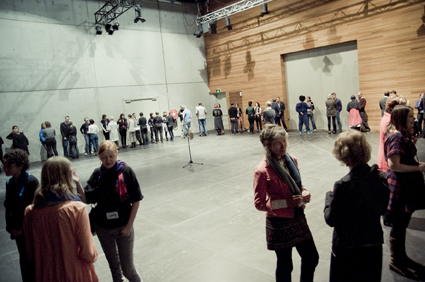
Tipping Point Australia, Sydney
photo Lucy Parakhina
Tipping Point Australia, Sydney
The conference organisers encouraged a specific culture of discussion that facilitated positivity and openness yet discouraged disagreement and the difficult, time consuming yet potentially rewarding, struggle to find common ground.
Whatever the structure of conferences, people inspired by each other will usually find time to meet and talk. Deliberately creating time for this to happen within the conference planning is definitely a worthwhile shift in how we talk about politics.
Whether we write operas, books or plays about climate change as a result might not be the right premise for Tipping Point. Jean Luc Godard once commented that he didn’t want to make political films—but to make films politically. While everyone who attended Tipping Point might not make a work directly on the topic of climate change (although I hope many do) I think all of us will think a bit harder about the ways we make our works and how this could become more sustainable.
I would like to see the discussions begun at Tipping Point continue and deepen to foster an active network for artists, arts organisations and scientists planning how we can reduce our own carbon footprints whilst also contributing to a campaign for genuine political action against the companies and decision makers who make our carbon feet look like twinkle toes. We might not have that much time left before “vision and inspiration” give way to “fear and aversion.”
Tipping Point Australia, producer Angharad Wynne-Jones, Tipping Point UK directors Angela McSherry, Peter Gingold, Performance Space, Nov 5-6; http://tippingpointaustralia.com
RealTime issue #100 Dec-Jan 2010 pg. 14
© Zanny Begg; for permission to reproduce apply to realtime@realtimearts.net
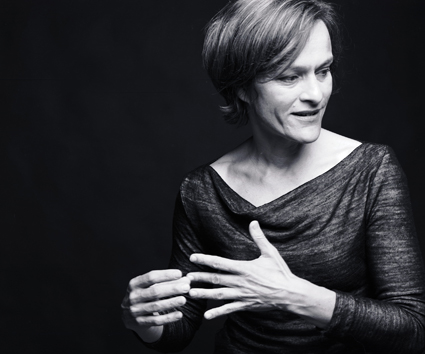
Madeline Ritter
photo Bettina Stöss
Madeline Ritter
FROM THE EARLY 1990S MADELINE RITTER, A TRAINED LAWYER, HAD BEEN AN INDEPENDENT DANCE PRODUCER AND PRESENTER IN GERMANY WITH A STRONG INTEREST IN EXPERIMENTAL DANCE FILM AND VIDEO AND DANCE INCORPORATING NEW TECHNOLOGIES. SHE INITIATED LABORATORIES, NETWORKS AND FESTIVALS, CURATED DANCE PROGRAMS AND SAT ON JUDGING PANELS IN EUROPE AND THE UK. AS A FUNDER, SHE NOW WORKS ON THE STRUCTURES FROM WHICH ARTISTIC PRODUCTION CAN EVOLVE.
Ritter has been the director of the five-year Tanzplan Deutschland (Dance Plan Germany) which, although completed in 2010, has left significant legacies for German dance, yielded new ventures and been imitated in many other countries. I met Ritter when she recently accepted an invitation from Ausdance to visit Australia.
The aim of the Tanzplan project from 2005 to 2010 was to act as “a catalyst for the German dance scene…to provide dance in Germany with more recognition and establish it as an art form of equal value along with opera and theatre in the public perception and in the perception of those responsible for cultural policy” (www.tanzplan-deutschland.de). Tanzplan, Ritter explained, was initiated by Germany’s Federal Cultural Foundation. She describes the foundation as “very unusual, a new organisation with an annual budget of €35million and an artistic director—something totally new for a funding body—with an artistic policy. The artistic director Hortensia Völckers had been the director of the Dance Festival München and an independent art curator.
“To put it simply, there are two strands to the foundation. One is very well defined; people can apply for funds and there are juries and so on. Then there is a significant part of the budget which is totally free— an amount that is not set and the Federal Cultural Foundation can decide itself what to do with the money it allocates. The foundation looked at the state of art in society and the first thing it did when it started in 2002 was to take up different themes like shrinking cities, migration or the future of work. It allocated several million euros, talked to people and secured art organisation partners to do very practical, hands-on things—praxis as research—in a very sophisticated way.”
Ritter explained that an initial focus on dance allowed for the emergence of Tanzplan Deutschland with a budget of €12.5m over five years. “The community was asked what the deficits in dance were and what could be done if a lot of money was given to an organisation. Two deficits were indicated: limited professional education and a lack of awareness, visibility and understanding of dance in society. First it was thought that we needed to do the biggest dance festival of all—a national festival for people to really see what dance is. Twelve curators were asked to present ideas—I was one of them. I looked at the deficits and I thought a festival wouldn’t solve them. A festival has to have an independent artistic spirit, and if you impose a cultural policy agenda it won’t fit.”
Ritter instead addressed other problems: “As an independent producer I had been frustrated with the way funding bodies looked at or were communicating with artists, producers and organisations. These were the ones doing the work, not as people needing funding, but as those who can really define the city, who are partners in developing what culture means in the city. How could we bring these two sides together, on equal footing? So the backbone of the Tanzplan strategic plan came from my experience as an independent producer and a lawyer who is used to looking at points of contention.”
Consultation ensued and became a constant in Tanzplan’s operations. “We travelled, invited politicians and artists to meet us in cities where there were professional dance scenes and institutions and we said, ‘We’re willing to invest €1.2m in your city if you have a great idea, a vision of what would really help dance in your area.’ We asked them to be very specific and to work together. In the end nine cities were selected for Tanzplan Local, “including the big ones from Berlin to Frankfurt but also middle-scale cities like Potsdam and Bremen.” All projects had to “be based on an existing, active dance scene, had to forge alliances with regional and community cultural administrators and local partners, have obtained 50% co-funding from their city or state authority, or from foundations or sponsors…[and] provide points of contact between classical and modern dance, theory and practice, the ordinary public and professionals, open up dance to a new audience and communicate its activities [and] continue to function sustainably after the end of the project” (www.tanzplan-deutschland.de). Ritter says that with the completion of Tanzplan Local “most of the projects have received local and regional funding to go on without our help.
“Over 450 dance institutions collaborated over the five-year period, nearly 900 dance works were produced and thousands of young people participated in the educational projects. These ranged from the creation of a unique space in Hamburg for a new choreographic centre, K3 at the Kampnagel arts venue, to a touring program for state-run and independent companies in northern Germany and the establishment of well-equipped residencies in several of the Tanzplan cities. In Düsseldorf, tanzhaus nrw collaborated with more than 20 local institutions to involve in and infect with dance as many kids and teenagers as possible. In Essen, PACT Zollverein creatively nurtured thinking about dance and in Dresden Semper Opera, Palucca School and Centre for European Arts Hellerau joined forces to support young professionals. Dance congresses in 2006 and 2009, an international co-production fund and Tanzplan’s comprehensive educational initiatives added to the assault from all sides. Through matched funding the original budget of €12.5 m was raised to €21m.”
Ritter regards ample time and independence as the essence of the success of Tanzplan: “There was a gestation period of over five years, each city had plenty of time for their project and was totally free—it could change direction when something wasn’t working. What I really learned was communication. We used mediators and external consultants to work on really concrete problems, how to bring people together to dialogue. A tough one in the education program was the challenge of bringing together the heads of all the dance universities, all 11 of them to talk to each other and work together. It took my colleague Ingo Diehl one year of preparation before we got them together for the first meeting. On the matter of archiving we invited an Australian, Michelle Potter to advise us; we were inspired by the way Australia brought together the National Library and the National Film and Sound Archive to create the Dance Collection. This was a good way to beat resistance to the sharing of archives.” There is now an Association of German Dance Archives.
The Education Program has been an important aspect of Tanzplan: “Now we have a dance biennale for students, the next generation of professionals: they meet every two years with funding which in the future will be secured from the Minister of Education. Our goal is to enhance not just awareness of but knowledge about dance—of what’s happening in dance in the world, the praxis.”
Another major project in education has been the establishment of the Inter-University Center for Dance Berlin (HZT) which started out as a pilot project of Tanzplan Berlin in 2006 and is now administered by the University of the Arts Berlin and the School for Dramatic Arts in cooperation with the Network TanzRaumBerlin. Ritter says that the centre “developed from the independent dance scene and its needs. Anyone can apply to do the bachelor degree—a gardener say, because it’s not about bringing everyone on stage and making them beautiful dancers but giving them a profound knowledge of dance which they might later use for anything they do.” Ritter laughs: “A little problem: the gardener wanted to dance on stage!” The university’s BA and MA programs “offer a reflective and experimental approach to study and combine practice-led artistic and theoretical teaching, as well as practical career guidance” (www.udk-berlin.de/sites/tanz/content/index_eng.html).
Another Tanzplan legacy is Dance Techniques 2010, a publication in book form, DVD and website, available in English (ISBN 978-3-89487-689-0). It is the outcome “of a three-year research project on contemporary dance techniques in which renowned dance institutions in Germany and Europe were invited to take part. Its goal is to provide comparative insight into the various transmission models of dance technique and to make practical and theoretical knowledge applicable” (www.tanzplan-deutschland.de).
Madeline Ritter is now working on another Federal Cultural Foundation initiative, a four-year funding project on the heritage of dance and on the partnering of schools and dance organisations. “I will be working on this with a colleague with all the knowledge we acquired from Tanzplan. Other things we are doing include setting up a national dance office because we feel a communicator-moderator is needed, and also creating a Digital Dance Atlas with the Academy of the Arts, Berlin, to be launched in 2011.” The Atlas “offers viewing of full-length dance works and access to treatises covering many aspects of dance, and the history of dance since 1900, with a particular focus on Germany. An additional area has been set aside for documentation and thematic dossiers” (www.tanzplan-deutschland.de). Ritter adds, “We’re also looking at what other countries are doing. We feel a real affinity with Ausdance, which is so connected to the needs in dance and the people in the field.”
Beyond her latest plans, Madeleine Ritter feels that art in Germany has to deal with too much established infrastructure: “I would like to infiltrate the state theatre system and its 62 dance companies, open them up and bring the outside world in.”
Madeline Ritter visited Australia at the invitation of Ausdance National, assisted by the Goethe-Institut, the Australia Council and Tasdance.
RealTime issue #100 Dec-Jan 2010 pg. 24
© Keith Gallasch; for permission to reproduce apply to realtime@realtimearts.net
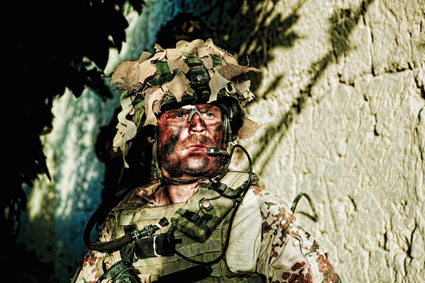
Armadillo
“YOU HERE FOR THE FILM FESTIVAL TOO?” THE IMMIGRATION OFFICIAL ASKED WEARILY. WITH OVER 300 FEATURES SCREENING IN 10 DAYS, TORONTO HAS NOW OVERTAKEN VENICE AS THE MAIN FESTIVAL IN THE SECOND HALF OF THE YEAR. IT’S IMPOSSIBLE TO SEE EVERYTHING BUT, BY CONCENTRATING ON CERTAIN STRANDS, YOU INEVITABLY CARVE OUT YOUR OWN FESTIVAL. THIS YEAR, MINE INVOLVED THE DOCUMENTARIES THAT SHOWED FILMMAKERS PUSHING NON-FICTION FORMS IN NEW DIRECTIONS.
Just as new lightweight technologies spurred the reinvention of documentary forms in the late 1950s, digital technologies have made documentaries easier to shoot, but more importantly, easier to market through a more diverse range of distribution platforms including more television outlets which concentrate on non-fiction, and the burgeoning film festival circuit. Cannes, Toronto and the festivals that feed off them, now serve as launching pads as important as the specialised doco festivals.
patricio guzmán, nostalgia for the light
Patricio Guzmán’s Nostalgia for the Light was cast in the light of a personal essay which begins from the director’s desire to recover a lost past—a sense of belonging to his country Chile in the period before Pinochet. He approaches this indirectly through his focus on two groups, both of which seek clues to understanding the past, working in the Atacama Desert. The dry atmosphere makes this an ideal place for astronomers who look back across immense stretches of time with their telescopes. The second group are archaeologists whose interest in the past is all too immediate by comparison. They join relatives searching for the burial sites of those disappeared by the military during the junta years.
Guzmán’s film is indignant yet fiercely intelligent, movingly beautiful but unyielding in the understated way it countenances the horrors of Chile’s recent history. The two sciences study the universe in extremes of wide shot and close up. The role of the artist is to synthesise the two. As its unlikely comparisons emerge, they are startlingly obvious. Patterns of calcium can be found in the traces of stars and moons, just as surely as in the bones of the dead. When you wonder whether there is anything to be added to the sorry history of the Chilean junta, someone puts it into a larger pattern that finds a powerfully new way to suggest how everything is connected.
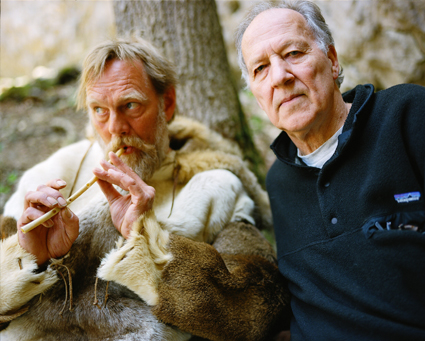
Cave of Forgotten Dreams
werner herzog, cave of forgotten dreams
Archaeology is similarly the focus of Werner Herzog’s 3D film Cave of Forgotten Dreams, which continues his project of re-describing science within the terms of Romanticism. The Chauvet Caves in southern France contain paintings that date back over 30,000 years. Herzog has a long-standing interest in the physicality of cinema and his adoption of 3D technology here is meant to underscore the way that these wonderfully detailed cave paintings are constructed around the contours of the rock.
Herzog’s interest is the origins of homo spiritualis—beings with a consciousness of having a soul. His career has focused on seeking out the limits of human experience where the outlines of this soul can be grasped most clearly. Here the limit is not a geographical one, as in Encounters at the End of the World, but rather one that is at the start of human time.
In contrast to Guzmán’s interest in the past, Herzog’s interest in archaeology lies in its capacity to provide us with the materials to think ourselves into the position of others. The postscript of the film, which employs the metaphor of albino crocodiles (nothing can be everyday in Herzog’s world) reaching out towards their own refracted reflections, acknowledges that the quest is an impossible one, that all we have to grasp at are representations.
errol morris, tabloid
Errol Morris is another filmmaker whose documentaries foreground the limitations on what documentary can tell us. He makes no pretence at being able to capture the truth. All we can know is what can be assembled from competing stories and the way we can connect these to a stock repertoire of images. His latest film Tabloid is the bizarre story of Joyce McKinney and her moment of fame in the late 1970s when she was charged with kidnapping a Mormon in England and holding him as a sex slave. Joyce’s life has been one lived in the thrall of larger fantasies: gods, dogs and finally the self-conscious drama of her own life.
Morris reconstructs the mosaic of stories put forth by McKinney and other surviving participants, particularly the British tabloid reporters who have certainly never been held back by onerous notions of truth. He frequently interpolates graphics and clips from old movies and TV shows, and uses a wash of abstract music as a distancing effect. These are fairly familiar tactics for Morris, though the sensationalised story of McKinney doesn’t provide the type of rich contrast of more serious stories (The Thin Blue Line) or political memoirs (The Fog of War). At his best, Morris works to abstract and defamiliarise the documentary form and make us question the way we arrive at judgements concerning the truth. On more lightweight material, his style seems merely clever.
janus metz, armadillo
It is a commonplace these days to question the distinction between fiction and documentary. Janus Metz’s Armadillo is a documentary which edges its way towards a realist fiction such as The Hurt Locker in its exploration of the adrenalin rush of contemporary war. We follow a team of Danish soldiers through a tour of duty in Afghanistan with intertitles counting down the remaining months in a device similar to Kathryn Bigelow’s film. There are plenty of other devices familiar from fiction films: slow motion, extensive use of non-diegetic music, montage sequences, gradation filters. The assumption is that you need to augment phenomenal reality if you want to arrive at the truth of a moment.
And the truth at which Metz arrives is pretty unvarnished. These soldiers are neither mythicised heroes nor vulnerable innocents. They are a bunch of blokey types sent to do the wrong job. Their training is in shooting people, and while they are keen to do some of that, the bulk of their task turns out to be talking with the locals, fielding the complaints of farmers whose fields are trampled, whose animals are killed and whose families are caught in the crossfire.
Armadillo (the code name of the Danish base) provides a genuinely fresh and immediate perspective on the war in Afghanistan by showing that the war isn’t something that happens only to our soldiers. It happens to Afghanis and the glimpses we see of their commonsensical scepticism about the western military speak volumes about the futility of our engagement there.
jørgen leth, erotic man
Last, and certainly least, we come to Jørgen Leth’s essayistic documentary, Erotic Man. Leth (who you might remember from Lars von Trier’s The Five Obstructions) travels around Latin America making this film and screwing women. The two are closely related. He thinks he is making the film as an anthropological examination of erotic attraction, but it seems more likely that it’s a way for him to get laid. He pursues eroticism with such ponderous self-absorption that is hard to care either way. Leth has become one of those bores who endlessly contemplates the type of film he is making. He claims to have a deep love for women but, of course, it is a love only for the very limited ideas about women he imposes on a bunch of aspiring actresses unwise enough to become the objects of his camera/dick. And here we have it: Jørgen Leth has become the caricature of the cinema that a lot of bad theory in the 1970s saw as its totality.
35th Toronto International Film Festival, Toronto, Canada, Sept 10-19, http://tiff.net/thefestival
RealTime issue #100 Dec-Jan 2010 pg. 16
© Mike Walsh; for permission to reproduce apply to realtime@realtimearts.net

Karen Pearlman
photo Kyle Powderly © Physical TV
Karen Pearlman
“IF EDITORS CANNOT ARTICULATE WHAT MAKES EDITS, EVEN ‘INVISIBLE’ ONES, GOOD, THEN THE JOB OF EDITING MIGHT AS WELL BE DONE BY SOMEONE CHEAPER, FOR EXAMPLE THE DIRECTOR’S BROTHER WHO IS GOOD WITH COMPUTERS.” KAREN PEARLMAN
There are some great books on editing. There is The Conversations: Walter Murch and the Art of Editing, in which Michael Ondaatje interviews the smart and passionate Murch on his work as a film and sound editor. There is director Edward Dmytrk’s On Film Editing where he discusses the essential craft and practice of editing from a filmmaker’s point of view. There is also Sam Rohdie’s Montage and Jacques Aumont’s Montage Eisenstein, which are poetic studies of the aesthetics of editing in the work of filmmakers as diverse as Renoir, Antonioni, Kitano, Fuller, Rivette, Resnais and Eisenstein. So what could a new book on editing offer? Well, actually, quite a lot.
Cutting Rhythms: Shaping the Film Edit is an insightful new book written by Dr Karen Pearlman who is Head of Screen Studies at the Australian Film Television and Radio School, co-director of the Physical TV company, a professional film editor, dancer, choreographer and lecturer. Pearlman combines her knowledge, skills and experience from her different creative and educational practices in this book. In fact, it is her work as a dancer and how it informs her thinking about editing that makes this book such an original and refreshing contribution to the literature.
Pearlman tells us that one of the first things that motivated the book was the mysticism and vagueness that surrounds the way so many editors talk about their craft. She cites editors who have described their approach to editing as “magic” (Sheldon Kahn), as something that “feels right” (Carl Kress) and something that is “exclusively in the realm of intuition” (Merle Worth). The repetition of these responses led Pearlman to the central questions of her book such as, “How is this intuition developed or acquired and how is it actually working in the process of editing rhythms?” The book, based on her PhD dissertation, goes a long way towards answering these questions.
In the first section Pearlman unpacks and demystifies several key concepts as well as discussing her own particular approach. She begins with a fascinating discussion of the mysterious notion of intuition, making good use of Guy Claxton’s work in The Intuitive Practitioner. Claxton proposes that intuition consists of six types of thinking: expertise, implicit learning, judgment, sensitivity, creativity and rumination. Pearlman uses these ideas to try to understand intuition, arguing that it is, in fact, something that can be learned and developed through “practical and theoretical experience and education.” She brings together the poetic observations of the filmmaker Tarkovsky with the work of neurologists and physiologists to establish a foundation for “rhythmic intuition” that is based on the knowledge of the human body. In the case of the editor, she says that intuition can and should come from knowledge of the world, knowledge of the editor’s own body and knowledge of the cinema and its actors. She suggests that editors need to sensitise themselves to these different kinds of knowledge and bring this to their practice.
The central concept of rhythm is something that Pearlman goes on to explore at length, examining the many ways in which rhythm can be shaped, and what its function and role in our experience of the cinema might be. For Pearlman, editing is the art of shaping movement, and movement is the material that the editor works with to create rhythm. This art of shaping movement is something that she has developed in her work as a choreographer and dancer. She describes choreography as “the art of manipulating movement: phrasing its time, space, and energy into affective forms and structures.” She links this in compelling ways to editing which she argues is also a form of choreography, and suggests that “dance and dance-making processes might provide craft and inspiration for editing.” The connections between choreography and editing as arts that both manipulate movement lead Pearlman to some surprising techniques.
In the second section of the book Pearlman provides an extended examination of different kinds of movement and rhythm and discusses how they work in the process of editing. Each chapter involves an account of key concepts like physical, emotional and event rhythms that are then followed by case studies as well as activities to illustrate and demonstrate these concepts. There are instructive case studies of films as diverse as The Godfather (1972), Goodfellas (1990), The Great Train Robbery (1904), Snatch (2000), Requiem for a Dream (2000) and Gone with the Wind (1939), to list just a few. Pearlman writes about films as a practitioner with a passion for understanding the way that images work together to move and engage an audience. Her analysis takes us beyond narrative and characters to energy and movement and the experience of movement and rhythm.
Possibly the most interesting case study in the book is the one in which Pearlman examines the final dance scene of Thursday’s Fictions (2007), a film made by her own production company and which she also edited. The Physical TV Company productions are stories told by the body, and there are parts of the film where the entire story is “carried by the physical.” She explains that her job as an editor was “to re-create not the precise choreography, but the feeling of the choreography.” Pearlman defines the processes she uses to “shape the physical rhythm” of a scene in terms such as “re-choreographing,” “physical storytelling,” “dancing edits” and “singing the rhythm.” She then demonstrates and elaborates on them through close analysis of a scene from the film.
This is a very readable book, written in an accessible style that should appeal to a broad cross-section, including editors, teachers of editing and film enthusiasts.
For those who might be interested in looking further at how Karen Pearlman has put her own theories into practice, she has recently edited Jeni Thornley’s marvellous documentary Island Home Country (2009, available on DVD), which is definitely worth chasing up.
Karen Pearlman, Cutting Rhythms: Shaping the Film Edit, Focal Press, Burlington US, Oxford UK, 2009
RealTime issue #100 Dec-Jan 2010 pg. 17
© Anna Dzenis; for permission to reproduce apply to realtime@realtimearts.net
ARS ELECTRONICA 2010 TOOK PLACE IN THE BREATHTAKINGLY CAVERNOUS TABAKFABRIK IN LINZ. THE 160 YEAR OLD PROCESSING PLANT ONLY CEASED PRODUCTION IN 2009, SO THE DUSKY, DAMP SMELL OF TOBACCO WAS STILL IN THE AIR. IN WHAT WAS BOTH A CONCEPTUAL EXPLORATION OF ‘FESTIVAL AS FACTORY’ BUT ALSO AN ATTEMPT TO FILL SUCH A LARGE VENUE, THE MASSIVE PROGRAM OFFERED A MULTIPLICITY OF RESPONSES TO THE THEME OF ‘REPAIR,’ SOME PERHAPS IN DIRECT OPPOSITION TO EACH OTHER, AND MANY DECIDELY ANTI-ELECTRONIC. WITH SO MUCH ON OFFER, I CHOSE TO LISTEN TO THE FESTIVAL FACTORY’S WORKINGS.
winning works
The centre of the festival is the Prix Ars and this year’s Digital Music & Sound Arts category yielded several excellent works. My personal favourite was the kinetic sound sculpture Cycloïd-E by Cod.act (Swiss brothers Michel and André Décosterd) which received an award of distinction. The work comprises five pieces of piping attached at the ends in a way that allows them all to swivel 360-degrees. The base pipe is attached to a motor that causes it to rotate, in turn causing the four other sections to spin on their own axes, resulting in endlessly changing articulations. Within each pipe is a small speaker and oscillator, so the haunting hollow chords doppler as the sculpture dances. For all its complex engineering, Cycloïd-E appears elegantly simple and is totally mesmerising.
Surprisingly, this is the first time that Sound Art has been included specifically in the Prix Digital Musics Category. As we head into the second decade of the 21st century, perhaps this reflects a new ambivalence towards technical wizardry for its own sake and a stronger appreciation of aesthetics. The fact that Canadian artist Martin Bédard’s piece, Champs de Fouilles (Excavations), received an award of distinction certainly exemplifies this. A purely audio experience conceived for speaker orchestra and made from field recordings of excavations around Quebec, Bédard’s piece has direct lineage to the musique concrète and acousmatic schools and is a rich and dramatic exploration of texture and structure. Unfortunately the work suffered from being exhibited in a stairwell, a place of transit rather than contemplation, and was accompanied by the constant thwumping of heavy doors leading to exhibition floors. While Bédard was good-humoured about the situation, it’s unfortunate that a festival so actively engaged in sound culture is still struggling with these elemental issues around the presentation of sound works.
Japanese artist Ryoichi Kurokawa was awarded the Golden Nica for his audiovisual creation rheo: 5 horizons, which fared much better in its presentation context. The installation consisted of five channel audio and vision exploring the flow of exquisitely barren landscapes intertwined with precise digital draftsmanship and was housed in its own half of a warehouse space. However it was in concert form that this work truly came to life with the sense of connection between organic, digital, audio and visual elements combining in an indivisible union that was simultaneously grand and meditative.
Perhaps one of the most remarkable sound performances in the festival took place as part of the Frozen Music opening night events. Japanese artist Ei Wada’s Braun Tube Jazz Band is a wonderful exploration of human-machine interaction. Gathering a bank of old cathode ray television sets, he sonifies the electromagnetic radiation and plays the whole installation like a giant drum machine. The sets are highly responsive to micro and macro gesture as Ei Wada taps, swipes and pinches the hum and drone into complex beats and melodies equally at home in a gallery or on a dance floor.
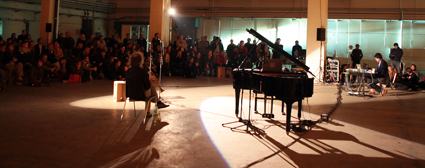
Rupert Huber, Franz Hautzinger, Sound Space, Ars Electronica 2010
photo rubra
Rupert Huber, Franz Hautzinger, Sound Space, Ars Electronica 2010
sounding spaces
An impressive aspect of the festival was the focus on the sonic potential of the Tabakfabrik complex itself. A massive empty warehouse with a natural 12-second reverb was named The Sound Space and programmed with three modes of presentation. Part of the day it was used to channel back sounds from around the site for treatment by the space itself; it was also the place for a range of workshops; and finally it was a performance venue. In reality I’m not sure the space was ever still enough to experience the first mode, blending frequently into the workshop situations. The performances offered a tighter focus, a range of approaches from the vocal play of AGF and the gentle piano mediations of Rupert Huber to the mass improvisation under the guidance of Marco Palewicz. While I’m not sure that all of the performers were consciously exploring its acoustic properties, the space certainly imprinted itself on performers and audience alike: huddled in the centre, dwarfed by its vastness, one felt a kind of humility, according almost a sense of sacredness to these performances.
The Long Concert was a roving event that explored almost the entire Tabakfabrik and, given it was in collaboration with the Brückner Orchestra, featured for the most part a contemporary classical repertoire. Starting off in the long galleries of Bau 1, Karleinz Stockhausen’s Gesang der Jünglige could have been amazing if it had been presented on the multi-speaker system for which it was composed, or at the very least on something more than the two very small speakers placed in the ceiling. The large crowd had been supplied with cardboard stools requiring origami-like construction, so the entire presentation was accompanied by the shuffling of the arriving audience and their cardboard manipulations. Positioned further down the space, Arvo Pärt’s piano works fared marginally better, as the audience began to settle and let Pärt’s profound simplicity float in the dusky light. Pärt’s music was the focus of the program, with a seated orchestral concert in the main hall and an epilogue of his Fratres pieces in the belly of the Magazin building. Not so adaptable to ambulatory placement, the contemporary classical repertoire was best served by the concert hall setting, but nonetheless produced an intriguing experience that drew in a large local crowd keen to explore the Tabakfabrik.
hearing the hum
A real highlight was the inclusion of Christina Kubisch (Germany) as a featured artist (and juror of the Digital Music & Sound Art Category). Kubisch has developed her practice around electromagnetic reception and transmission. Some of her past works have involved creating content to be received by her specially modified headphones within site specific installations (RT60), but lately she has concentrated on the pure reception of the electromagnetic hum of the world around us. Also exhibited was a recent series of works undertaken in the densely populated Ruhr area of Germany where Kubisch has recorded the electromagnetic hum of transport systems and public spaces. The centre piece is Bewegungen nach entfernten Orten (Movements to Distant Places), a six channel sound installation in which the recordings are composed into a stunning soundcape of shifting waves and overlapping fields of elemental vibration. In another installation, Ruhrlandschaften 2010, Kubisch places 40 numbered photographs on the wall and the visitor, armed with a standard gallery audio guide, can punch in the number to hear the sound of the various locations. This work highlights the surprising range and subtlety in the hum of objects around us: the deep earthy thrum of high tension wires; the staccato beats of a fluorescent sign; the high-pitched whine of a public telephone.
In addition, Kubsich offered walking tours so we might directly experience these energy fields. Having picked up a pair of her special headphones in the city centre, you could follow a designated route of traffic lights, street signs, overhead wires and security gates, or you could wander on your own sonic adventure. You could also go on a tour with Kubisch herself around the Tabakfabrik; this was particularly engaging because she had access to closed off areas such as the power plant. Initially Kubisch was disappointed, as most of the electrical infrastructure had been removed when the factory closed down; however what emerged in its place was perhaps even more interesting. Many of the festival artworks had their own electromagnetic signatures, so Kubisch opened up the possibility of an alternate way of experiencing Ars Electronica—a completely sonic Ars Electronica. Works such as Matthew Gardiner’s Oribotics (origami robots) or Jacob Sikker Remin’s KUBEN made from fluorescent lights, the flat screen monitors of Ryoichi Kurokawa’s rheo: 5, or the numerous video projectors took on whole new aural aspects. This accidental discovery was gently subversive, and a wonderful way to explore the exhibitions.
What Christina Kubisch’s Tabakfabrik intervention highlighted was the many ways to explore and access Ars Electronica 2010. You could experience the elite of media art; marvel at what corporate money can achieve with Honda’s robot ASIMO on display at the Ars Electronica Centre; talk code with the open source community; get your hands dirty repairing furniture in the workshop; or ‘repair’ yourself through self-help workshops. Like the many departments of a manufacturing plant, each area had a different agenda and often a different audience, but working together they brought into meaningful and joyously sonorous production the curators’ vision of the ‘festival as factory.’
Ars Electronica 2010: Repair; Tabakfabrik, Linz, Austria, Sept 2-11
RealTime issue #100 Dec-Jan 2010 pg. 18
© Gail Priest; for permission to reproduce apply to realtime@realtimearts.net
{$slideshow} THE OPENING PARTY OF THE LIVERPOOL BIENNIAL RESOUNDED THROUGHOUT THE MASSIVE VOIDS OF THE OLD STANLEY DOCKS—ONCE AN ENGINE OF EMPIRE (AND STILL THE LARGEST BRICK STRUCTURE IN THE WORLD) PUMPING THE ECONOMY OF A CITY THAT, IN ITS HEYDAY, HANDLED 40% OF WORLD MARITIME TRADE. SITUATED JUST TOO FAR EAST ALONG THE DOCKS ROAD TO BE RE-DEVELOPED, THIS GOTHIC LEVIATHAN RECALLS THE LIVERPOOL OF MY UNDERGRADUATE DAYS, A CITY OF FOREBODING POST-INDUSTRIAL LANDSCAPES, BOMB-RUINED WHARVES, DANK COBBLED STREETS, BOND STORE CELLARS WITH SLAVING RINGS STILL INTACT—THE WELLSPRING OF MY DREAMS FOR YEARS TO COME.
The sun has long ago set on the Empire; Blair’s Cool Britannia has likewise sunk beneath the waves, thankfully carrying with it the YBAs [Young British Artists] who now look like the corporate advertising stunt they always were. The Royal Navy may not even be able to afford its four new Trident submarines in what promises to be an economic bloodbath. Only the charity organisations of the Big Society are left to staunch the wounds.
Ironically, the Brits have long recognised the soft power inherent in the arts (cheaper and ultimately more effective than the aforementioned Tridents and their franchised supply of American rockets), so it will be fascinating to watch the two contradictory processes meet head-on over the next year or two. The ever-present and earnest desire in the UK to redefine and renegotiate its social and cultural system along with the stringent restructuring of the economy and governance will create a collision that will prove either toxic or tonic to the arts.
Arts funding in the UK does not shy away from strongly defined policies of social inclusion, cultural cohesion and urban regeneration and has spawned a range of arts organisations (and artists) acutely aware of their social and cultural mission.
Hidden in the old Ropewalks (an area of former rope manufacturing) between the oldest Chinatown in Europe and a massive pedestrian city centre renewal, FACT (Foundation for Art and Creative Technology) is one of those curiously British arts centres that operate in the nexus between social engagement and the avant garde.
This is an arts model recognised in theory but yet to be realised in Australia—a multi-arts production house, replete with cinematheque, cool cafe and bar, underpinned by a savvy, socially engaged curatorial program that asks real questions and delivers tough and inventive exhibitions. In Sydney, imagine the MCA without the pretensions and the snobbish restaurant (or the view), an Artspace with an ambitious commissioning program for national and international art projects, a Performance Space that controlled CarriageWorks, or an ICE (Information & Cultural Exchange) that has cultural prominence. Combine all of these and you would be halfway there!
Carl Jung characterised Liverpool as the City of Dreams; for Ginsberg it was The Pool of Consciousness; and for FACT at this year’s Biennial it was Touched—as by a mother, as by a return to an almost forgotten place (I don’t think anyone used that word ‘affect:’ touched denotes so much more).
As ever, biennales are ashes and diamonds affairs; the FACT exhibition was a small cache of the latter, starting with Life Work a One Year Performance by Taiwanese artist Tehching Hsieh (RT90). Dating from 1980 to 1981, this work records an action in the artist’s studio in which he clocked-on to an industrial workers’ time punch device each and every hour of the year, simultaneously photographing a self-portrait, naturally recording his ever flourishing hairdo. The documentation spooled back in the gallery as a time lapse amidst acres of punch cards and small still images. Of course some silly but pragmatic questions arise: how did he go shopping, socialise or stay sane with this regime? However, this self-imposed house arrest may have been the perfect art production strategy for an ex-pat Taiwanese artist in New York working 30 years before the China Art tidal wave swept the world. Hsieh ‘retired’ around 2000 and his elegant endurance performances have gained the status of legend.
Set against the coolly obsessive program of Hsieh’s serialist work the temperature rises in the video by South Korean Minouk Kim that seems to document a group of protagonists (are they a simple tour group somehow lost in the urban jungle, a detachment of citizen protestors or a cell of determined terrorists?) wandering through the contested Four Rivers Project tourist development site in Korea. We are not going to be told and anyhow this is no documentary as the material is shot in the infra-red spectrum using heat-seeking cameras that add overtones, not only of a surveillance and military targeting, but of a post-Holocaust mise en scène. Ironically the aesthetic of the work transcends its politically caustic potential, rendering it eerily mesmerising with a colour palette that recalls exotic tropical aquaria. Like all mature artwork it leaves the material hovering between significations, the synapse of metaphor active.
As we grow older the sound of our mother’s voice over the telephone, once so central, intimate and enveloping, acquires a tinge of sadness that grows with temporal and physical distance. Japanese Meiro Koizumi’s My Voice Would Reach You (single channel video, 2009) delivers us a man engaged in an unchecked emotional outpouring to his mother, but unfortunately distanced by mobile telephony and the frenetic backdrop of downtown Tokyo. Mother, however, isn’t available and the surrogate is a flustered call centre operator attempting to navigate the torrent of speech. The telephonic fracture is a classic exemplar tracing the fissures and voids created by urbanism and technology, a communication network that only makes sense when we are apart, in a ghostly vis-á-vis.
Queues at exhibitions are not my cup of tea, so I skipped Yves Netzhammer’s Dialogical Abrasion (2010) the first time around but the soundscape intrigued me so much that I joined the line, and it was worth the wait. This new project commissioned by FACT is a compound of three elements beginning with an animated 3D netherworld of crash-test dummy characters populating a De Chirico-like dreamworld, performing wordless rituals and transformations. Developing from this dreamscape is a series of IKEA-gone-wrong sculptural situations serving as the domicile of a crash-test being, plus an intermittent spatial soundscape by the composer Bernd Schurer, alarmingly loud and cross-linked with the gallery lighting to illuminate elements of the installation as if in a thunderstorm, an indoor Donner und Blitz.
The final work in the FACT exhibition falls outside of the scope and modus operandi of the above and was curated by Asher Remy-Toledo of No Longer Empty (p38). Finnish artist Kaarina Kaikkonen worked in the atrium of FACT to create a site-specific installation that conceptually looped back into the central theme of Touched, in that it reprised the maternal labour and care expressed in the mundane chores of family life. Kaikkonen collected second hand clothes from the Liverpool community, laundered them and used the fabric to create a large architectural net, ballooning down over the foyer entrance, a work at once communal and familiar but also carrying individual narratives and memories, a combination close to the heart of FACT.
Touched, 6th Liverpool Biennial: International Festival of Contemporary Art, FACT, Liverpool, UK, Sept 18-Nov 28, www.fact.co.uk
RealTime issue #100 Dec-Jan 2010 pg. 19
© Nigel Helyer; for permission to reproduce apply to realtime@realtimearts.net
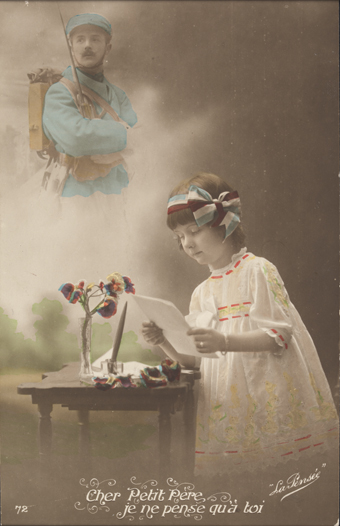
postcard, Dear Father…
courtesy Esther Milne
postcard, Dear Father…
WHEN, IN THE OLDEN DAYS, PEOPLE USED TO WRITE LETTERS TO EACH OTHER, HOW DID THEY IMAGINE THEIR CORRESPONDENTS? TODAY, WHEN WRITTEN COMMUNICATION PROCEEDS VIA EMAIL, SMS, FACEBOOK, TWITTER AND OTHER FORMS, HOW DOES THE WRITER CONVEY A SENSE OF SELF, AND HOW IS IT RECEIVED ON THE OTHER END? THESE ARE THE SOME OF THE QUESTIONS EXAMINED BY ESTHER MILNE IN LETTERS, POSTCARDS, EMAIL, A THOROUGH, SCHOLARLY STUDY OF MEDIA FORMS AS “TECHNOLOGIES OF PRESENCE.”
Central to Milne’s book is the concept of presence; she helpfully offers a working definition of it early in the first chapter: “Presence is an effect achieved in communication…when interlocutors imagine the psychological or, sometimes, physical presence of the other.” The concept is inherently paradoxical, as Milne demonstrates with a degree of skill and subtlety. As she explains, presence “is aligned with the concepts of intimacy and disembodiment,” yet it is achieved via material technologies such as the postal service or email system. The fundamental paradox is that the sense of presence depends on the absence of the other; the “absent body” in correspondence means that “communication partners are not physically present to one another.” Milne is particularly adept at teasing out the implications of this paradox in her historical study of communications from the origins of the postal network to Twitter.
This historical approach is achieved through detailed analyses of a series of correspondences across the centuries. First is a network of British letter writers of the late 18th and early 19th centuries, including a correspondence of over 700 letters between Elizabeth Barrett Browning and Mary Russell Mitford. Milne first surveys the beginning of the British postal service before providing a close account of its mechanisms and the types of communication it made possible. One feature emerging from this epistolary correspondence is a longing for “unmediated converse,” that is, for a transcendent presence of the other without the need for the mediating material form of the letter. Yet at the same time, these letter writers thrive on the absence of their correspondent; these prolific senders of letters rarely meet each other in person. Here again is the “strange paradox indeed” of disembodied presence, which Milne traces throughout her study.
The next stop on the journey is the postcard, originating around 1865. Milne sees this media form as the transitional phase between old-fashioned letter writing and email. Communication on postcards was truncated, written quickly and dispatched; these were messages of the
everyday sent by ordinary people rather than the literary middle class. The messages on postcards were also potentially public, at least to anyone who came across them. Yet Milne demonstrates, through a close reading of 140 cards sent by the Australian soldier William Robert Fuller to his sister from the battlefield of WWI, that intimacy, and hence the presence of the writer, could be conveyed by the postcard. This section of Milne’s historical survey, however, is under-developed in comparison to the studies of the letter and of email.
To this latest stage on the journey, Milne devotes considerable energies. She sketches the origins of the internet, investigating claims of its military origins before settling into an examination of presence in email communication, using the list Cybermind as source of examples. The immaterial nature of digital information adds a further twist to the presence/absence paradox, yet Milne uncovers the persistence of the desire for presence in the digital age. This is the theme of her book: that over a 200 year period, spanning different media technologies and distribution systems, the longing for the presence of the other has endured. Milne counters the idea that the progression from letters to emails entails a new distance and loss of personal warmth, by pointing to the abundant evidence of intimacy in email correspondence. She argues that “despite the potentially disruptive, interactive and theatrical nature of email discussion lists, subjects are able to express feelings of intimacy, warmth and affection for one another.”
The strengths of Milne’s book lie in its supple treatment of complex ideas. She is careful in analysis, aware of the pitfalls of overstated theorising, such as claims for ‘revolution’ in media, or the supercession of old media forms by the new. The historical perspective is enlightening, bringing a depth to the study of communication. Claims for the newness of high volume email communication are placed in perspective, for example, when it is remembered that in 18th century London the mail was delivered up to 12 times a day. Milne’s detailed analysis of correspondences made using letter, postcard and email are a valuable feature of her book.
There are weaknesses, however, mostly derived from the book’s origins as a PhD thesis. These are most apparent in the overly dense referencing of secondary sources and the unnecessarily guarded qualifications (“arguably” is used far too many times when stating a position). Some of the long excursions into media history are tangential to the main argument, so that the book becomes bogged down in peripheral details of the pre-history of email or the speed of mail coaches. These rather fruitless excursions come at the expense of some other considerations, which are strangely absent for much of the book. For example, Milne does not discuss the differences between writing a letter by hand and word-processing an email until near the end of the book, and then only by quoting another theorist. Yet surely handwriting—unique in each case—is a major contributor to the specific sense of presence generated from letter writing.
Similarly, Milne mentions only in passing that emoticons were invented in 1979 in response to the “loss of meaning” in computer-mediated communication—but again she makes nothing of this media-specific development. Part of the difficulty here is the reluctance by many academic media scholars to appear ‘technological determinist’ or media determinist—yet considerations of this type are necessary to some degree in this area of study. At least Milne does not succumb to the spurious ‘metaphysics of presence’ arguments perpetrated by Derrida and his followers, although their influence does obscure her theorising at times. Overall, Milne’s arguments are insightful and persuasive, leading us through a 200-year fascination with presence.
Esther Milne, Letters, Postcards, Email: Technologies of Presence, Routledge, New York, 2010
RealTime issue #100 Dec-Jan 2010 pg. 20
© John Potts; for permission to reproduce apply to realtime@realtimearts.net
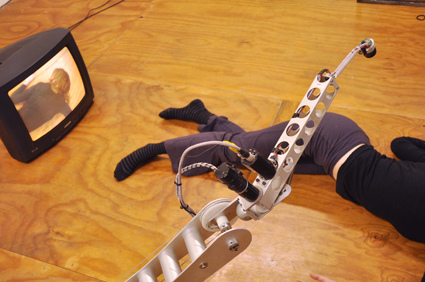
Quartet, Margie Medlin
photo courtesy Critical Path
Quartet, Margie Medlin
ARRIVING EARLY AT THE SEYMOUR CENTRE, I HAD INTENDED TO JOIN IN THE SEAM PRE-CONFERENCE WARM UP SESSION. WITHOUT A YOGA MAT OF MY OWN I BECAME AN OBSERVER AS THE GROUP OF DANCERS MOVED ELEGANTLY THROUGH HARDCORE PRACTICE. HOWEVER, THANKS TO NEURAL MIRRORING I FELT ALMOST AS INVIGORATED AS IF I HAD BEEN PART OF THE ROUTINE MYSELF AND READY TO ENGAGE IN SOME EQUALLY HARDCORE THINKING.
SEAM 2010: Agency and Action—a month- long program of workshops, forums and exhibitions—was co-presented by Critical Path and the University of Western Sydney. As with any transdisciplinary venture, especially one exploring subtle energies, somatic practices, distributed bodies and mediation, a loss in translation between presenters, exhibitors, performers and audiences was inevitable. However the diversity of presentation styles—from storytelling, dance, philosophical musings, autonomous robotic performance, command line interaction and rabbit training—transcended some of the language barriers.
Doris McIlwain and John Sutton opened the event by demonstrating how verbal ‘touch’ influences bodily position, posing questions around embodied cognition, collaborative decision-making and affective experience. Our verbal, conscious and conceptual access to physical and cognitive performances are mysterious realms, full of unconscious couplings and ghost gestures. Researching remembering and forgetting, Kate Stephens is developing tools to ascertain if the contemporary dance audience experience can be enhanced by kinesthetic learning prior to performances—or not. Mike Leggett unravelled temporal perspectives and relocations: the documentation process of his 1970s Unword performance works, with the then absolutely new medium of video, has changed their meanings.
Unexpectedly, Ruth Gibson of igloo (UK) lay down on the stage prior to speaking, illustrating the art of letting go. Trained as a dancer, Gibson facilitated a three-day workshop on the Skinner Releasing Technique for SEAM earlier in October—a process of unlearning and wakening the primal. Gibson and Bruno Martelli, as igloo, create poetic 3D virtual and physical installations grounded by presence, gravity and place. Gibson playfully introduced the concept of ‘hypersurface’—an informed topology that unlocks culturally instituted dualities like the real and the virtual by intertwining them into irresolvable complexities to create a ‘middle out’ perspective.
Sitting with her back to the audience, Nancy Mauro-Flude uncovers—visually opening up—the insides of the operating system behind our daily computer interactions. Through enquiring conversations, the amplified sound of Mauro-Flude’s fingertips dancing across the keyboard beautifully conveyed the poetics and isokinetics of machine and human intelligence. With her dual background as artist and Feldenkrais practitioner, Lyndal Jones spoke eloquently of the centrality of empathy in creative dialogues—setting up visual scenarios where empathy is demonstrated by mirroring, until the notion of self disappears. Jones, like several other presenters, tapped into Eastern philosophical notions of Mindfulness, and conjured up the palpable presence of philosopher Brian Massumi.
In a double identity shift, the silhouette of choreographer and media artist Hellen Sky emerged from backstage lurking, wrapped detective-like in a trench coat to co-present with Garth Paine (UWS). Their dialogue morphed between academic and witty exchange and bio-sensing performance to illustrate elements of the Darker Edge of Night research project. The importance of timing in gesture research was elaborated by keynote speaker Frédéric Bevilacqua, Head of the Realtime Interactive team at IRCAM (France), as he presented outcomes from the SEAM workshop he had facilitated on software tools for motion tracking using optical cameras.
Christian Ziegler (Germany) had also facilitated two intensive SEAM laboratories, developing works with a choreographer and dancers within his “wald-forest” interactive environment during his Critical Path residency. Ziegler was joined at the final public forum and exhibition at Rushcutters Bay over the last weekend in October by Volker Kuchelmeister with Deconstructing Double District, and the outcome of Brad Miller’s research residency, titled augment me.
Forgoing the enacted or observed yoga, I slid straight into the zone on day two with Kathy Cleland discussing the emergence of non-human and quasi-human performers. Cleland examined how mirroring and mimicry were central to building empathy and understanding, exploring the fluid distinctions and similarities between human and robot speed and movement.
When working with robotic performers, one needs to acknowledge their capacity to act up. The machine desire of In Serial embraced chaos and entropy. This multi-talented group—Linda Dement, Petra Gemeinboeck, PRINZGAU/podgorschek and Marion Tränkle—is interested in the uncontrollable fluids and escalating generative interactions between non-human protagonists. The emergence of robotic agency, with defiant robot mops attempting to escape their task of mixing smelly viscous fluids and veering off stage, admirably demonstrated ‘entrainment’—a term used by the team to describe how their behaviour had been brought into coherence by the machine’s determination.
Careering down the expansive rabbit hole of nano-technology, Paul Thomas threw in a heady mix of Bergson, code duality, matter vibration and the primacy of consciousness for good measure. Scott McQuire evoked McLuhan’s extension of man in his discussions of the production of urban public space by networking large screens in Seoul and Melbourne. My synapses were imploding with the implications of immanence, imbrications and irretrievable intertwinings. Luckily Lars Marstaller was undertaking a cognitive ethnographic analysis of the extended SEAM program, to ascertain how the available resources could create meaning and solve problems.
We were re-grounded by Kate Richards’ investigations of affordance, affect and audience interactions with screen-based media in the arts and entertainment industries. Her documentation of a mediated journey into the supernatural realm at Macau’s City of Dreams Casino’s immersive 3D Bubble Theater evoked affective resonance in crowds. Choreographer Vicki Van Hout’s Busy Hands Speaking Country traversed the seam between Indigenous knowledge, dance and painting. Her work on co-location—being in the dreaming and in the dance, creating a virtual spiritual atavistic experience, and replacing the ancestral voice with technology—raised issues of tangibility and transportability of traditional form.
During a symposium break, Margie Medlin’s empathic Quartet robotic dancer provided an engaging spectacle in the foyer in a subtle to violent duet of synchronised flesh and machine. Trapped in a glass cage next to the performers, Stelarc’s Articulated Head bobbed up and down on its mechanical arm. I could not ascertain if its mesmerised movements were akin to being snake-charmed by the adjacent human-robotic action, or if it/he was looking for attention like a fluffy puppy when all eyes were focused elsewhere.
Later, the big head, a virtual Stelarc delivering a Deleuzian keynote in synthetic monotone, appeared almost vulgar after the subtle, considered enquiry and nuanced somatic states of previous sessions. Disappointingly, although autism was mentioned several times, it was not followed through. At a conference about altered agency and embodiment, an engagement with differently wired bodies—bodies with other physicality and cognition—would have augmented the program. The thinking of Erin Manning and others around autist Amanda Baggs’ short video, In My Language, could have brought the intensity of movement and the affective proto-language of gesture and sensation into play.
Picking up on the thread of playfulness and mindfulness, the Thinking Through the Body project, brought together by artist George Khut and curator Lizzie Muller, staged a significant presence. Practitioners drawn from across media forms, programming, sound, sculpture, dance and Feldenkrais spoke with respectful contemplation of their process of internalisation. Unfolding awareness of breath, touch, balance, proprioception and stillness has brought a new depth of consciousness and embodied intelligence to their individual and group practices.
Chunky Move’s Glow (RT78) was also performed during SEAM, with artistic director Gideon Obarzanek speaking of the ongoing choreographic dialogue between dancers and Frieder Weiss’s artificially intelligent lighting and tracking software (RT84). Playing out the tensions between technological rationality and the anxiety of humanity, a dancer appears to be trapped on a scanner bed. Inventive effects and mirror neurons aside, viewing Glow from the low-raked seating at the Seymour Centre compromised the experience. I ached to be up high—looking down into the performance—immersed with the technogenic body, rather than a distant spectator.
SEAM successfully addressed many aspects of agency and embodiment altered by interactive technologies with the inspired placement of performative installations in the foyer—reaching a general audience of curious theatre-goers as well as opening specific dialogues in spatial and cognitive arenas that should be continued. Next year’s conference will focus on architectures—exploring the need to construct spaces that can flexibly accommodate differing modes of performance, technology and audience interaction.
SEAM 2010: Somatic Embodiment, Agency & Mediation in Digital Mediated Environments, Critical Path (Director, Margie Medlin), University of Western Sydney (Dr Garth Paine), Symposium, Oct 15-16; http://seam2010.blogspot.com
RealTime issue #100 Dec-Jan 2010 pg. 21
© Melinda Rackham; for permission to reproduce apply to realtime@realtimearts.net
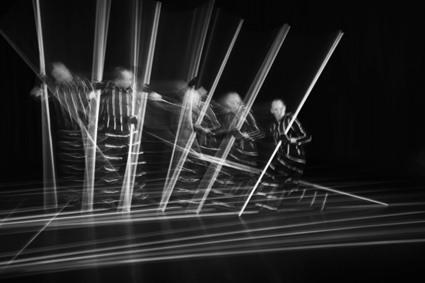
Emmett Hardie, Line Dances, Daniel Belton & Good Company
photo WJS Grenfell
Emmett Hardie, Line Dances, Daniel Belton & Good Company
LINE DANCES IS THE LATEST COLLECTION OF SHORT CINEMATIC WORKS FROM NEW ZEALAND CHOREOGRAPHER AND FILMMAKER DANIEL BELTON. AFTER THEIR LAUNCH IN DUNEDIN, BELTON INTENDS TO TOUR THE PIECES. THEY ARE HOWEVER PRINCIPALLY DESIGNED TO BE VIEWED ONLINE.
Belton’s early training as a painter is again evident in these works. He references many of the visual and thematic concerns of his previous films and multimedia dance pieces (RT92)—lines of perspective and sketched trajectories evoking Renaissance illustration, architectural drawings, as well as influences from Russian Constructivism, Futurism and the delicate, minimalistic version of Modernist painting seen in the work of Paul Klee. Belton indeed cites Klee’s lectures at the Bauhaus School of Art during the 1920s as a key influence.
The Bauhaus is known for promoting the notion of colours possessing specific correspondences to each other and to spiritual sensations. With the exception of a few geometric blocks of red recalling the work of Piet Mondrian and the Constructivists, Belton’s Line Dances, though, are largely black and white.
This suits Belton’s purposes well. It gives Line Dances an antique feel consistent with the broadly Modernist visual iconography, as well as establishing a link between these allusions and earlier Baroque and Rococo architectural settings and theatrical modes. The commedia dell’arte Harlequin—or his representation as a figure of ironic playfulness and visual fantasy in Modernist art by Cocteau, Picasso and others—appears, as does a generic, white-attired Columbine ballerina, along with clockwork, automaton-like figures, angular acrobats (looking as if they have stepped out of Meyerhold’s productions) and line drawings of fantastic spaces and buildings with indeterminate, shifting dimensions (shades of Klee’s Room Perspective With Inhabitants, 1921, and The Great Dome, 1927).
Klee’s influence is manifest principally in the work’s conceptualisation. He saw abstract art as based on transparency and opacity, enabling multiple perspectives and viewpoints to be layered to make up a larger, composite picture. Belton either follows suit, or produces similar effects, by dividing the screen into repeating and varying fragments. The reproduction of dancers, figures, motifs, lines and even sounds across the field of perception is a marked feature of Line Dances’ aesthetic.
The onscreen figures are light as paper. Lines of movement or shape are carefully traced across the screen, and then morphed into lyrical smudges. This recurrent theme gives a curious immateriality to the figure. Belton explains in his program notes that he sees the screen as an inherently “artificial” realm, hence his bodies have no weight. They arc, glitch, twitch, curve, multiply and swing, but never thud, hit, crash or stop. The look of the piece, as well as the movement of objects and human shapes, is of constantly evolving insubstantiality.
It is the conditional sketchiness of Belton’s films that provides their central structural conceit, as well as their curiously unresolved ambience. Although often described as a producer of “dance films,” Belton’s relative lack of concern for bodies qua bodies, and his construction of the body as merely one element among a number of parabolic, architectural, painterly and photographic motifs (notably stop-motion photography, as in the work of Anton Bragaglia, Étienne-Jules Marey and its painterly versions by Umberto Boccioni) means that his cinema is perhaps best characterised as moving painting, akin to that of avant-garde filmmakers Ludwig Hirschfeld Mack and Len Lye, whose work Belton’s intermittently evokes.
Klee contended that art should represent a “multiform world…[a] branching and spreading array”—which Belton literally shows in one film, offering an ever diminishing series of budding miniature figures sprouting from rods held at the shoulder of an initial character—and which Klee compares with the “root” and “crown” of a tree. Like Klee, Belton constantly oscillates from one point, outcome or physical position (the crown), through to a root, and then back again. The ideal metaphoric structure for Belton and Klee is therefore the Golden Ratio of mathematician Fibonacci and Cubist theorist Albert Gleizes: the recurrent spiral, such as one sees inside a Nautilus shell. These films never resolve, but microcosmically coil and repeat internally at an ever-reduced scale. Whilst this approach underpins Modernist painting, it is perhaps less effective for the movement in time of the screen space or of the music (which is also simple, repetitive and variational).
The planetoids threading their way backwards and forwards along a white parabola running behind the dancer therefore epitomise this cinematic cycle. Complex and sophisticated though Belton’s films are, they function more as sketches than as final paintings; as a provisional, thoughtful set of lines, or as Klee might say, “a line going for a walk.”
Daniel Belton & Good Company, Line Dances, director, performer, editor Daniel Belton, co-producer, performer Donnine Harrison, piano Anthony Ritchie, Metro Theatre, Otago Festival of the Arts, Dunedin, New Zealand, Oct 10-12; www.goodcompanyarts.com/good-company-arts-line-dances.htm
RealTime issue #100 Dec-Jan 2010 pg. 25
© Jonathan Marshall; for permission to reproduce apply to realtime@realtimearts.net
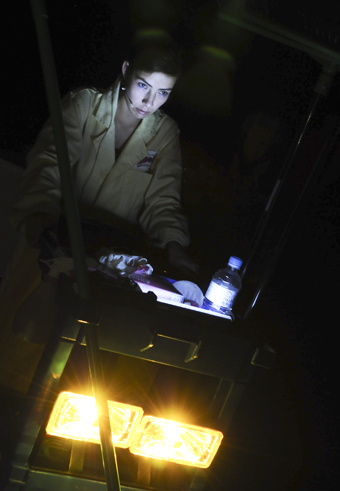
Claudia Escobar, Sweat, Branch Nebula
photo Heidrun Löhr
Claudia Escobar, Sweat, Branch Nebula
IT’S A GREAT THING THAT THE KIND OF THEATRE THAT IS BRANCH NEBULA’S SWEAT HAPPENS IN SYDNEY. DEMOCRATICALLY DEVISED, POLITICAL AND EMOTIONALLY CHARGED, SWEAT PERFORMS A CHALLENGE TO EXPECTATION AND CONVENTION.
However, Sweat is also a diluted dream of a Sydney Front (1986-1994) production: unsurprising considering that John Baylis, onetime Front member, is the dramaturg. The sharply confronting material sometimes demanded a more robust performative substance than these young performers could provide but Claudia Escobar, Marnie Palomares, Erwin Fenis, Ali Kadhim, Ahilan Ratnamohan and Hirofumi Uchino are courageous, committed and focused.
Escobar is especially potent. She opens the piece by welcoming us with a hospitality smile that matches her waiter’s uniform. In heavily accented English she asks us politely but firmly to leave and re-enter with more alacrity, as our first entrance was not sufficiently rhythmic or efficient. This is classic Front: casting the audience as performatively responsible. And not only responsible—but uncomfortable—as Escobar asks various audience members to remove pieces of her clothing. In the undoing of buttons, witness is made oppressor as she asks me directly, while lying near naked on the floor, to stop looking at her.
Escobar’s accented text set the political narrative as determinedly racial. As we gathered in uncomfortable clumps we stood accused—of leaving all the dirty tasks of a wealthy society to people with dark skin and foreign accents. These are people who have migrated into invisibility and voicelessness, where once, in their countries of origin, they were trained, educated and skilled.
This shameful narrative is the abiding and structuring force of Sweat. The piece veers from situations of tedium and degradation to displays of skill that reveal the hidden value of these ‘shadow’ people.
In the blackened and cavernous space cleaning trolleys become sentinels and aliens, careening beams of light into an atmosphere thick with despair and repeated words. These are perhaps the most densely theatrical moments, clothing the audience in nightmare, surrounding and engulfing us.
Then there is a falling away as we are herded into groups, each with a quadrant of space and a designated performer. The shadows are filled in with the individuality of capability, with back stories of soccer, hip hop, martial arts and contemporary dance. These practices are moved as markers of worth and dignity in a world that would make them silent and invisible. This Australian story must be told and it is important that Branch Nebula is telling it.
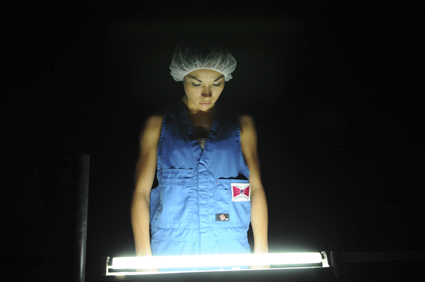
Marnie Palomares, Sweat, Branch Nebula
photo Heidrun Löhr
Marnie Palomares, Sweat, Branch Nebula
But who are they telling it to? Certainly not to the greedy bastards of industry who deserve the full accusatory force of Sweat. And despite the textually direct ‘you’ of these accusations, they sometimes appear limp. They don’t have the force of, say, the fully furious curse of Melvin van Peebles’ bag lady in Sweet Sweetback’s Badasssss Song (1971) wishing all our children turn into junkies and prostitutes. That iconic rant was fuelled by a quietly authentic ferocity that swept the audience up into it, crushing resistance. So, at times Sweat generated annoyance more than fury. Herded around the space, the generic passivity and meekness of the theatrical audience was not subverted but extended.
Contrastingly, Sweat performed the young nubile body; displayed, revealed and aestheticised. The bodies of these performers are rich with symbolic, physical and cultural capital—bodies bathed in admiration as they exhibit their skills: bodies rich with potential, capable of enacting power, bodies at odds with victimhood. What of the older migrant worker, like the 60 year-old Indian man picking up the garbage of teenagers on Town Hall Station? Where is his story?
Towards the end, Sweat’s ‘last supper’ scene invites 12 lucky audience members to put their heads through holes in a heavy plastic tablecloth that serves as a collective bib. A good thing, for it is about to get ugly. Serenely, two waiting staff pour water and wine, left arms tucked respectfully behind their backs. This sedate ritual segues into the serving of food as art: pineapple rings with a spoonful of peas and a ‘little boy’ frankfurter. Yellow, green and red are, at first, delicately dotted on white plates. But the service gets boisterous as the servings become ludicrously generous; speedy dollops of red tomato slurry are spooned onto overflowing plates and the table starts to swim with a melange of colour disgusting to eye and palate. Horrifyingly, one waiter starts to eat the scraps: the middle-class leftovers that sustain the oppressed. He disrobes and swims face first and naked down the centre of the table, his butt crack serving another unexpected course to the guests, these disciples of excess. The last touch is confetti, sprinkled liberally over the festivities, completing the festering mess, turning the party and the world of work upside down.
Sweat, Branch Nebula, director, co-creator Lee Wilson, designer, co-creator Mirabelle Wouters, noisician Hirofumi Uchino, performers, devisors Ahilan Ratnamohan, Ali Kadhim, Claudia Escobar, Erwin Fenis, and Marnie Palomares; Performance Space, CarriageWorks, Oct 19-30
RealTime issue #100 Dec-Jan 2010 pg. 25
© Pauline Manley; for permission to reproduce apply to realtime@realtimearts.net
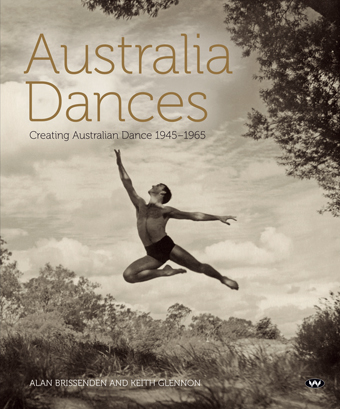
Australia Dances cover, Dancer, William Harvey
photo Walter Stringer, courtesy Wakefield Press
Australia Dances cover, Dancer, William Harvey
ALAN BRISSENDEN AND KEITH GLENNON’S AUSTRALIA DANCES, CREATING AUSTRALIAN DANCE 1945-1965 IS AN OBJECT AS MUCH AS A BOOK, AND A BEAUTIFULLY PRESENTED OBJECT AT THAT.
It does not demand to be read from cover to cover in sequence. If you follow the pages one after the other the dates, people and locations merge in a blur of numbers, names and dance titles. The detail is astounding, for example the authors list (what appear to be) all the possible name changes of companies and organisations throughout the period. But if you choose instead to wander through the amazing array of photographs and replications of wardrobe and set designs, dipping in and out when an association takes your fancy, you will be equally amazed at the writers’ attention to historical detail and avoid the vertigo.
Critical framing of dance in its social, political, economic and cultural context is not the intention of this book. There is a lot of who, what, where and a little bit of how but not a lot of why. Instead, the expressed intention of Australia Dances is to “share in building an awareness of a community of interests, stimulate the interchange of ideas, and provide a record of the exciting period when so much creativity was energising Australian dance.” This it does admirably.
There is, however, a sprinkling of ‘why-not’ as the authors offer up the occasional reflective commentary on the demise of companies and organisations and the lack of innovation in much early local dance (particularly ballet), along with the occasional critique of some of the work. It is interesting (read depressing) to discover the fledgling dance organisations in this period faltered and died one after the other, and rose again, and again, when more funds could be secured. (Reading through this replicated saga I was reminded that the resilience of Australian performing artists also has a history.) The authors also accuse companies like the Borovansky Ballet of not meeting their “obligation to contribute to the vitality of the art it represents.” A revival of old works might satisfy an audience but it “is a truism that no art form can progress and develop without experimentation.”
There are moments when local artists get an ever so gentle, but slightly acerbic ‘serve’. Words like “slight” are used to describe Petite Mozartiana (1939) by Borovansky and Garth Welch’s work for the fledgling Australian Ballet. Rex Reid’s choreography for Melbourne Cup (1960) is called “highly derivative” owing a large “debt” to Les Sylphides and Aurora’s Wedding. Although her creations have a “firmness of purpose and clarity of vision,” a dependence on “the improvisation of individual dancers […] together with her concern for asymmetry, led to a certain untidiness in some of Gertrud Bodenwieser’s ballets.”
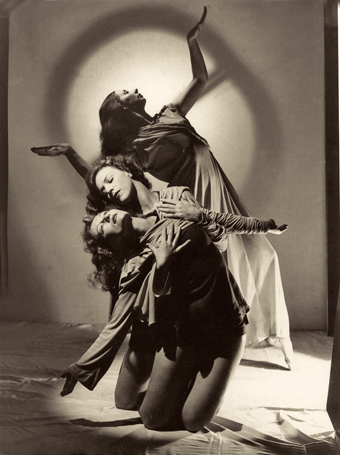
The Wheel of Life, 1945,
Bodenwieser Ballet
This book has had an incredibly long gestation period. As Alan Brissenden recalled at its launch in July: “We wrote the book during the late 1950s and early 1960s, when so much was happening in dance in this country.” Keith Glennon was responsible for collecting a lot of the material, travelling from state to state interviewing artists and writing follow-up letters on leads he’d acquired in the field. Asked how Glennon financed his trips, Brissenden recalled that “he hitchhiked a lot of the time. But when he got to Adelaide he didn’t want to face the Nullarbor, so he cabled a great-aunt in England for £50, and she sent it!” Brissenden left for England in 1960: “I had a contract in my pocket and [the book] was to be published in 1961; but a recession rolled in and put a stop to that.” When he returned to Australia he joined the English Department at Adelaide University and, with Glennon, updated the book and tried to get it published again, “but no one was interested.” The letters, photos, clippings and transcript “were stored in a garage” and when Keith Glennon died in 1983 his brothers donated the 22 archival boxes to the Barr Smith Library at Adelaide University and there it all sat until Alan Brissenden retired in 1994 and began to revise the manuscript yet again.
These two men were not only great collectors but also well-connected fellow travellers of the dance community. Glennon was a trained dancer, a theatre technician with JC Williamson and the founding administrator of the Mornington Island Dancers. Brissenden has an Order of Australia for services to the arts and is one of the country’s leading dance critics. They were aficionados. Between them they saw a lot of the work they describe here, and it is those moments when the ‘eye-witness’ nature of some accounts breaks through the stricter historiography that the value of this book is enhanced. We get great moments of description that can only come from being there, like this on Laurel Martyn’s Sentimental Bloke (1952): “To convey changes in time and provide atmosphere, the choreographer left dancers immobile when not immediately concerned in the action of a scene. This provided the ballet with a photo-album quality, clipped the incidents into tidy, page-like sequence, and yet blended them one into another so that there was a continuity of action. This buoyancy was carried through to the ballet’s conclusion; at the end the audience was involved as a wedding photographer, for the curtains opened and closed like a camera shutter on poses contrived by the bridal party.”
There are some oddities as well: the excellent description of the touring and the dancing of the Aboriginal Theatre (1963) is corralled under the title of “Ethnic Dance” and I also thought it odd that the Modern Dance section begins with a return to the Greeks. We move from them to the Romans, the early Christians, dance in the Middle Ages, the Renaissance and are swept on to Isadora Duncan and the early 20th century…all in three paragraphs. I also found the lack of contextual framing in the book a small frustration. Tantalising details of who-made-what-with-whom in a strange ballet like Terra Australis (1946) makes you wonder what it would have been like to be in the room as Tom Rothfield (who wrote the ‘book’), William Constable (décor), Esther Rofe (music) and Borovansky (choreographer) negotiated their way around the ballet’s construction and content. How did these people work together? Why did they make the work? Another interesting, unframed moment is the image of Robert Olup ‘blacked up’ as the “Negro” in Rex Reid’s The Night of the Sorceress (1962). Photographs such as this stimulate interest that is not satisfied in the text.
Generally Australia Dances offers the facts but does not spend much time unpacking or speculating about the meaning of the action in context and time. But, again, that is the intention of the book: to stimulate more research, to give scholars and students a place from which to begin. This publication does not do the work for us: its lack of detailed referencing means the location of much of the material remains ‘secret.’ But this will not bother everyone, and those who are inspired to burrow beneath what Australia Dances has to offer will still need to do the work, scratching at this book’s beautiful, polished, inspirational surface to reveal the stories that lie beneath.
Alan Brissenden and Keith Glennon, Australia Dances, Creating Australian Dance 1945-1965, Wakefield Press, Adelaide, 2010
RealTime issue #100 Dec-Jan 2010 pg. 26
© Amanda Card; for permission to reproduce apply to realtime@realtimearts.net
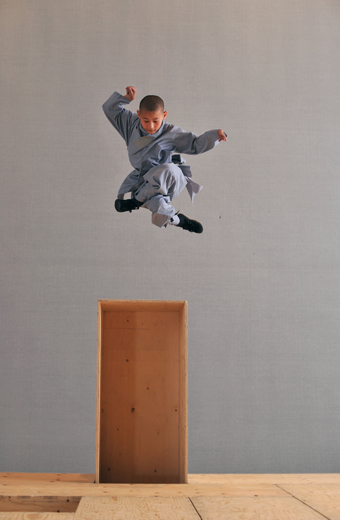
Sutra
photo Hugo Glendinning, courtesy Sydney Opera House
Sutra
AFTER A PROMISING START IN 2009, THIS YEAR’S EDITION OF SPRING DANCE AT THE SYDNEY OPERA HOUSE EMPHATICALLY CONFIRMED THE FESTIVAL MEANS BUSINESS AND IS HERE TO STAY. IT HAS, IN FACT, THE POTENTIAL TO BECOME ONE OF THE MOST IMPORTANT AND STIMULATING DANCE FESTIVALS IN THE COUNTRY. CURATED BY THE OPERA HOUSE’S HEAD OF THEATRE AND DANCE, WENDY MARTIN, SPRING DANCE 2010 IMPRESSED WITH ITS ECLECTIC DISPLAY OF WORKS BY A WIDE RANGE OF NATIONAL AND INTERNATIONAL DANCE PRACTITIONERS AND OFFERED SOMETHING FOR PRACTICALLY EVERY TASTE.
sidi larbi cherkaoui, sutra
A box-office success story since its premiere at Sadler’s Wells in London in 2008, Sutra is a collaboration between celebrated Belgian choreographer Sidi Larbi Cherkaoui and 17 Buddhist monks from the original Shaolin Temple in China. The pared down set consists of 21 wooden boxes designed by Turner Prize-winning UK sculptor Antony Gormley.
At the beginning of Sutra, Cherkaoui and a boy monk sit on top of one of the boxes placed at the edge of the stage, hunched over a miniature model of the set. They reconfigure the model boxes into various patterns and forms, foreshadowing what the audience is about to witness. Soon enough, the two are sucked into the life-size world onstage where the kung fu-trained warrior monks reign supreme, engaging in a dizzying fusion of whirling combat and meditative stillness. Powerful kicks alternate with daring backflips and spectacular jumps off the man-sized boxes.
Suddenly the monks execute Tai Chi-style movement sequences with great poise and grace. The boxes are dragged, lifted and heaved into an array of configurations that are as quickly destroyed as they are constructed. The multi-functionality of the boxes allows them to transform into everything from coffins, hiding spots and shelves to bunk beds, lotus flowers and skyscrapers— ideal for the monks to hide in, spring from, balance on or topple like dominoes.
As for Cherkaoui, during the first half of this East-meets-West extravaganza, he appears to be an onlooker, a visitor in a foreign community drawn into its microcosm. It is not until later in the piece that he engages in more direct interactions with the monks, such as a breathtaking dance-off, displaying his own extraordinary flexibility that at times takes on near-contortionist dimensions. For all its action-packedness, Sutra is infused with a beautifully measured humour often stemming from the interactions between Cherkaoui and the boy who acts like a liaison between him and the monks. This is a powerfully poetic, deeply human work. It is easy to see why it has attracted more than 100,000 people to performances all over the world. (See also Douglas Leonard’s review.)
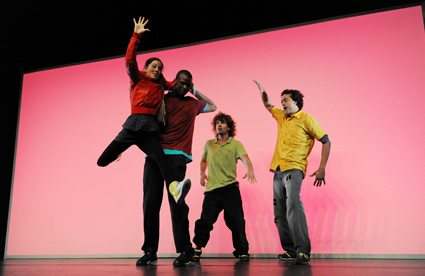
Asphalte
photo Ian Bird, courtesy Sydney Opera House
Asphalte
asphalte
So far, French choreographer and dancer Pierre Rigal has been known to Sydney audiences only through his intricately structured solo creations performed in a highly physical, almost acrobatic movement style. In Asphalte, he joins forces with five non-professional street dancers whom he selected during auditions in Paris in 2009. The youthful energy and commitment the hip-hop artists bring to the work is infectious and one of its biggest assets. They break, pop, lock and krump, like urban warriors, through a series of semi-narrative scenarios depicting modern street life.
As often is the case with hip-hop dancers, the physical feats seem to defy the laws of nature and perceived anatomical restrictions. Individual body parts are isolated, as if with a life of their own, moving in sharp angles one moment and dripping with liquidity in the next. Asphalte is set against a giant light box that glows in ever-changing colours, bright and saturated. The dancers are often silhouetted which makes them appear like comic-strip characters. As the work progresses, humanity is further contested as scenarios turn more absurd and even monstrous. Bodies get ‘blown up’ and deflated like balloons, fingers attack a dancer’s head like leeches, shoot-outs are simulated. The movement becomes increasingly machine-like, transforming the dancers into strangely deformed creatures battling urban reality.
Asphalte’s colourful pop-art aesthetic and the sophisticated lighting design make this a beautiful, positively slick production. The explorations of modern street life often border on the gimmicky, however, and the piece’s structure becomes predictable after a while, with each of the dancers executing a solo and then being joined by the group in some sort of confrontation, sometimes playful, sometimes latently violent. Asphalte is nonetheless a highly entertaining dance work, attracting audiences who might not usually attend contemporary dance performances.
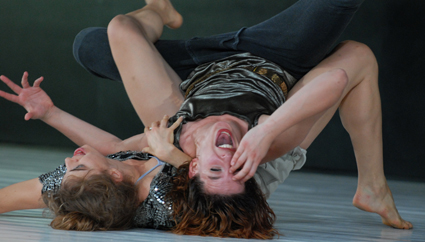
Singular Sensation
courtesy Sydney Opera House
Singular Sensation
singular sensation
Singular Sensation marks the welcome Australian debut of Israeli choreographer Yasmeen Godder. Together with her five dancers, Godder explores how, in a world characterized by relentless activity and overstimulation, physical experiences become more and more extreme in order to register on the increasingly numbed mental scale of sensation. Dressed like oversexed teenagers, in mini skirts and tight pants and with fake red finger nails, the dancers strut the stage, hell-bent in their search for thrills. Self-consciously, they look around to see if they are being watched. Real interactions seem to have become impossible and are doomed to fail, drowning in dysfunction. This futility is reflected in the movement language. Apart from half-heartedly executed lifts and fleeting moments of synchronized movement, there seems to be no dance left in the dancers. Instead they slap themselves, stick their tongues out, flutter their eyelids and grimace wildly. They smear their bodies with green paint and red jelly and wrap their heads in pants and their faces in clingwrap. Their insecurities end in self-obsession that prevents any sense of release. Their actions might become more random and messy, but certainly no more debauched or wild. Admittedly, this makes for rather bleak viewing. What is impressive about Singular Sensation, though, is that Godder sticks to her guns and resists trying to make the work palatable. Her conceptual rigour is matched by the physical commitment of her dancers.
Quite different from crowd pleasers like Sutra and Ashphalte, Singular Sensation is not for everyone, but its inclusion in Spring Dance was crucial. It is vital that Australian audiences are not only exposed to international hits but are given the opportunity to discover new and important dance practitioners whose work has not previously found its way to our shores. I hope Spring Dance will continue with its forward thinking programming.
Spring Dance 2010: Sutra, director, choreographer Sidi Larbi Cherkaoui, visual creation, design Antony Gormley, music Szymon Brzóska, performers Sidi Larbi Cherkaoui and Shaolin monks, Concert Hall, Sept 16-19; Asphalte, conception, choreography, lighting Pierre Rigal, set, lighting Frédéric Stoll, Playhouse, Sept 21-26; Singular Sensation, concept, direction, choreography Yasmeen Godder, The Studio, Sept 14-19; Sydney Opera House, Aug 31-Sept 26
RealTime issue #100 Dec-Jan 2010 pg. 27
© Martin del Amo; for permission to reproduce apply to realtime@realtimearts.net

































































































